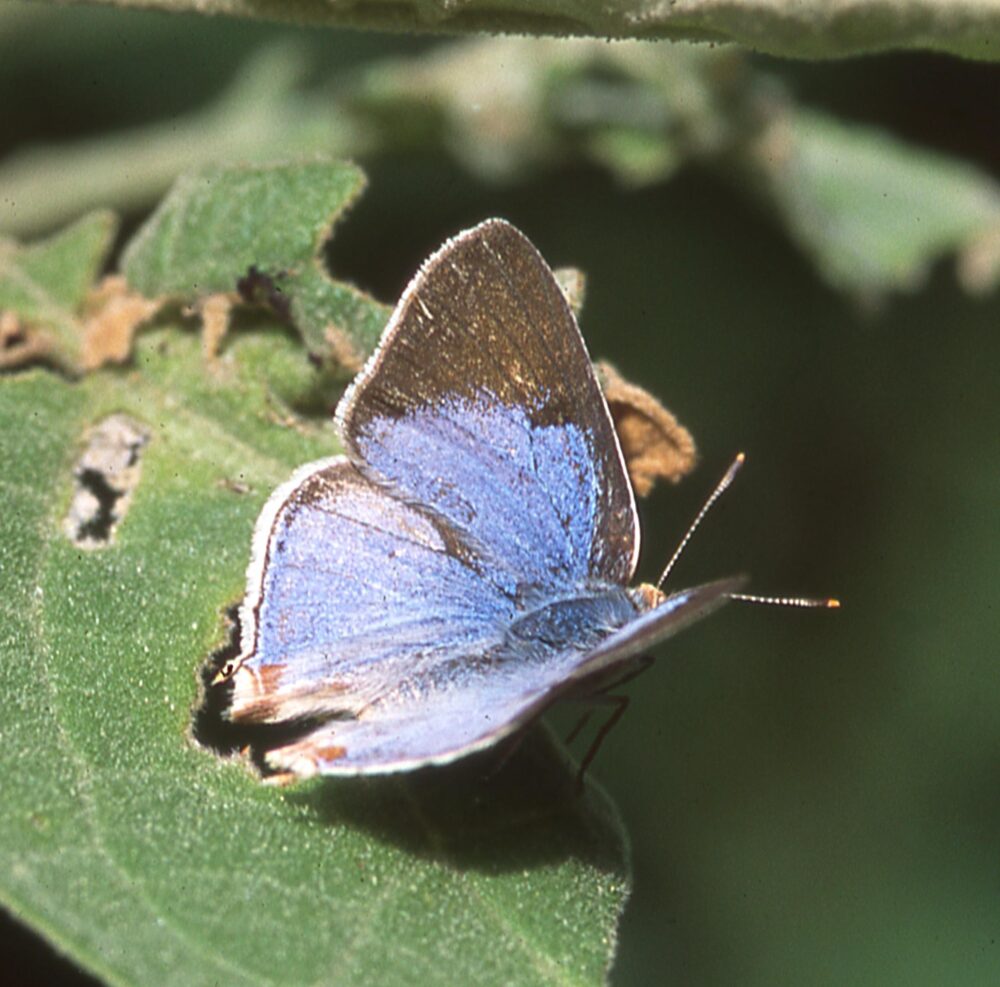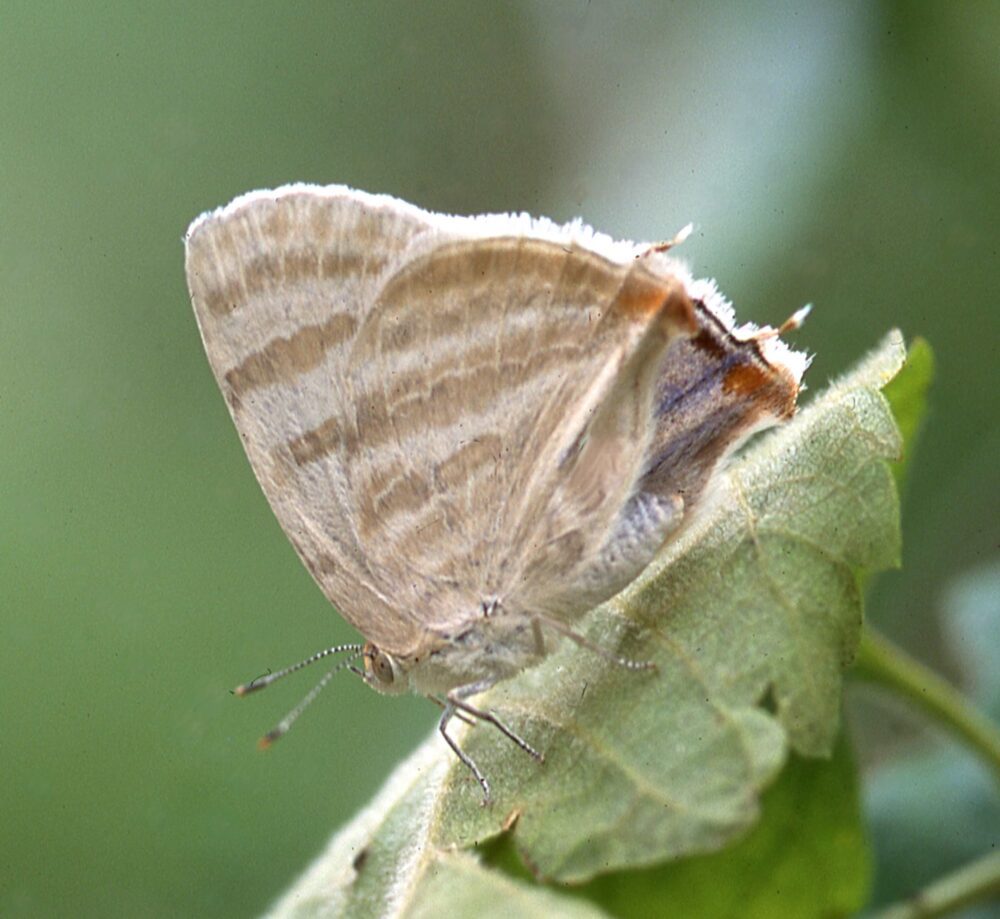by Steven J. Cary and Michael E. Toliver (updated May 13, 2022)
The Gossamerwings (Lycaenidae). New Mexico has more than 50 Lycaenids in three subfamilies: Coppers, Hairstreaks and Blues. All are small, but many have bright colors or intricate patterns. Because of narrow ecological needs, finding members of this group can be both challenging and rewarding. During immature stages, most Lycaenids exhibit mutualistic relationships with ants, called myrmecophily.
The Hairstreaks (Lycaenidae: Theclinae). Hairstreaks embody beauty accentuated by small stature and heightened by the detective work often required to track them down. They reward the effort by presenting easy photographic targets of their undersides. Most will not reveal uppersides when perched. Our 27 species in Subfamily Theclinae, all small, vary from dull to dazzling.
- Colorado Hairstreak (Hypaurotis crysalus) Hypaurotis grunus
- Great Purple Hairstreak (Atlides halesus) Atlides halesus corcorani
- Red-lined Scrub-Hairstreak (Strymon bebrycia)
- Mallow Scrub-Hairstreak (Strymon istapa)
- Tailless Scrub-hairstreak (Strymon cestri)
- Gray Hairstreak (Strymon melinus) meinersi, Strymon melinus franki
- Leda Ministreak (Minstrymon leda) Gray Ministreak (Ministrymon azia), Vicroy’s Ministreak (Ministrymon janevicroy), Clytie Ministreak [Ministrymon clytie
- Thicket Hairstreak (Callophrys spinetorum) Callophrys spinetorum millerorum
- Juniper Hairstreak (Callophrys gryneus siva) castalis
- Brown Elfin (Callophrys augustinus) Callophrys augustinus annetteae
- Desert Elfin (Callophrys fotis)
- Hoary Elfin (Callophrys polios obscurus)
- Henry’s Elfin (Callophrys henrici solatus)
- Western Pine Elfin (Callophrys eryphon) Callophrys eryphon fusca
- New Mexico Hairstreak (Callophrys mcfarlandi) New Mexico Hairstreak
- Xami Hairstreak (Callophrys xami)
- Sheridan’s Hairstreak (Callophrys sheridanii) Callophrys sheridanii sacramento
- Bramble Hairstreak (Callophrys affinis) apama, homoperplexa, sacramento
- Silver-banded Hairstreak (Chlorostrymon simaethis sarita)
- Arizona Hairstreak (Erora quaderna sanfordi)
- Behr’s Hairstreak (Satyrium behrii crossi) Callipsyche
- Coral Hairstreak (Satyrium titus) watsonii, immaculosus, carrizozo
- Poling’s Hairstreak (Satyrium polingi) Satyrium polingi organensis
- Oak Hairstreak (Satyrium favonius violae)
- Ilavia Hairstreak (Satyrium ilavia)
- Soapberry Hairstreak (Satyrium alcestis) Satyrium alcestis oslari, Phaeostrymon
- Striped Hairstreak (Satyrium liparops aliparops)
- Banded Hairstreak (Satyrium calanus godarti)
- Sylvan Hairstreak (Satyrium dryope itys) Satyrium dryope putnami, Sylvan Hairstreak, Satyrium sylvinus
- Hedgerow Hairstreak (Satyrium saepium provo)
- Creamy Stripe-Streak (Arawacus jada)
Hypaurotis crysalus (W. H. Edwards, 1873) Colorado Hairstreak (updated August 23, 2024)
Description. Hypaurotis crysalus is not merely large and striking for a hairstreak, it also is vivid purple above with orange patches. It is silver-gray below, with a superb false head to distract bird predators. Range and Habitat. This butterfly lives in oak groves from the central Rockies (UT,CO,NM,AZ) south to the Mexican Sierra Madre. In New Mexico it occupies our major uplands with the host, usually 6500 to 9000′(counties: Be,Ca,Ci,Co,Gr,Li,LA,MK,Mo,Ot,RA,Sv,SJ,SM,SF,Si,So,Ta,To,Un). Life History. Colorado Hairstreak larvae eat foliage of Gambel’s Oak (Quercus gambelii; Fagaceae). Winter is passed as an egg. Flight. Single-brooded, adults fly in middle to late summer. New Mexico observations span June 12 through September 17, peaking during July and August; never-mind one oddball sighting from April 4, 2014. Adults bask dorsally in the morning, wings at 45° angles. They disappear for mid-day, then become most active in late afternoon and early evening. Males patrol casually about the oak canopy. Adults visit moist earth, but rarely come to nectar. Comments. We have the nominate subspecies in New Mexico. The Colorado Hairstreak is one of two members of the genus Hypaurotis; the other is the Golden Hairstreak, Hypaurotis grunus. That species approaches the NM border in the Pinaleño Mountains (Graham County, AZ). Its larval foodplant is suspected to be Canyon Live Oak, Quercus chrysolepsis, a plant which also closely approaches our southern border. Any stands of this oak found in New Mexico should be checked for Golden Hairstreaks.
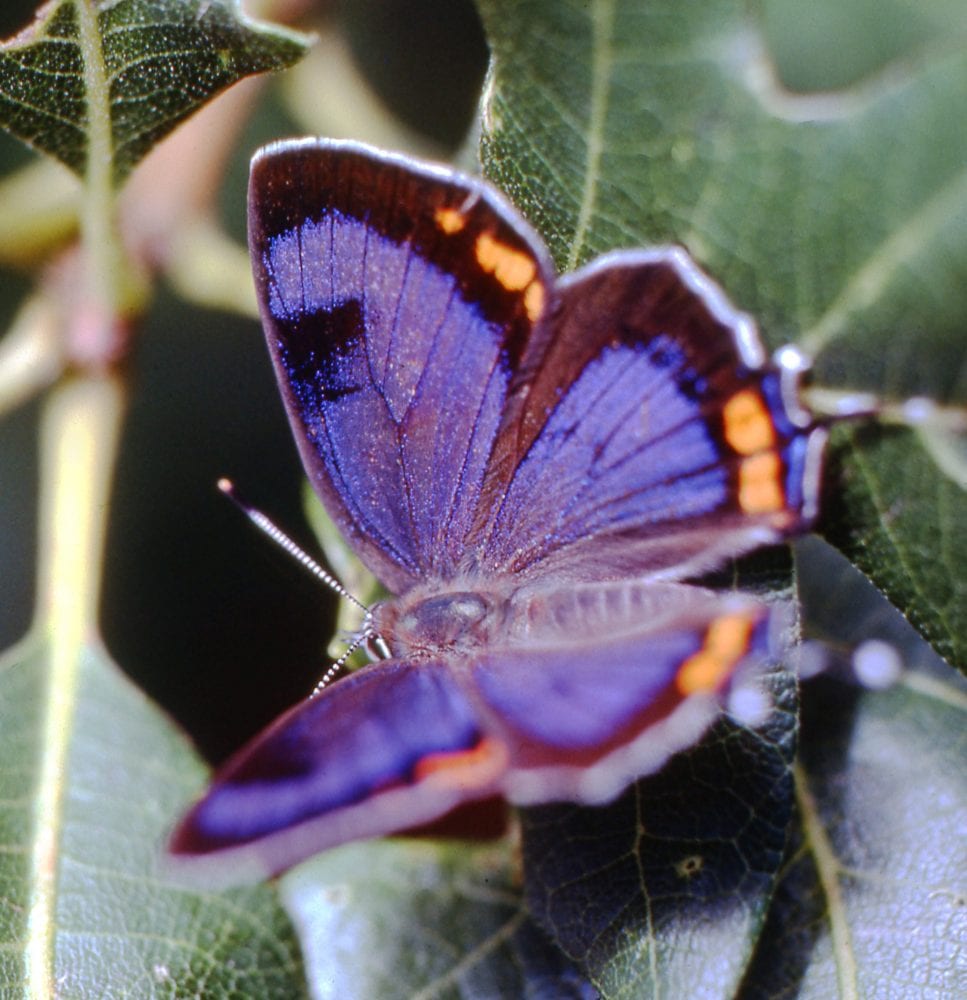
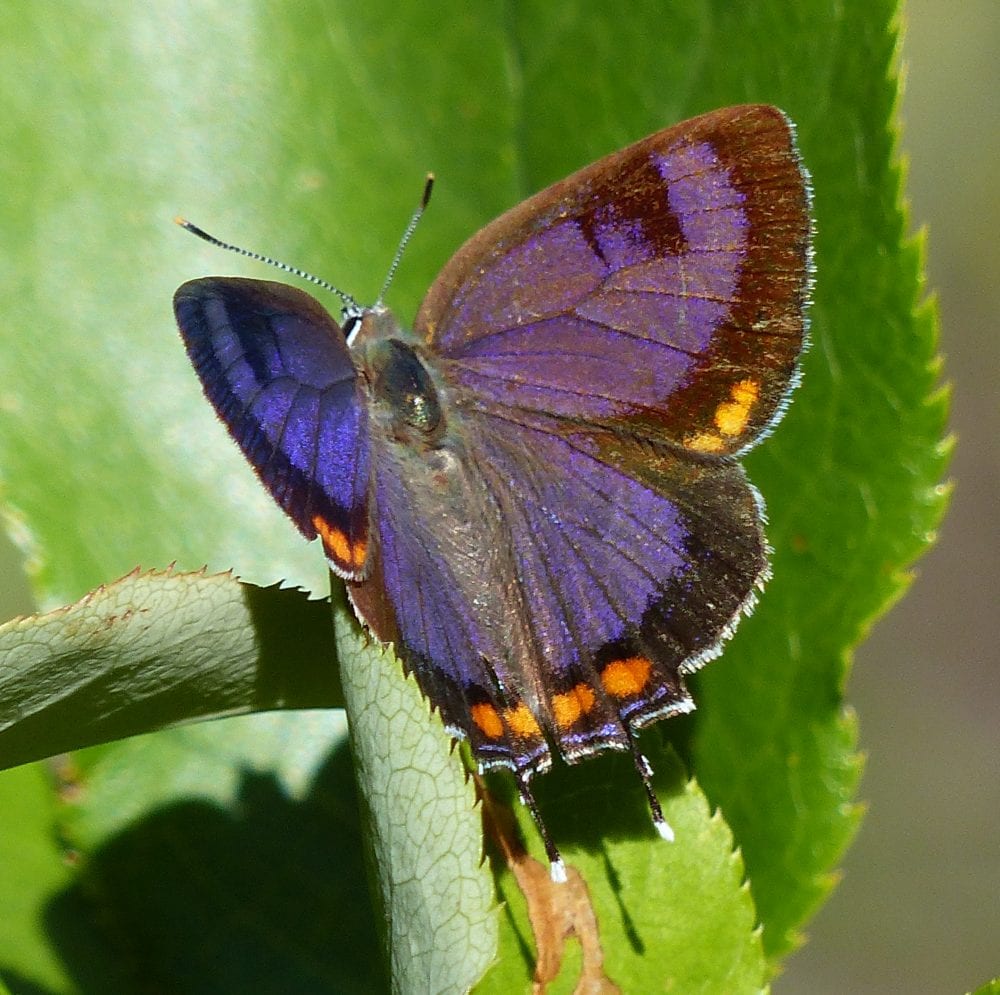
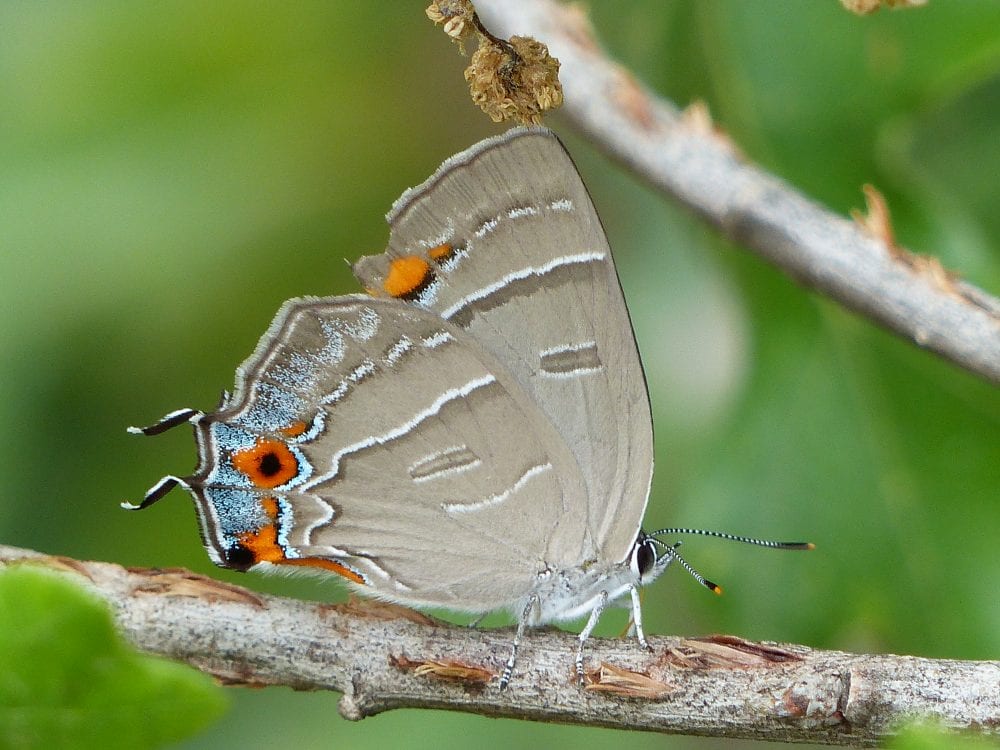
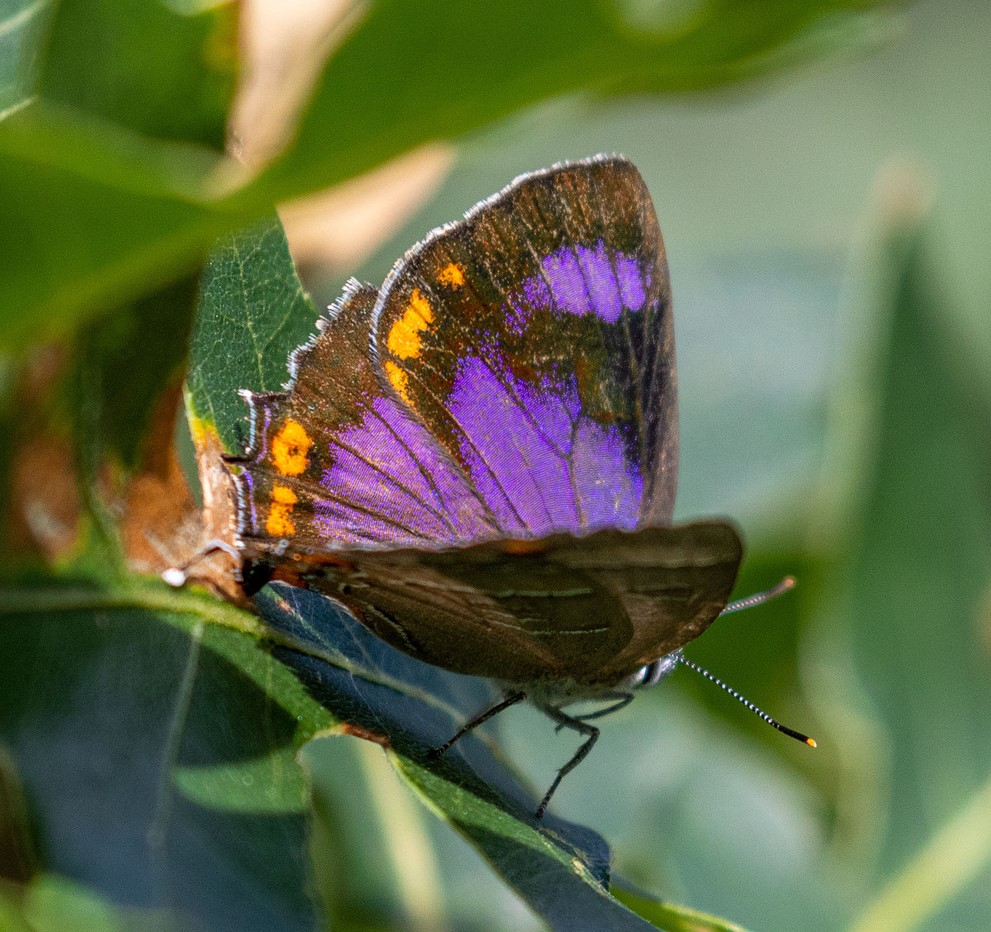
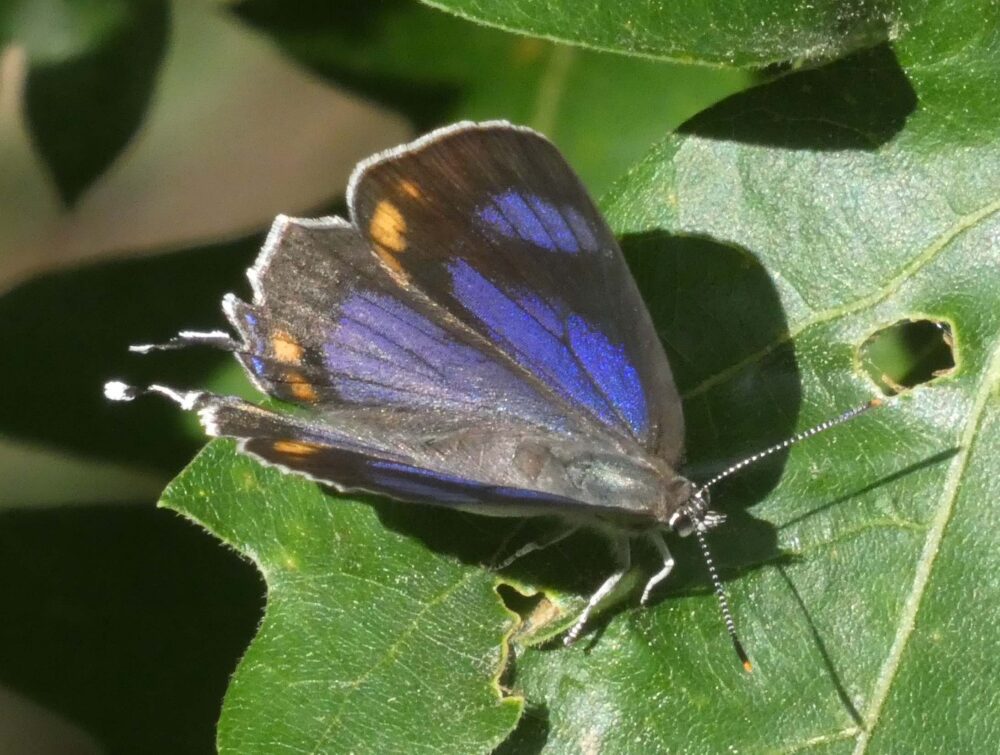
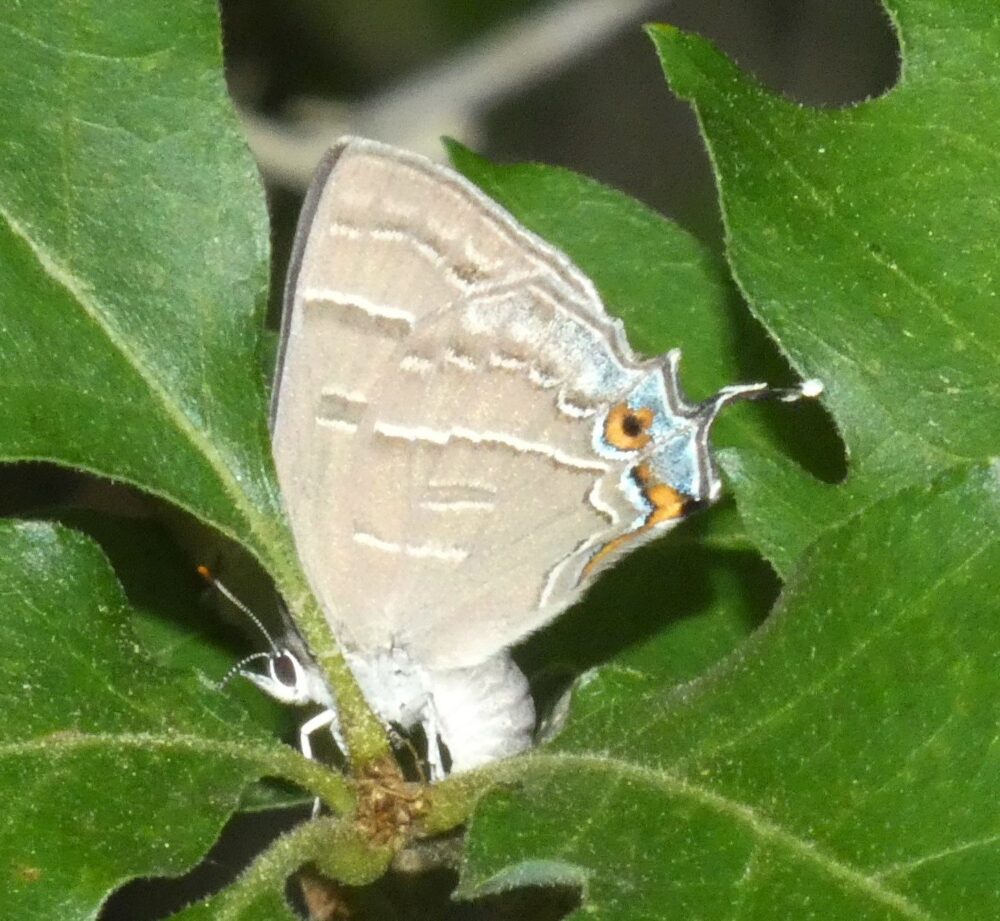
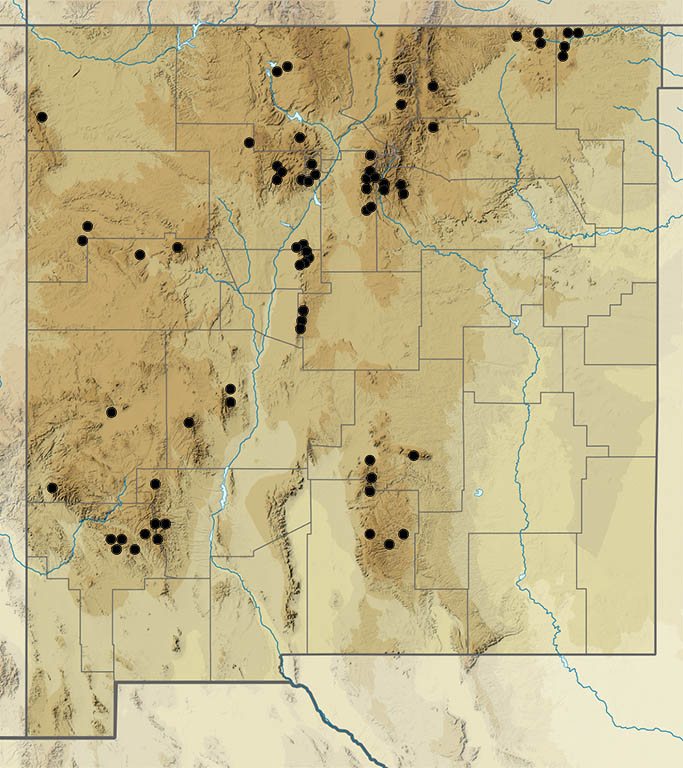
Atlides halesus (Cramer 1777) Great Purple Hairstreak (updated March 31, 2022)
Description. Despite the common name, Purple Hairstreak is intense, iridescent blue above and jet black below. Vivid red and orange patches decorate the body and wing bases. Hindwing tails are iridescent green-gold when fresh. Range and Habitat. Atlides halesus lives in much of the southern US and Mexico. In New Mexico it occupies Upper Sonoran life zones up to 7000’ elevation (all counties but Cu,DB,Ha,Le,Mo,Qu,Ro,Un). Life History. Larvae eat broad-leaf mistletoes (Phoradendron spp.; Loranthaceae) which parasitize deciduous trees and junipers. Flight. Records from February 4 to November 29 indicate two broods in central New Mexico and three farther south. Males establish and defend territories on hilltop treetops. Both sexes frequent flowers and, occasionally, damp sand. Comments. New Mexico is in the blend zone between the nominate race of the southeastern US and southwestern subspecies Atlides halesus corcorani Clench 1942. Pelham (2022) indicates ssp. corcorani occurs as far east as Tulsa, OK.
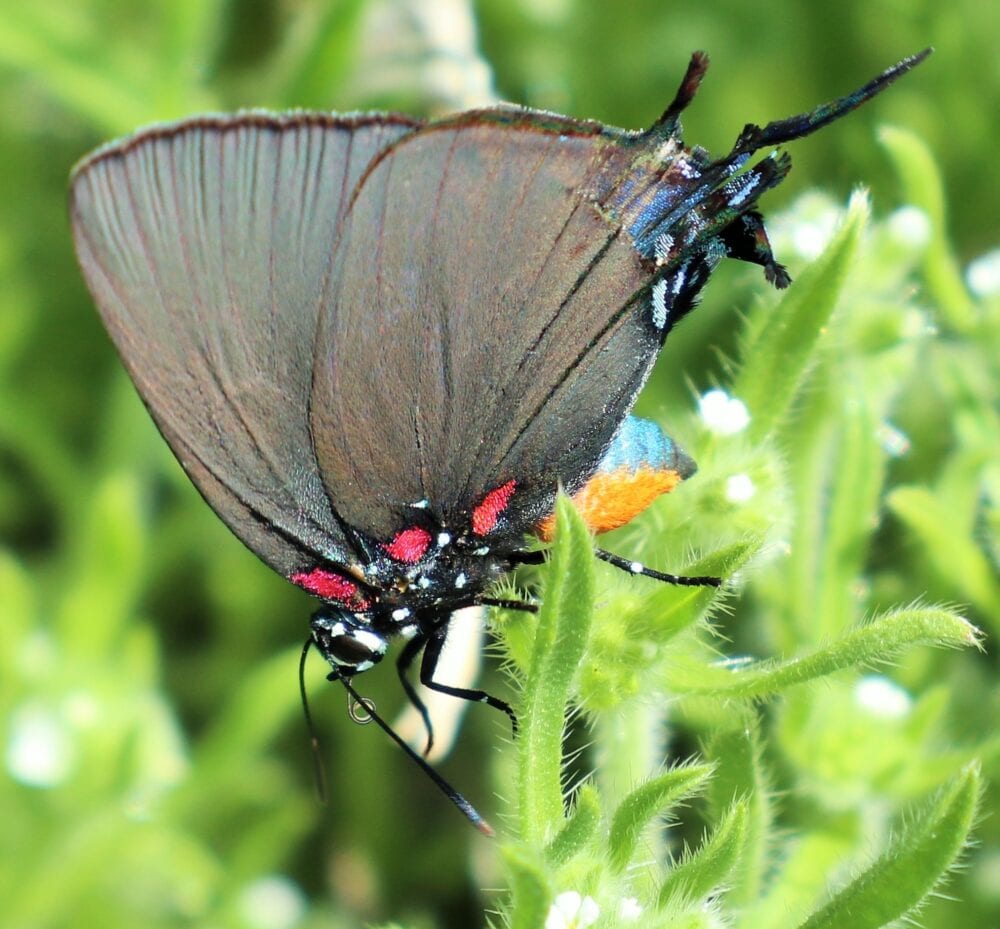
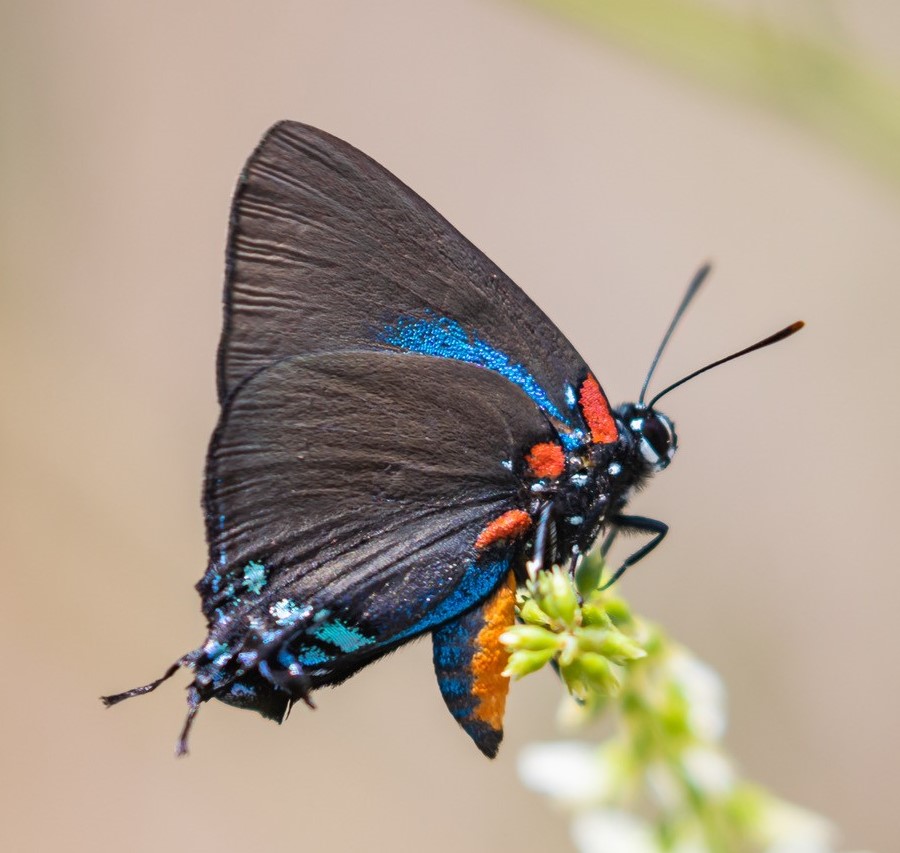
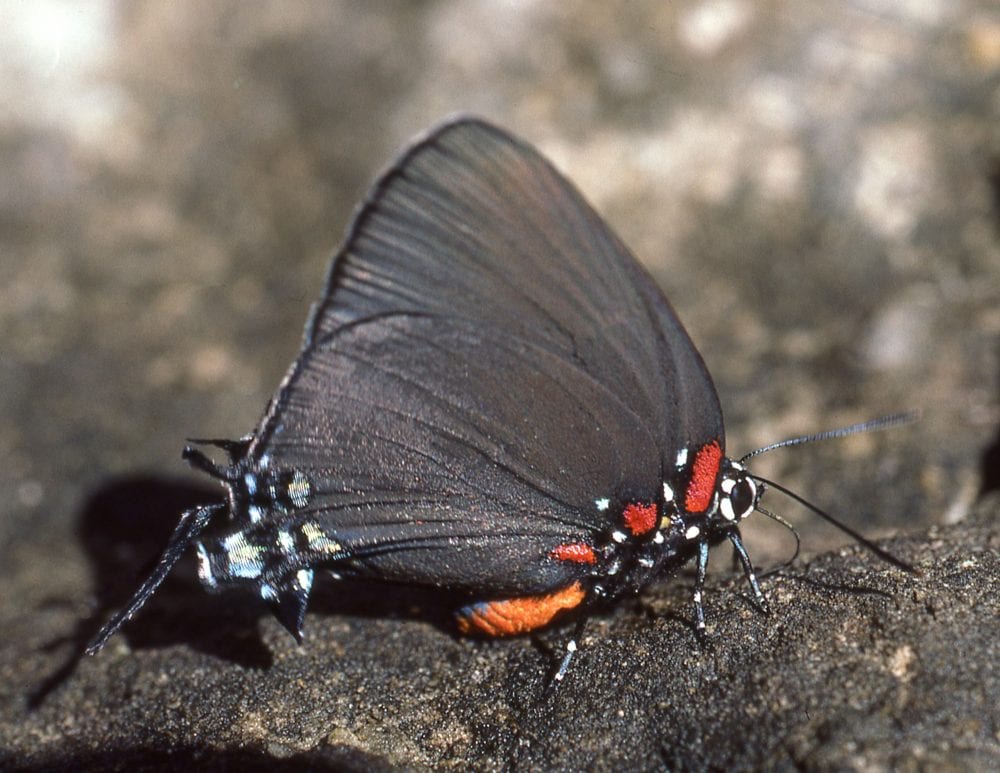
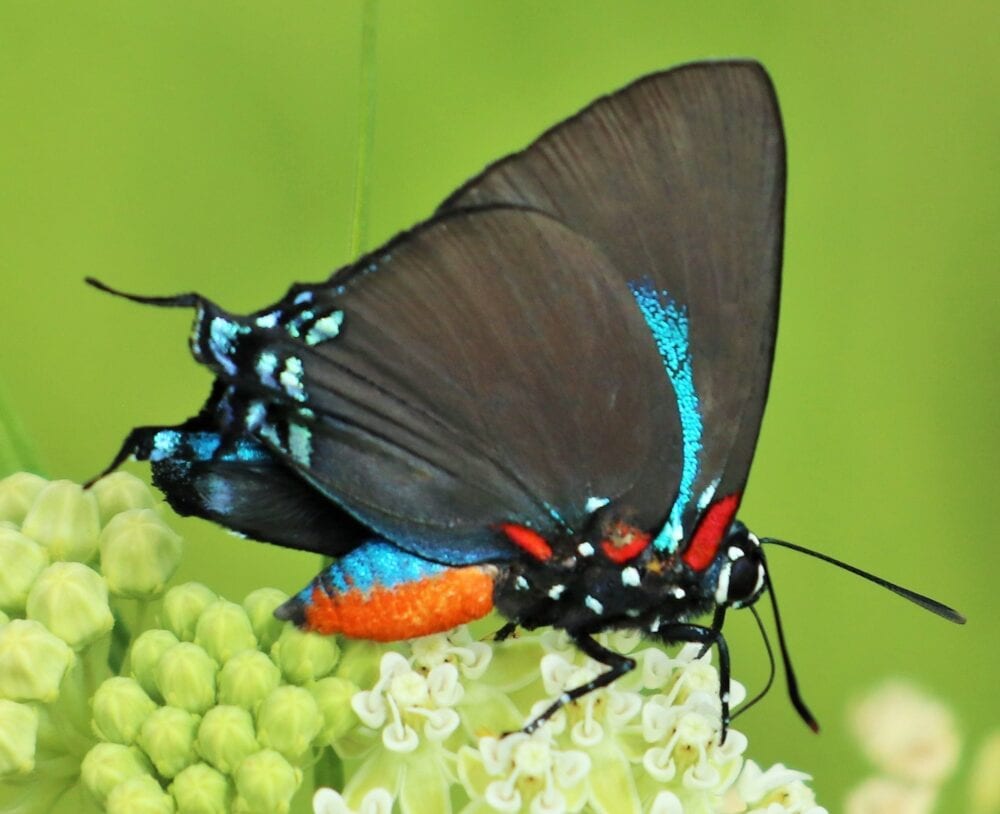
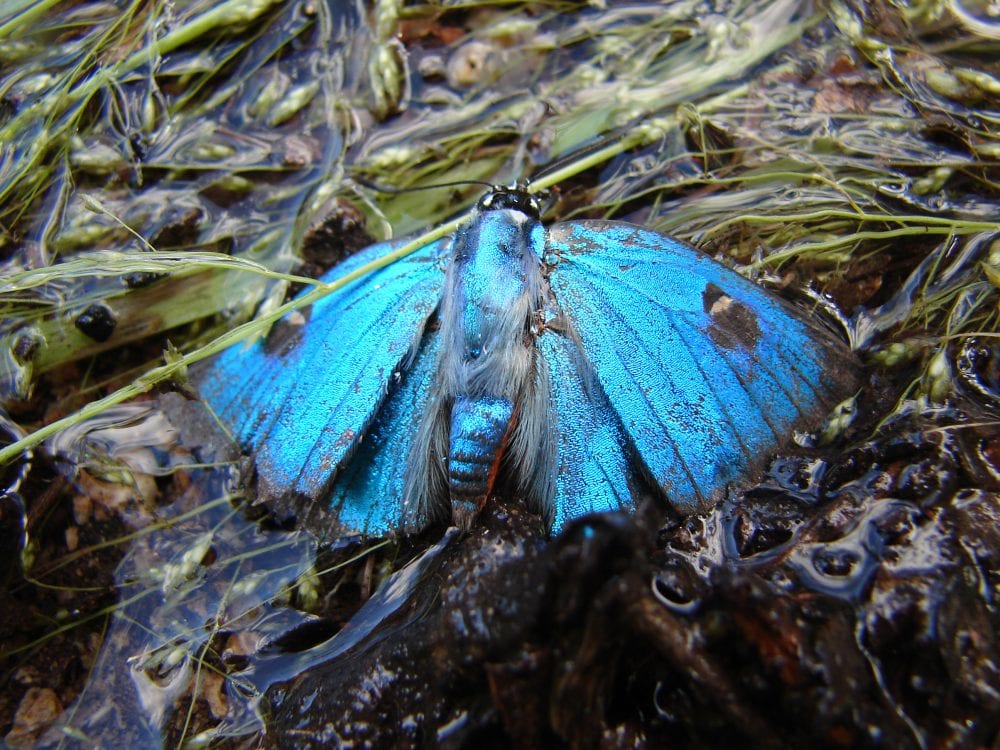
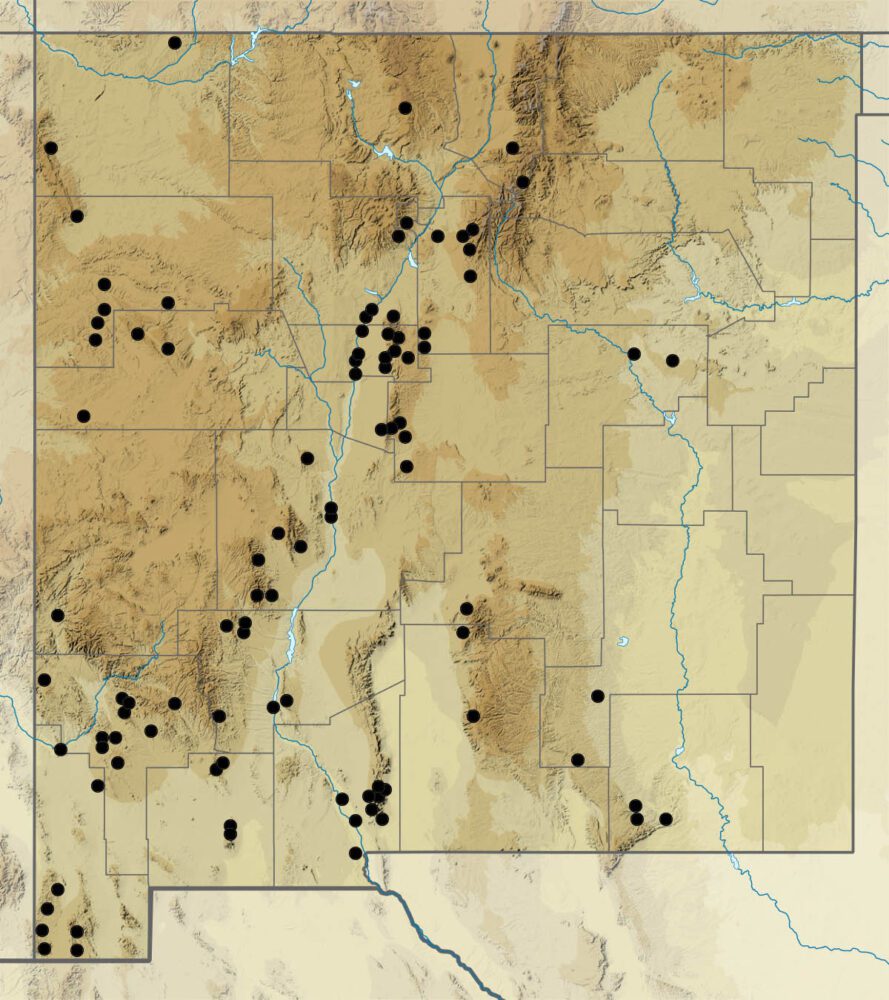
Strymon bebrycia (Hewitson 1868) Red-lined Scrub-Hairstreak (added May 4, 2024)
Description. Red-lined Scrub-Hairstreak closely resembles its abundant cousin – the Gray Hairstreak – and for that reason may be overlooked and thus more common than the few US records imply. The upper surface of the male is gray. There are two dark spots above the single “tail” on the hindwing. Unlike the Gray Hairstreak, there is no obvious orange lunule above the largest of those dark spots (there may be a trace of orange in some individuals). A couple of marginal white lines appear below the dark spots. The upper surface of the female is also gray, but the hindwing has large areas of white, quite different from female Grays. There is an orange lunule above the largest dark spot above the “tail”. Beneath, the male Red-lined is a darker gray (more brownish) than the male Gray, and the submarginal line of black dashes is edged with red on the inside towards the body, giving the Red-lined its name. Females are a lighter gray underneath, more like the Gray, but the gray is somewhat “pebbly” in appearance instead of presenting a smooth appearance. There is much more white scaling on both wings than one would see in the female Gray. Range and Habitat. The normal range is from Central America through Mexico. There are ten records from Arizona (Bailowitz & Brock 2021), including one historical record from Cochise County. There is also an historical record from El Paso County, Texas. Our single historical record is from Hidalgo County, in the Peloncillos. Life History. Larvae of Red-lined Hairstreaks feed on Balloon Vine (Cardiospermum halicacabum and corindum). Oviposition on Cardiospermum corindum was observed in southern Arizona, and a larva was recovered (Bailowitz & Brock, 2021). Flight. In its native habitat, Red-lined Hairstreak flies year-round. Arizona records occur in the late spring, August, and October and November, indicating two or three broods. Comments. There is one unverified report of S. bebrycia from Clanton Draw, Peloncillo Mts., Hidalgo Co., NM. Cardiospermum plants should be examined for larvae of this species, and any “Gray” hairstreaks from southern New Mexico should be closely examined to determine if any are Red-lines. We want photos in nature of this terrific little creature. If you have some to share, we will give you all the credit.
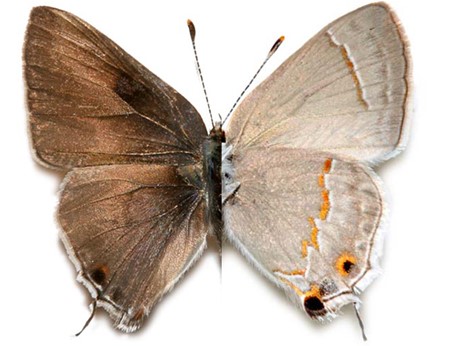
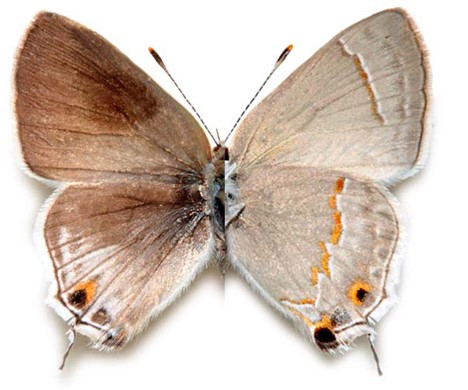
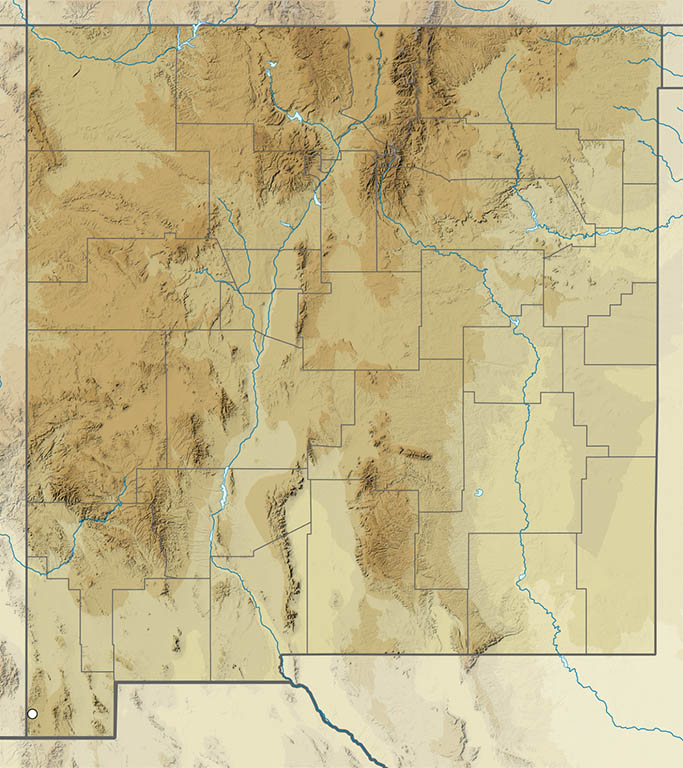
Strymon istapa (Reakirt [1867]) Mallow Scrub-Hairstreak (updated March 28, 2022)
Description. The combination of gray ground color and two basal spots on the VHW should separate this species from any others one might encounter. The tails are short. The dorsal surface is brownish gray, though (like most hairstreaks) you’re most likely to see it with wings closed. Range and habitat. This insect makes Mexico its home range, but it does stray with some regularity into extreme southwestern US from California to the lower Rio Grande Valley in south Texas. In New Mexico it is but a rarely seen stray along the border, where we have few observers. Kilian Roever found one along SR 338 south of Animas (county: Hidalgo) on October 23, 2006. Life history. Larvae eat plants in the Mallow family and seasonal breeding is not out of the question, but there is no evidence that Strymon istapa can survive our winters, so we expect it only as an occasional stray. In SE AZ, eggs and larvae have been found on Sphaeralcea and Waltheria detonsa. Flight. Mallow is multiple brooded in its native habitat, and Arizona observers find it in all months of the year (Bailowitz and Brock, 2022). However, NM observers would probably have most luck finding this rare stray in the fall. Comments. Since males hilltop, like some other hairstreaks, observers along our southern border might find this species in such situations.
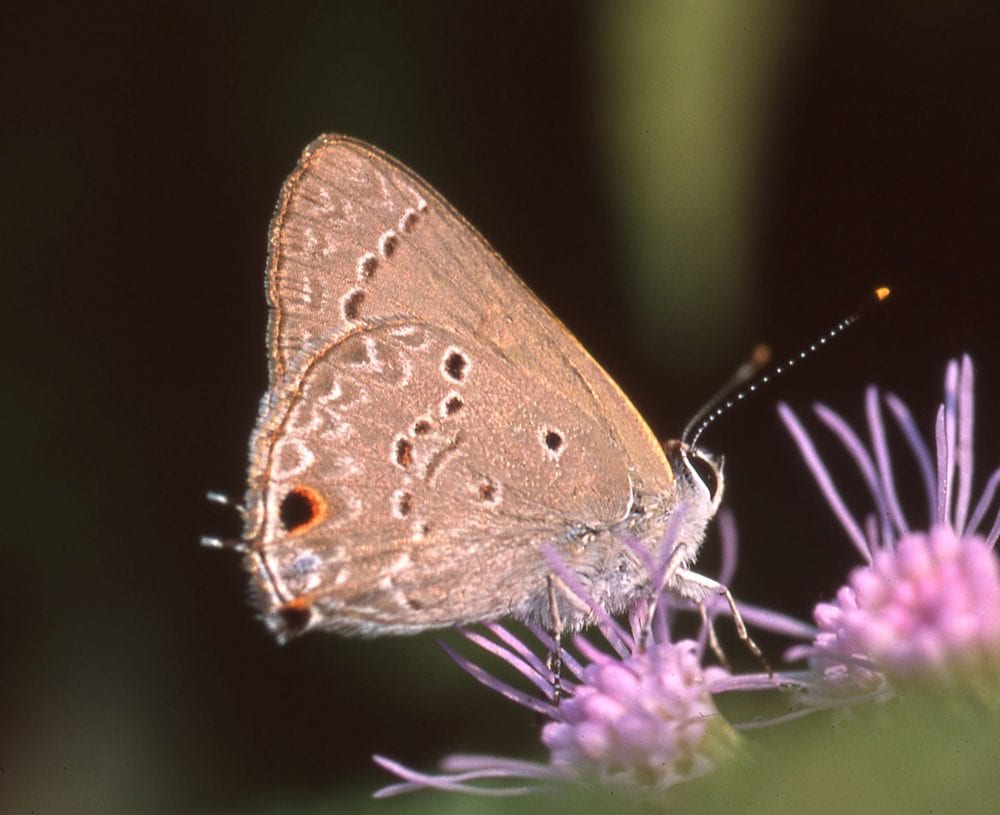
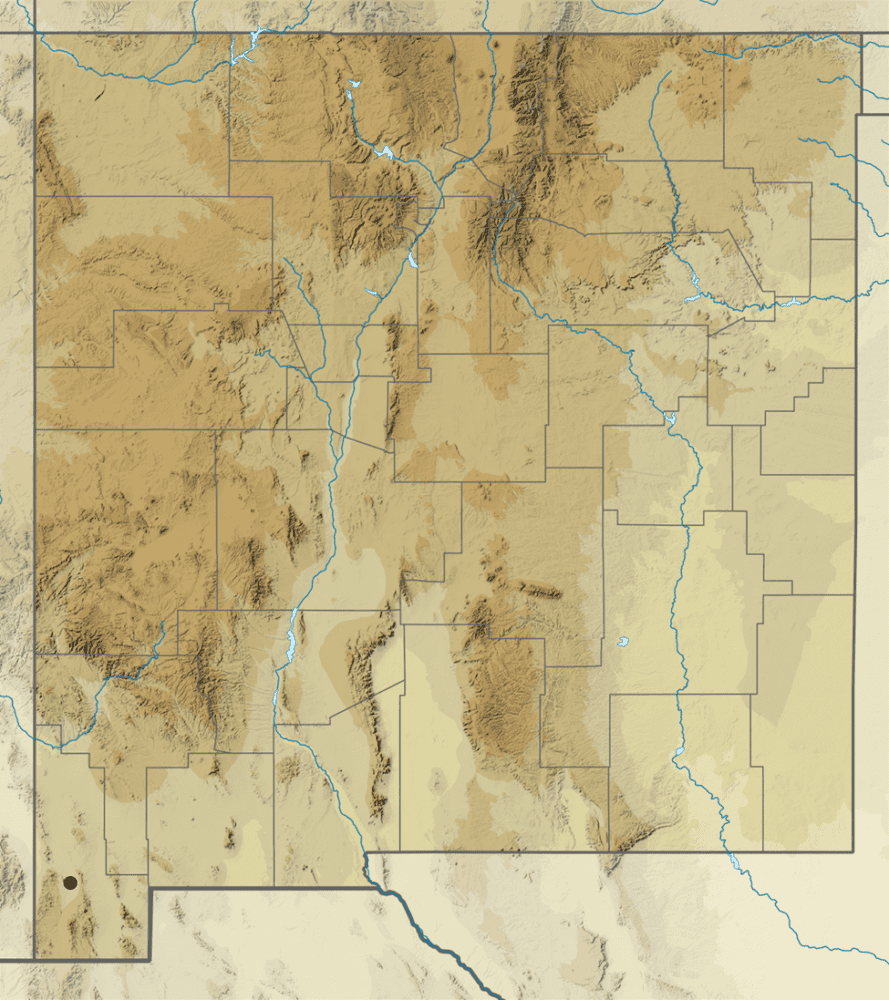
Strymon cestri (Reakirt [1867]) Tailless Scrub-Hairstreak (updated March 31, 2022)
Description. In addition to its lack of tails (unusual for hairstreaks), the VHW pattern of mottled brown and gray and the dark spot on VHW margin is sufficient to distinguish this rare butterfly. Range and habitat. This insect is one of a group of subtropical scrub hairstreaks that, within the US, are most frequently seen in the lower Rio Grande valley of south Texas. They all wander to some extent, but they are inconspicuous, frequent desert hilltops which humans rarely visit, and so may be more widely distributed than records indicate. There are 12 records from SE AZ (Bailowitz & Brock, 2022). Life History. Nothing is known of the life history of this animal. Certainly, that is the key to learning about its status in NM. Flight. Our records are from May and June. Bailowitz and Brock (2022) report 2 flights in SE AZ; May and July – October. They note that the species seems to be increasing there. Comments. Strymon cestri is included in the New Mexico butterfly fauna by virtue of two recent sightings. The author photographed a worn male in the eastern foothills of the Black Range (Sierra County) in mid-afternoon on May 11, 2016. It was hilltopping vigorously about a small juniper, on a summit of 6167 feet, in competition with a more dominant Atlides halesus. Most recently, Matt Brown found a single Strymon cestri nectaring at Bear Trap Campground in the San Mateo Mtns. (Socorro County) on June 18, 2020. One sighting can be dismissed as a fluke. The more recent sighting now makes a person wonder . . . is Strymon cestri already a breeding resident in southern New Mexico? Did it sneak in under the border radar, so to speak, and set up camp in New Mexico’s part of the Rio Grande Valley? Time will tell.
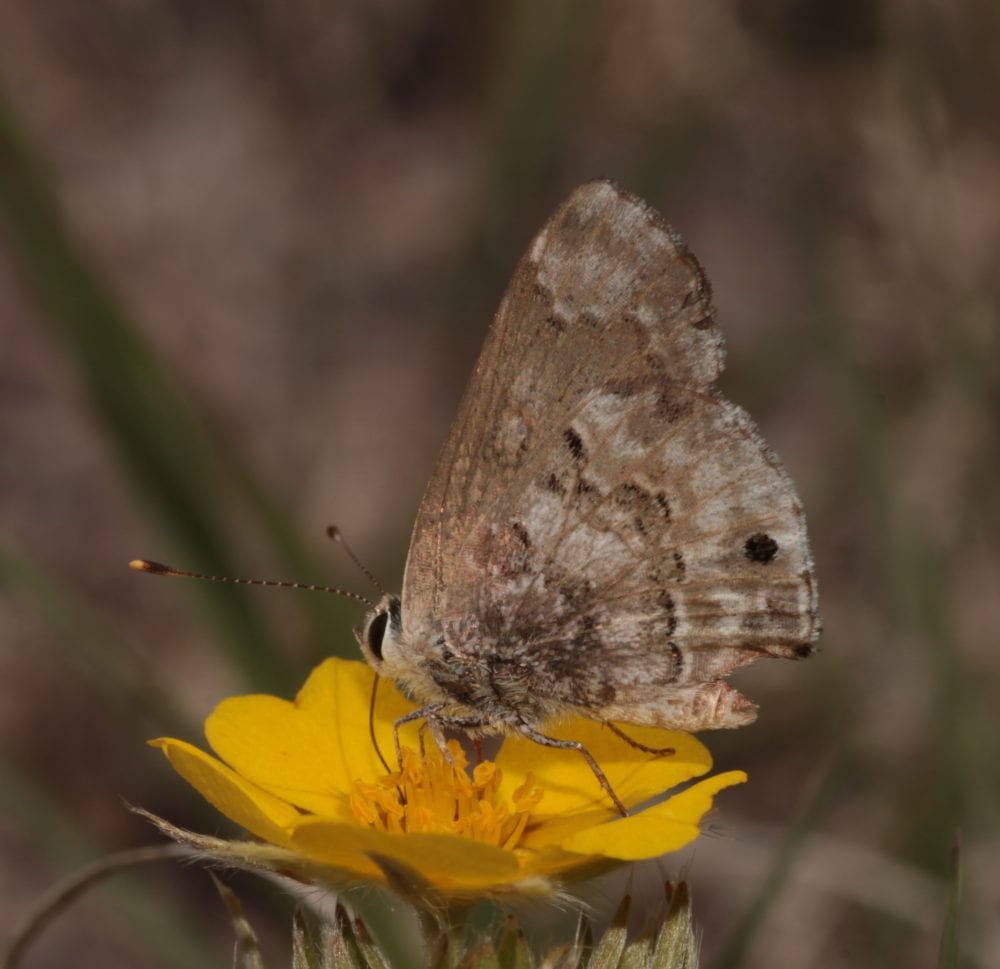
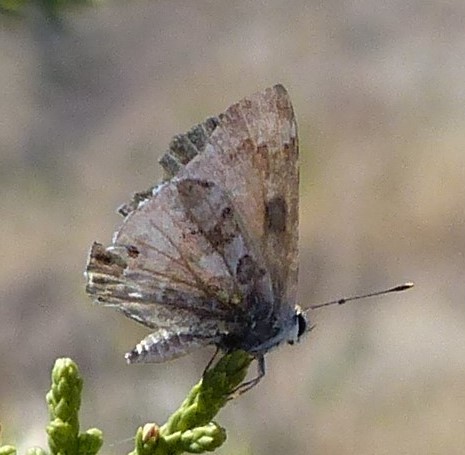
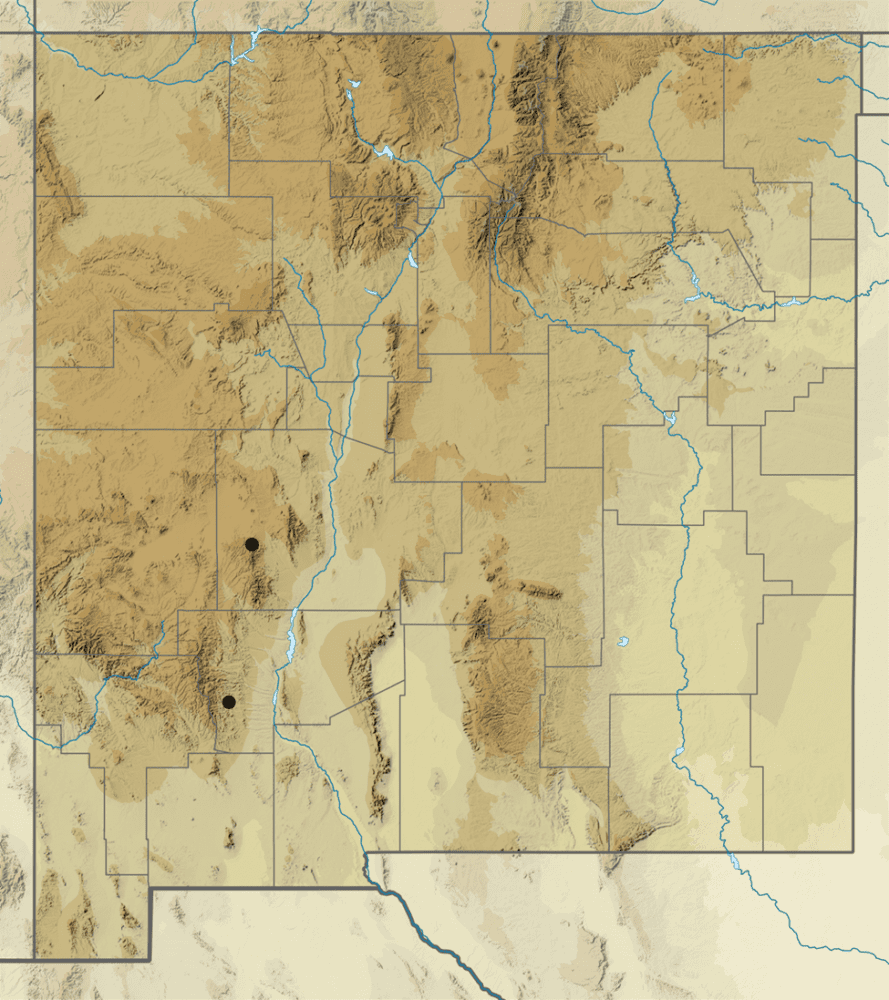
Strymon melinus Hübner 1813 Gray Hairstreak (updated May 7, 2022)
Description. This common, widespread butterfly has a silver-gray underside with a white and black submarginal line. The hindwing below has an orange tornal spot and a tail. this false head is echoed dorsally, but on a darker gray ground. Range and Habitat. Gray Hairstreaks occur across all of temperate North America and Central America. It is ubiquitous in New Mexico (all counties) and has been found at elevations from 3000 to 10,000′. Life History. Strymon melinus larvae may be the most polyphagous of all butterflies in North America. Plants in more than 50 families are known hosts and many likely remain to be documented. Legumes may be preferred. Flight. Strymon melinus completes two to three generations per year. It flies on most warm season days almost anywhere in the state. Early and late dates are January 16 and December 25. Males perch head-down on hilltop shrubs, sometimes opening their wings to display the false head. Adults nectar avidly. Comments. Aberration meinersi Gunder, lacking all orange pigment, turns up rarely. In the 1890s, Professor C. H. T. Townsend captured a Gray Hairstreak at the Rio Ruidoso, 7600′ (Lincoln County), on 3 August. That specimen, the first record of this species from New Mexico, is at the US National Museum in Washington, D.C. Our subspecies is Frank’s Gray Hairstreak (Strymon melinus franki W. D. Field, 1938. Another Comment. After the discovery of Callophrys mcfarlandi, a number of collectors collected hairstreak larvae from Nolina microcarpa (the reputed food plant at the time of mcfarlandi‘s discovery; later confirmed to be N. texana). Almost all of them turned out to be the ho-hum Gray Hairstreaks. As reported to Mike Toliver by Kilian Roever, who was one of those unlikely collectors. And Another. A variety of subtropical and tropical hairstreaks resemble the Gray Hairstreak. One in particular – the Red-lined Scrub-Hairstreak (Strymon bebrycia [Hewitson 1868]) – has the postmedian line red and edged outwardly by white, plus extensive areas of ghostly whitish markings submarginally on the VHW. Females of that species have lots of white on the DHW. The plate below illustrates the differences. There is one unverified report of S. bebrycia from Clanton Draw, Peloncillo Mts., Hidalgo Co., NM.
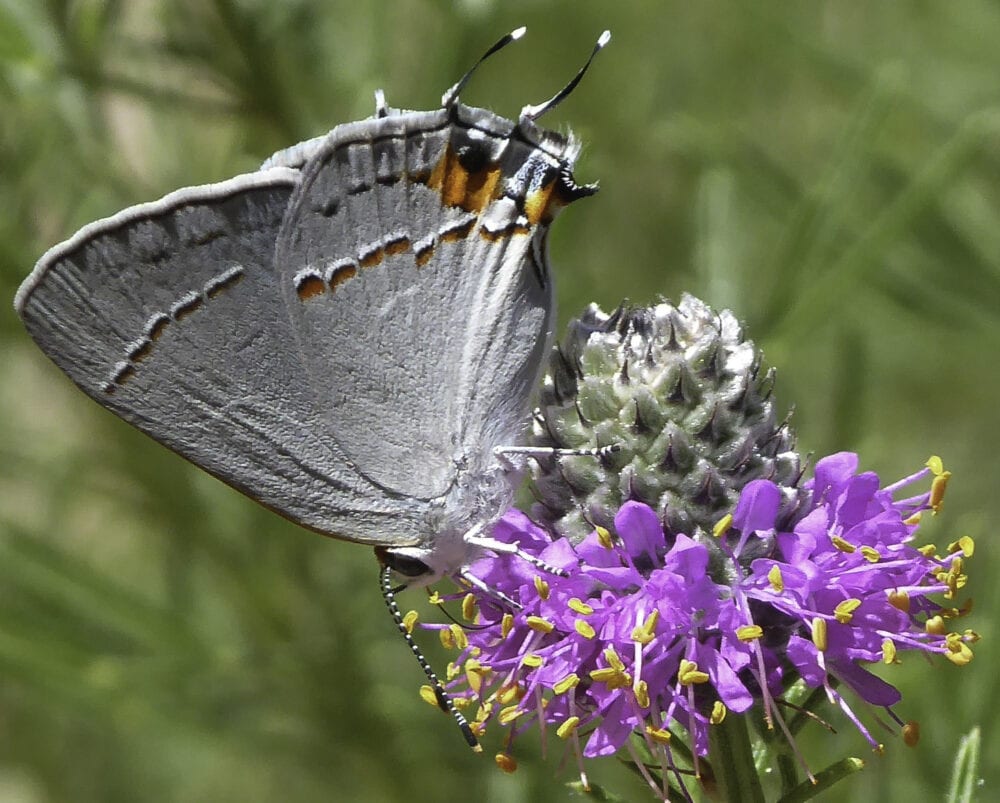
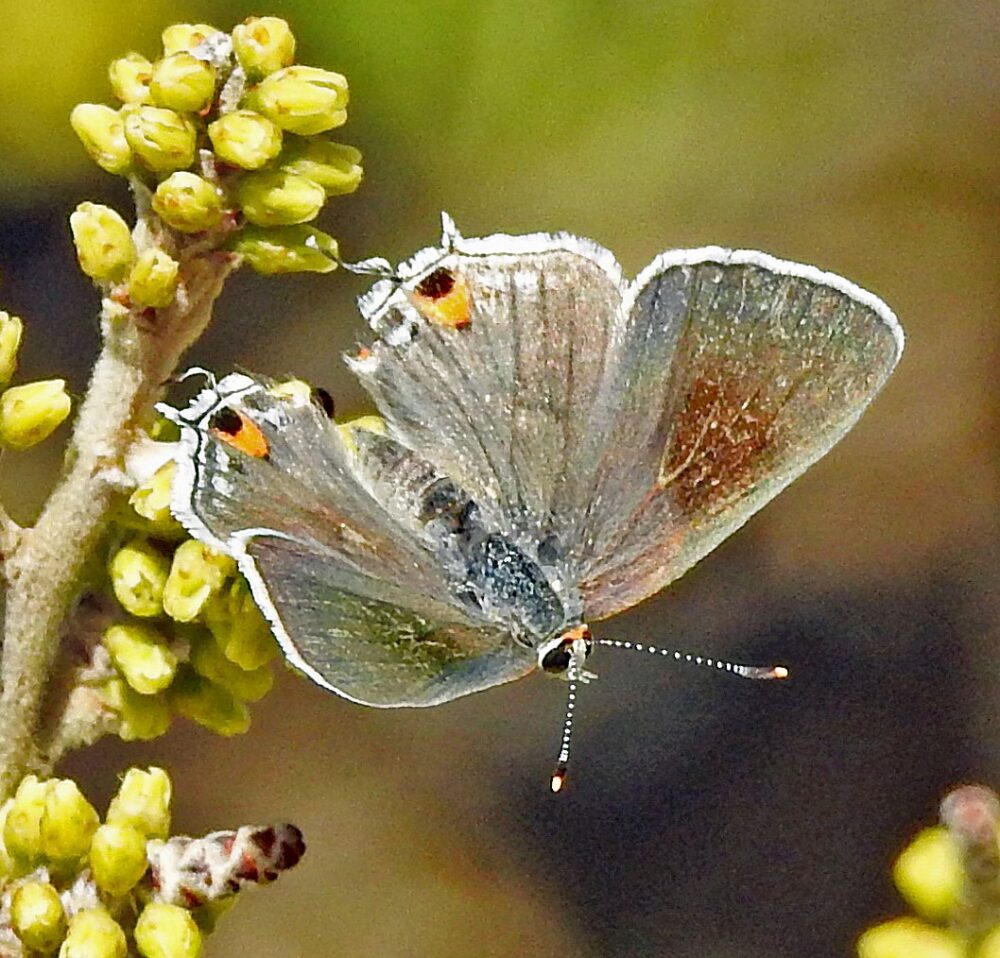
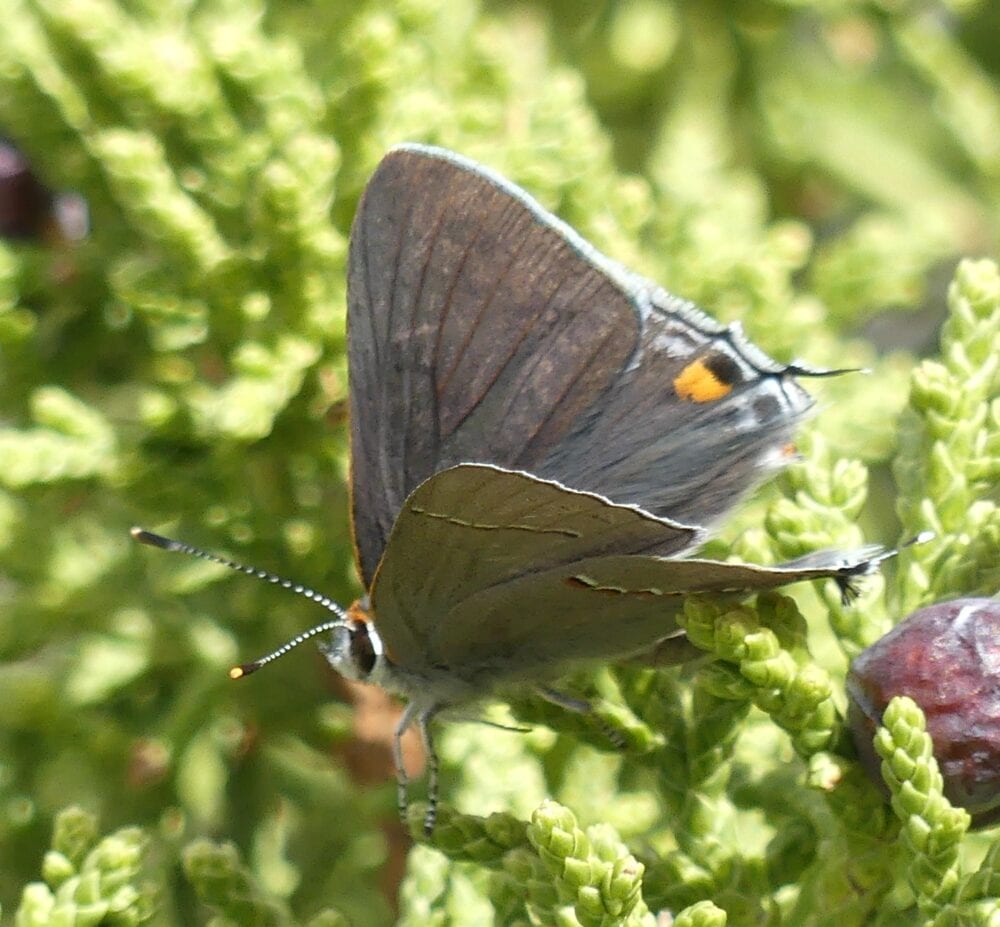
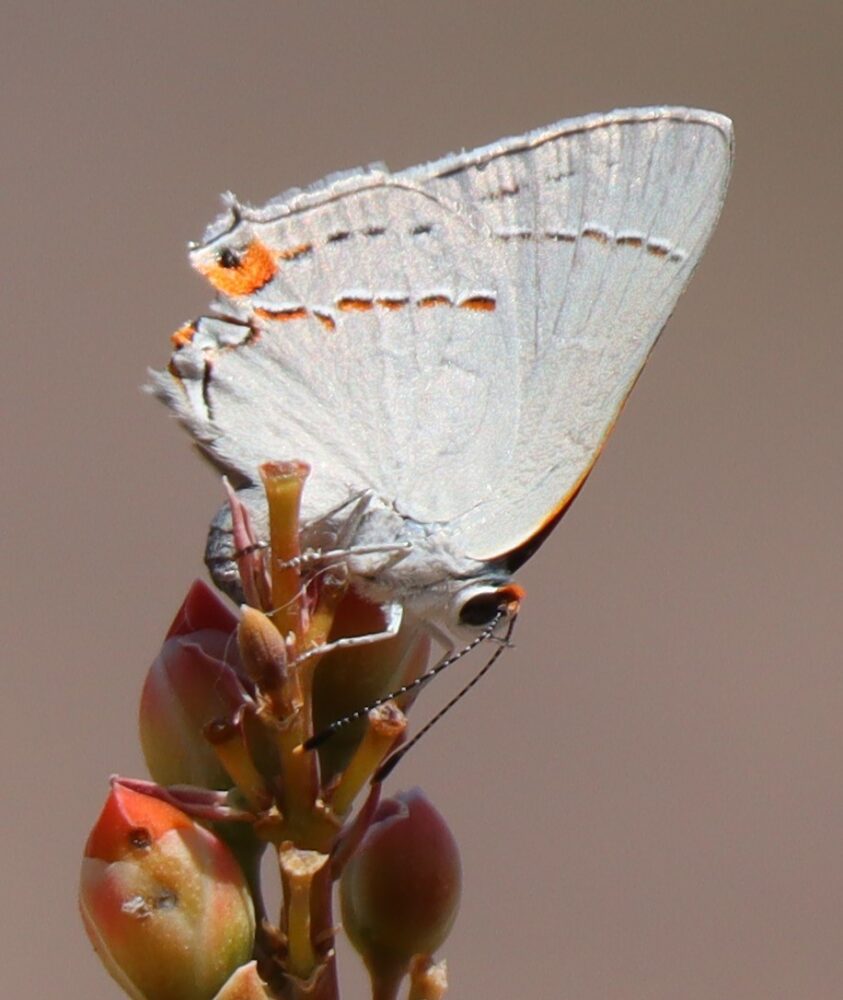

Ministrymon leda (W. H. Edwards 1882) Leda Ministreak (updated April 4, 2022)
Description. Leda is our smallest hairstreak. Dorsally, the forewing is mostly black, and the hindwing is iridescent blue, though uppersides are rarely displayed. Undersides are silvery gray, frosted with white; a narrow band of orange, black and white staggers across the hindwing and contributes a “W” to the false head. The winter form is darker (see photo below) and does show up occasionally. Range and Habitat. Leda lives in northern Mexico and the southwest US, chiefly CA,NV,AZ,NM and TX. It prefers mesquite thorn-scrub habitats. In New Mexico it breeds only in southern lowland areas, but it does wander north, sometimes a long distance (counties: Be,Ca,Ch,Ci,Co,DA,Ed,Gr,Hi,Li,Lu,MK,Ot,Qu,RA,Ro,Sv,SM,SF,Si,So,To,Va,Un). It usually is found below 6000′, but it strays upward to 8000′ and rarely to 9500’. Life History. Leda larvae eat woody legumes (Fabaceae), primarily honey mesquite (Prosopis juliflora). Flight. There are two or three annual generations in southern New Mexico. Flight peaks are in June and September. Extreme flight dates are April 28 and November 29. Adults perch on host leaves and nectar greedily. Comments. The oldest New Mexico record is a specimen in the USNM collected by P. R. Gleason in Central (Gr), on 1 June 1938. Our northernmost reports (Co,SF,RA) date from 1992 (and now 2020), apparently good years for Leda Ministreaks. More northward expansion would not be a surprise in warming climates. Leda can’t get too far without host mesquites, but domestic livestock are rapidly spreading mesquites throughout New Mexico, so that may not be an obstacle for Leda for long. More Comments. Three other Ministreaks may eventually be found in New Mexico; the Gray Ministreak [(Ministrymon azia (Hewitson 1873)], Vicroy’s Ministreak (Ministrymon janevicroy Glassberg, 2013) and the Clytie Ministreak [Ministrymon clytie (W. H. Edwards 1877)]. The Gray Ministreak has been confirmed from SE AZ and there are unconfirmed reports of Clytie there (Bailowitz & Brock 2022). Vicroy’s Ministreak is recently described and closely resembles the Gray Ministreak; it differs in having olive green eyes and a “pebbly” appearance on the ventral surface.
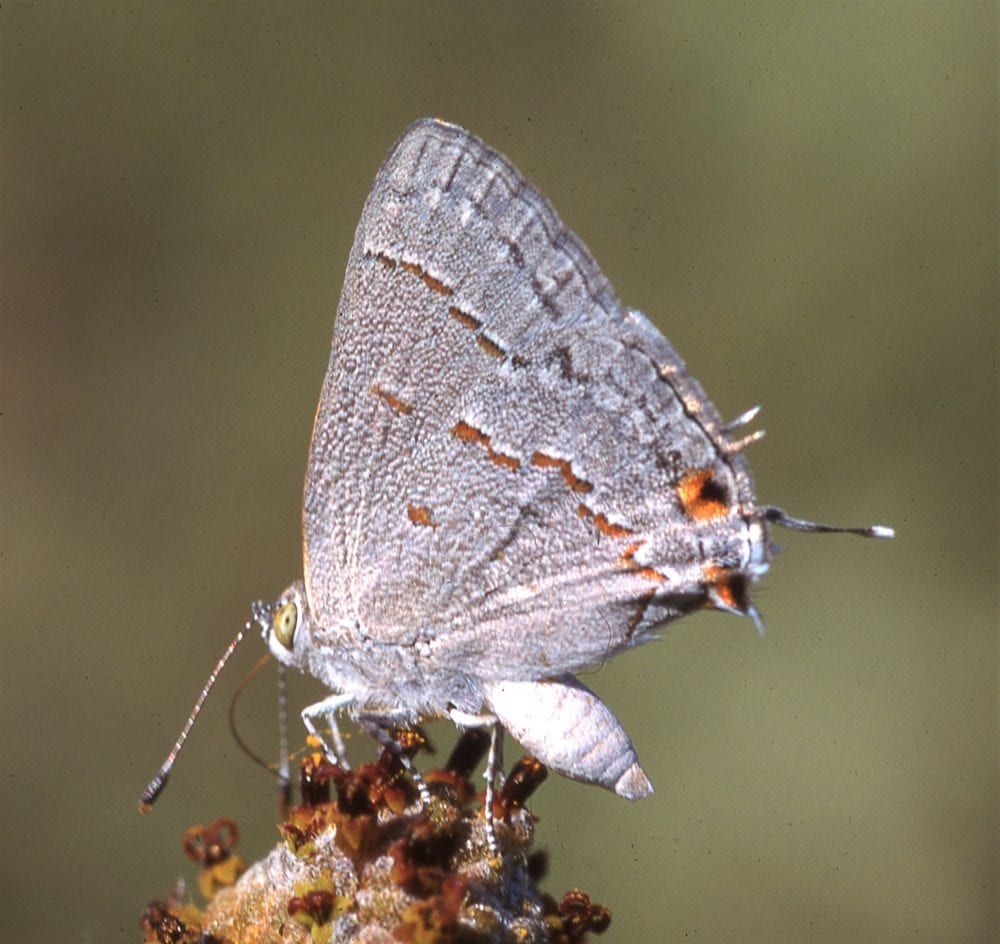
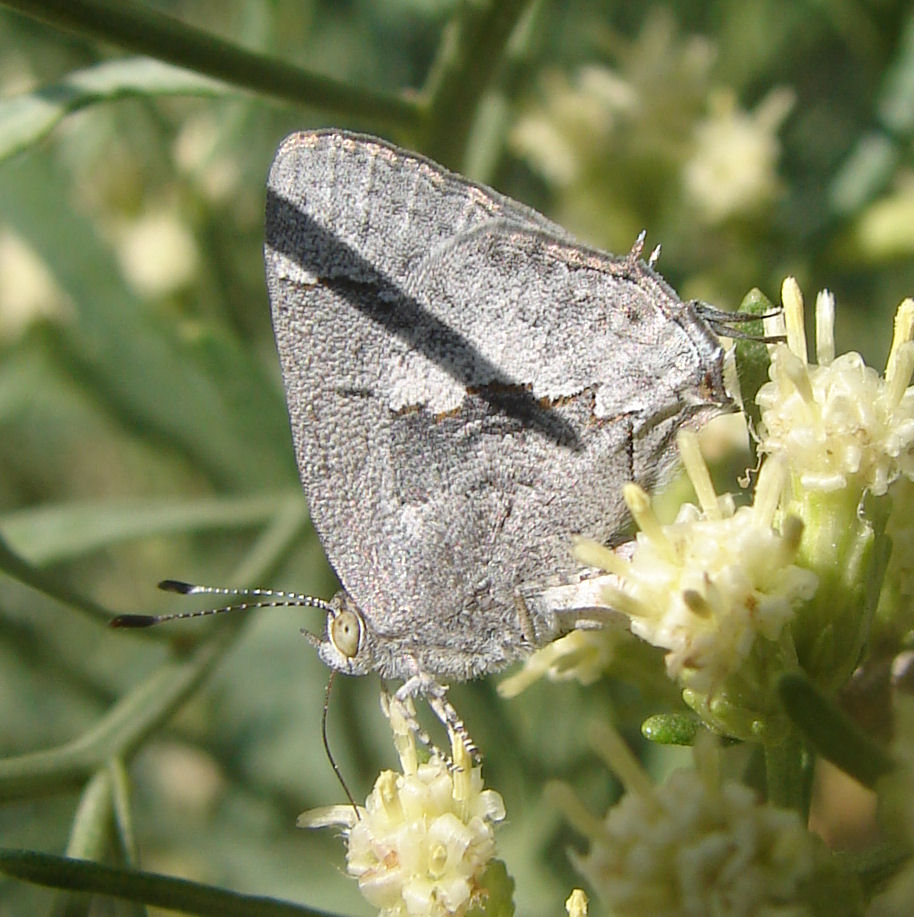
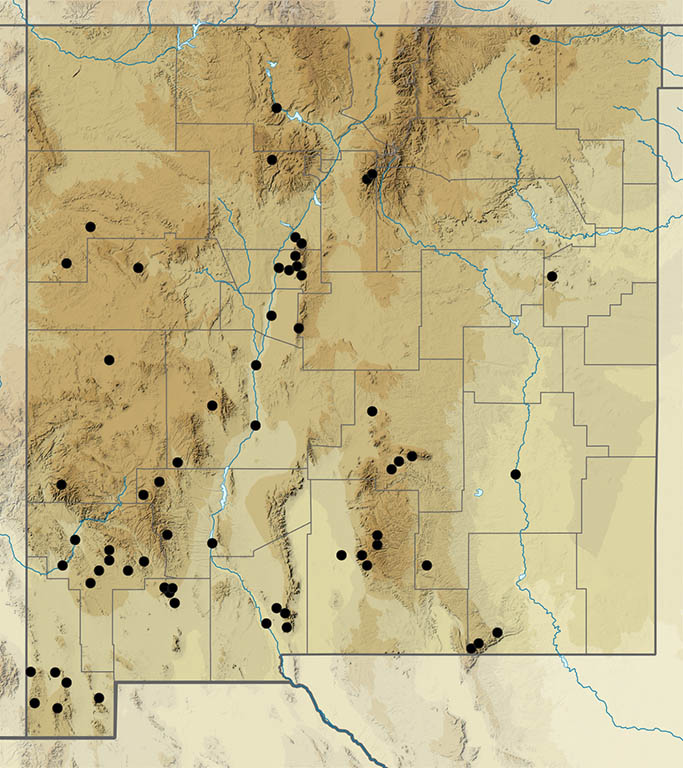
Callophrys spinetorum (Hewitson 1867) Thicket Hairstreak (updated April 7, 2022)
Description. Thicket Hairstreaks are brown below with a prominent narrow white postmedian line. A row of black dots and a false head decorate the hindwing tornal region. The steel blue upperside is glimpsed only in flight. Range and Habitat. Callophrys spinetorum lives from British Columbia south to central Mexico and from the Pacific coast east to the Rocky Mountains. In New Mexico it occupies pine woodlands (counties: Be,Ca,Ci,Co,DA,Ed,Gr,Ha,Li,LA,Lu,MK,Mo,Ot,RA,Sv,SJ,SM,SF,So,Ta,To,Va), 6500 to 9800′. Life History. Thicket Hairstreak larvae eat dwarf mistletoes (Viscaceae), which parasitize conifers (Pinaceae). Documented hosts include Arceuthobium spp., which parasitize Pinus ponderosa and P. edulis. Pupae overwinter. Flight. Two overlapping generations peak in May and again in July – August. Extreme early and late dates are March 11 and September 11. Thicket Hairstreaks perch and nectar in sunny, open pine woods. Males occasionally hilltop. Comments. In New Mexico’s southeast quadrant, populations of Thicket Hairstreak have a low, but consistent, frequency of individuals bearing an extra white bar on the hindwing underside. This is considered to be Mexican subspecies Callophrys spinetorum millerorum Clench 1981 (see Robbins 1991).
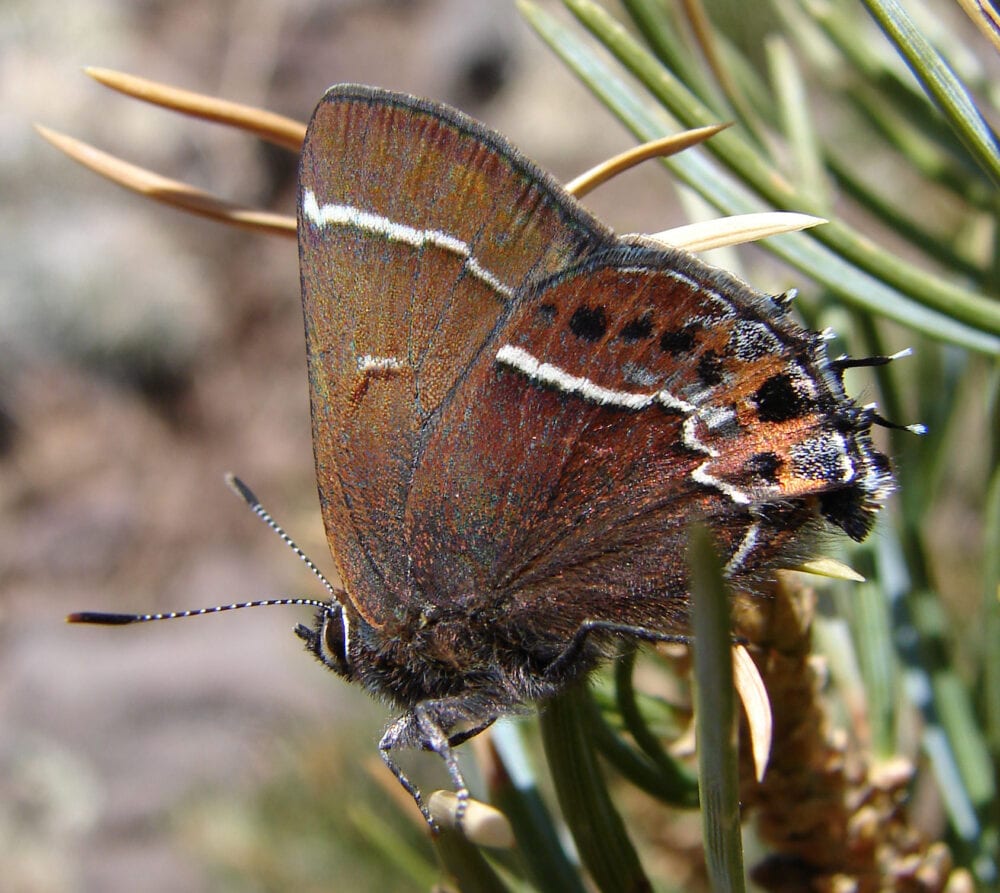
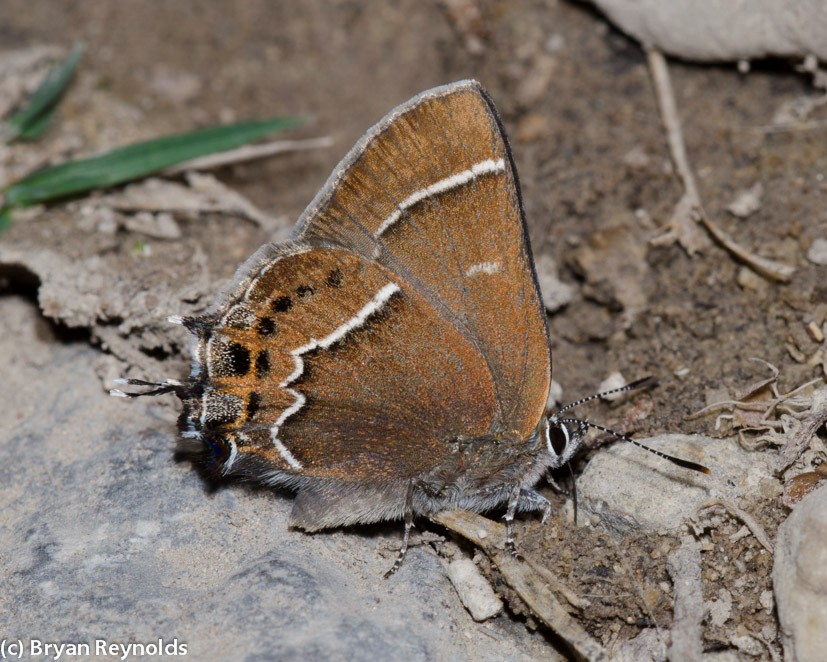
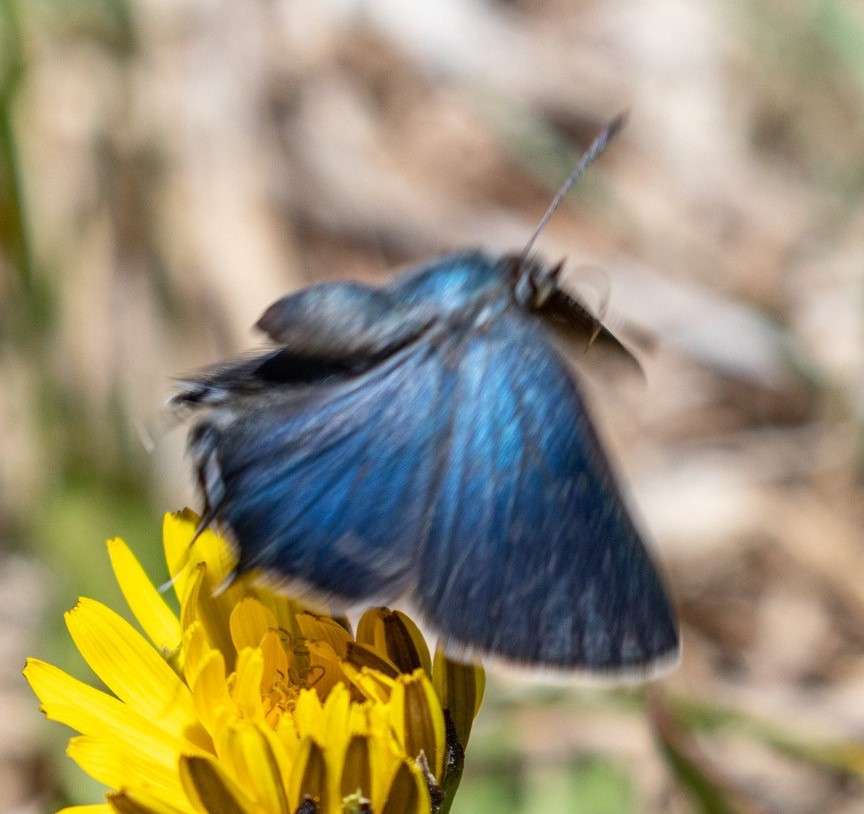
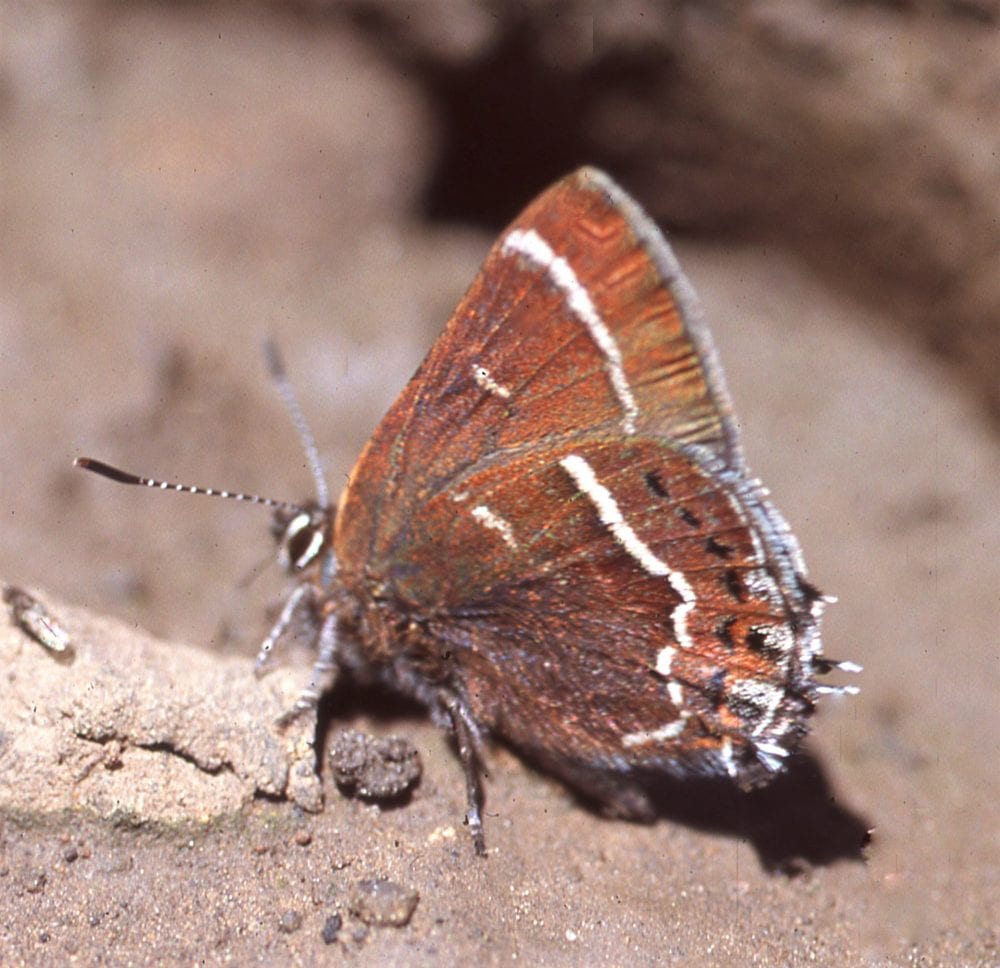

Callophrys gryneus (Hübner [1819]) Juniper Hairstreak (updated June 14, 2024)
Description. Callophrys gryneus in New Mexico is bright green below with a single white line on forewing and hindwing, plus tails. It is dark above, but usually overscaled with blond or rust red. Bright green fades to gray-brown over time; just-eclosed individuals may have a lavender sheen (see photo below). Two other tailed green hairstreaks resembling Juniper Hairstreak occur rarely in southern New Mexico: Xami Hairstreak and Silver-banded Hairstreak. Xami is a more yellowish green below, with a wider and straighter white line forming a distinctive “W” near the tail. Silver-banded is also a brighter yellowish green with a bold straight postmedian white line. Range and Habitat. Juniper Hairstreaks live throughout much of temperate North America. It is widespread in New Mexico below 8000′ (all counties but Le). Life History. Larvae eat almost any species of juniper or cedar (Cupressaceae). Juniperus scopulorum, J. monosperma, J. deppeana, J. erythrocarpa and J. osteosperma are confirmed hosts in New Mexico. Pupae overwinter. Throughout North America, including New Mexico, invasion of abandoned agricultural lands by junipers and cedars has expanded potential range and habitat for Juniper Hairstreaks. Flight. Callophrys gryneus is bi- or trivoltine in New Mexico, flying between March 15 and September 24. Peak flights in southern New Mexico are in April, July and September, shifting to May and August in northern New Mexico and at higher elevations. Juniper Hairstreaks bask in the morning, nectar at midday then perch for mates in the afternoon. Comments. Western Callophrys gryneus siva (W. H. Edwards 1874), to which all New Mexico populations belong, was once considered a distinct species from nominate eastern C. g. gryneus. That eastern version has two hindwing basal white bars and a very irregular white band. Individuals with one or both of the extra VHW white bars turn up with low frequency in eastern and southeastern New Mexico, most frequently in the Llano Estacado, Caprock Escarpment and Guadalupe Mountains (Ed). The white bars suggest a genetic link to Texas subspecies C. g. castalis (W. H. Edwards 1871), but DNA analyses to date do not corroborate that.
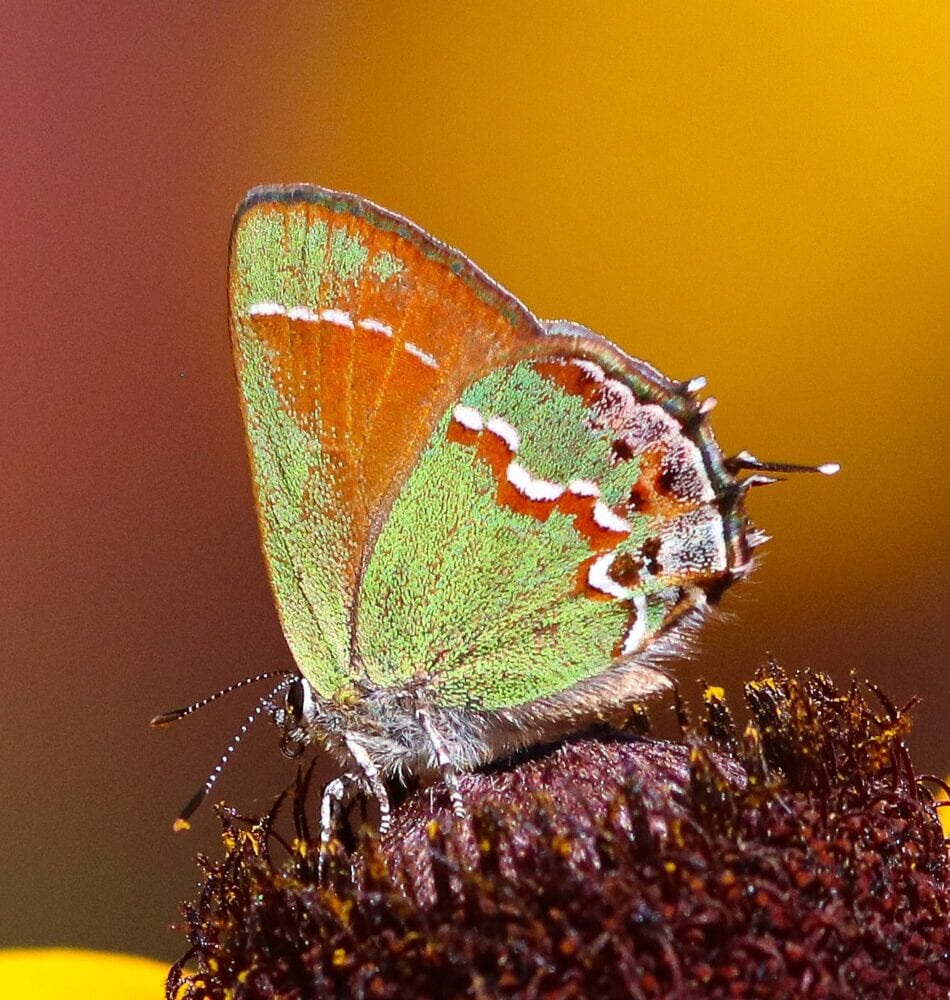
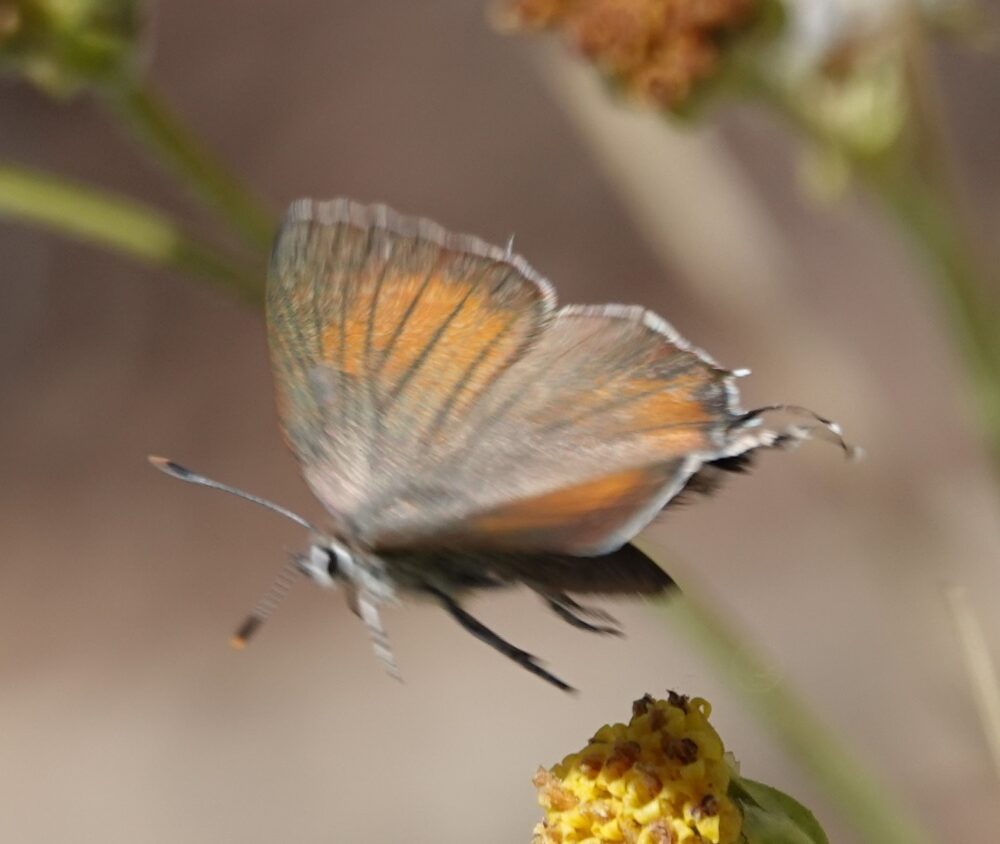
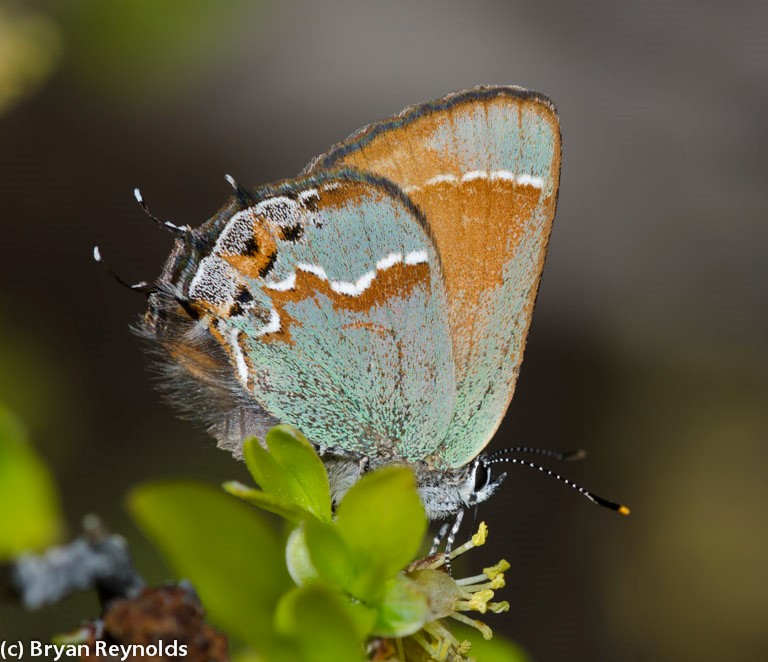
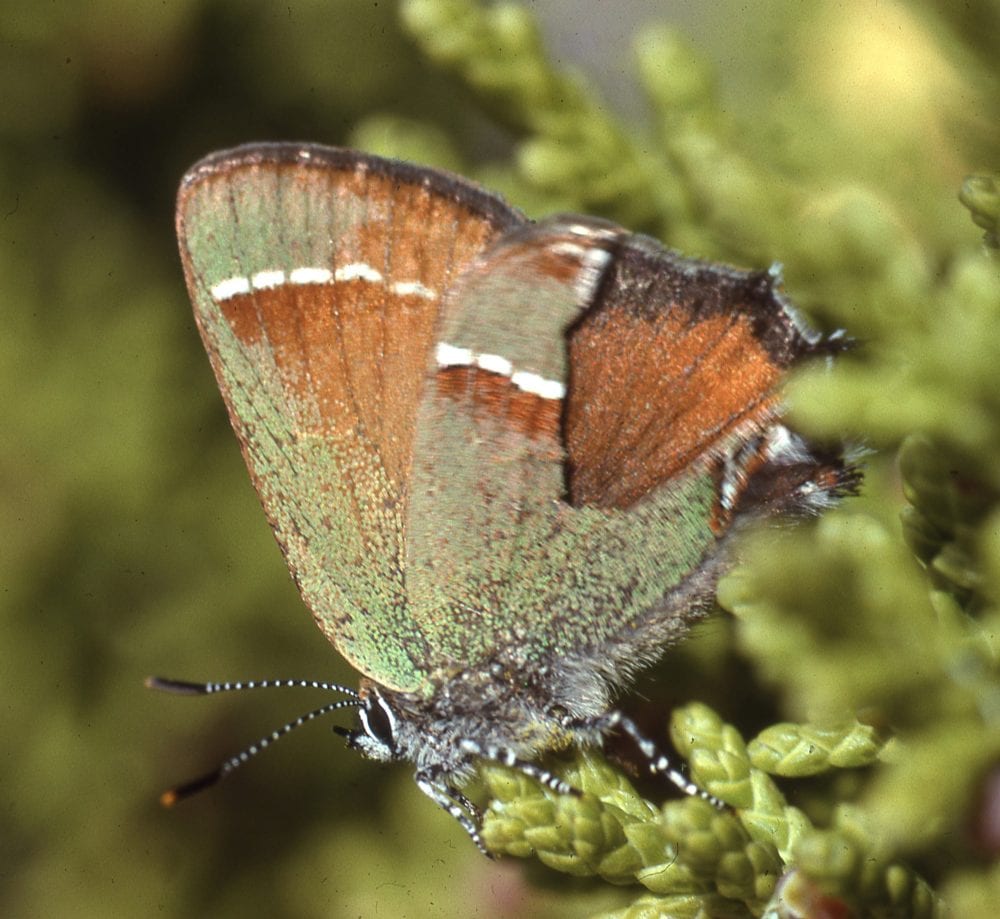
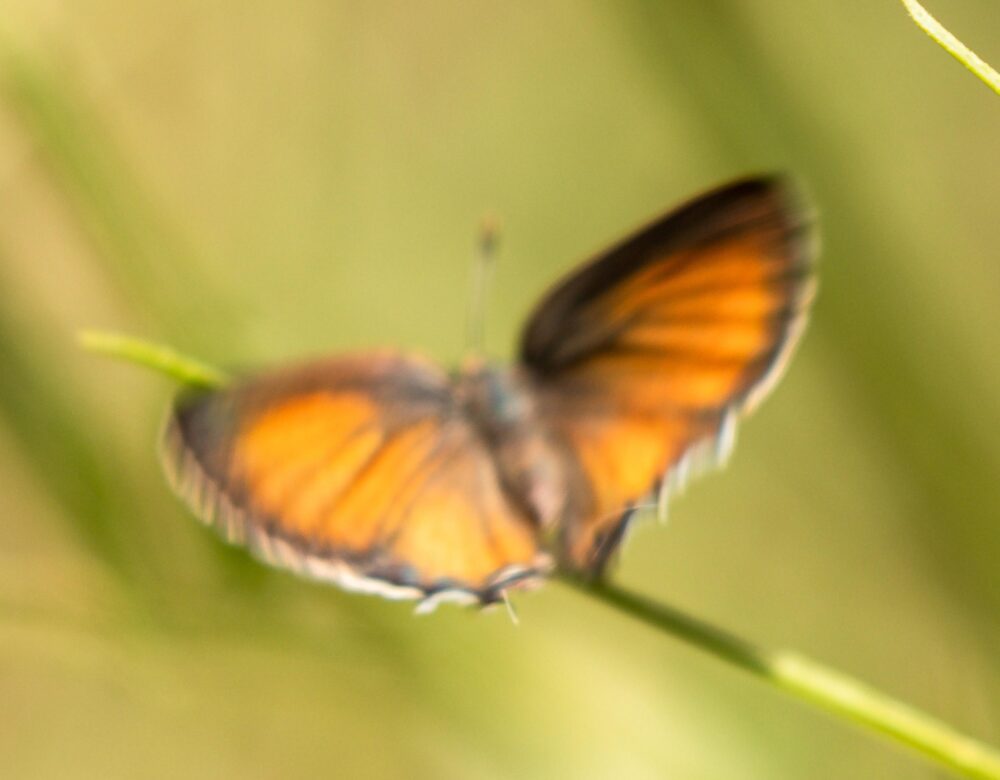
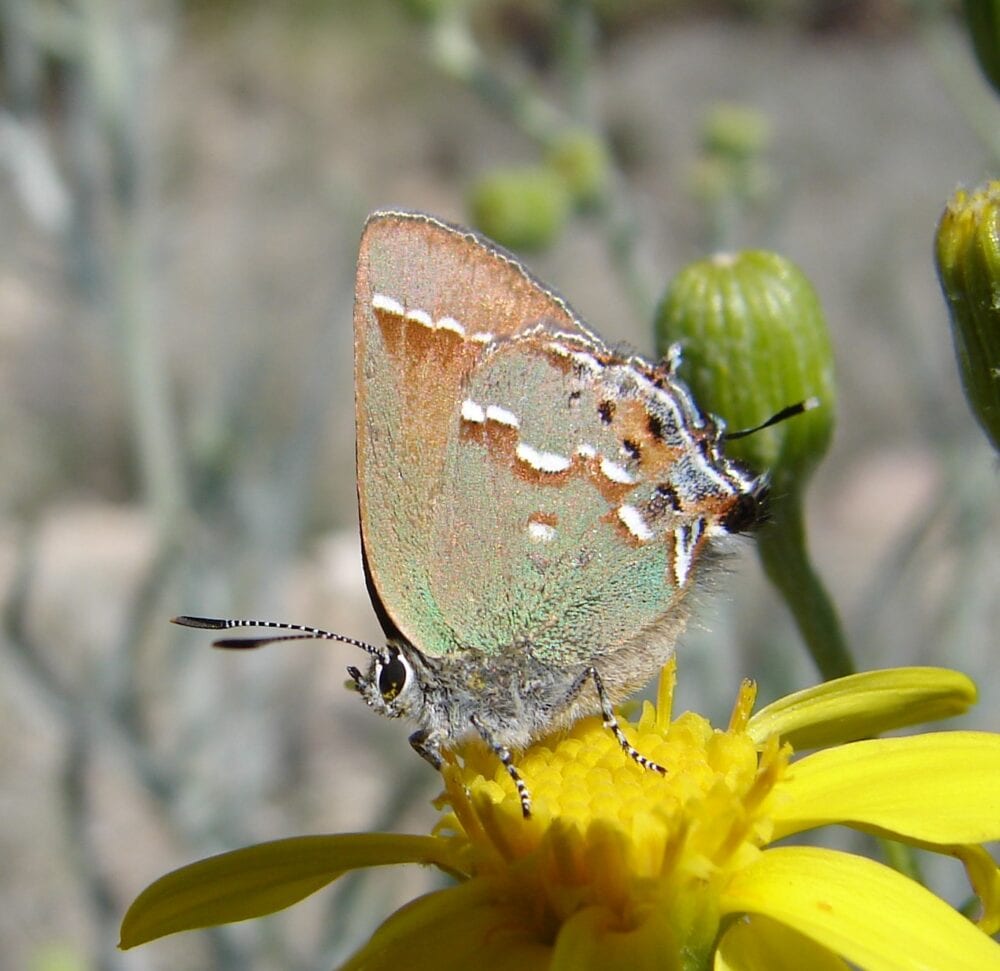
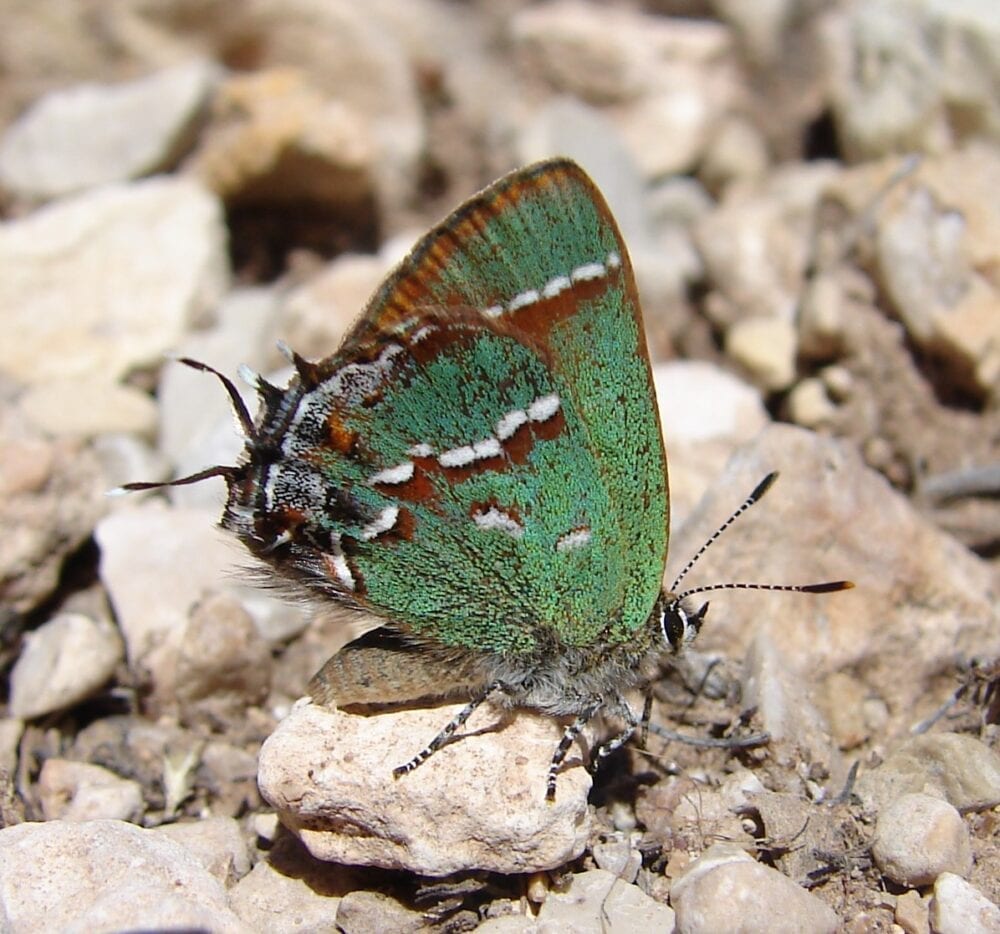
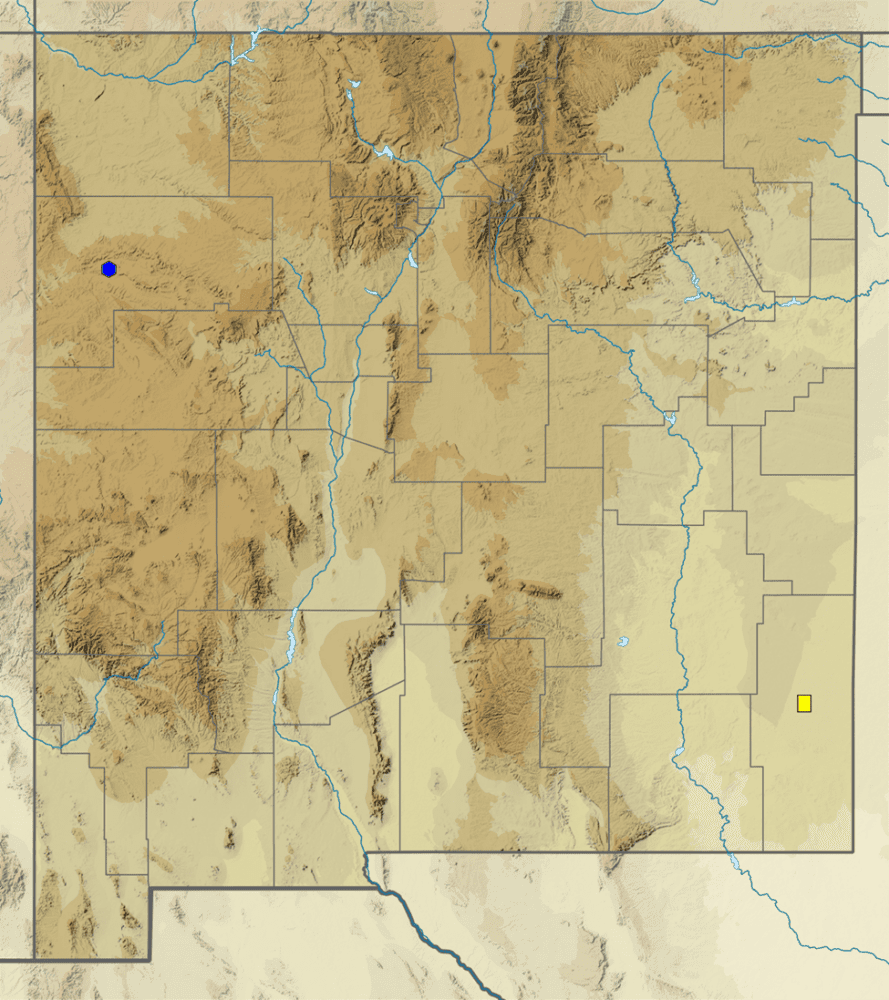
The Elfins (Callophrys: Incisalia)
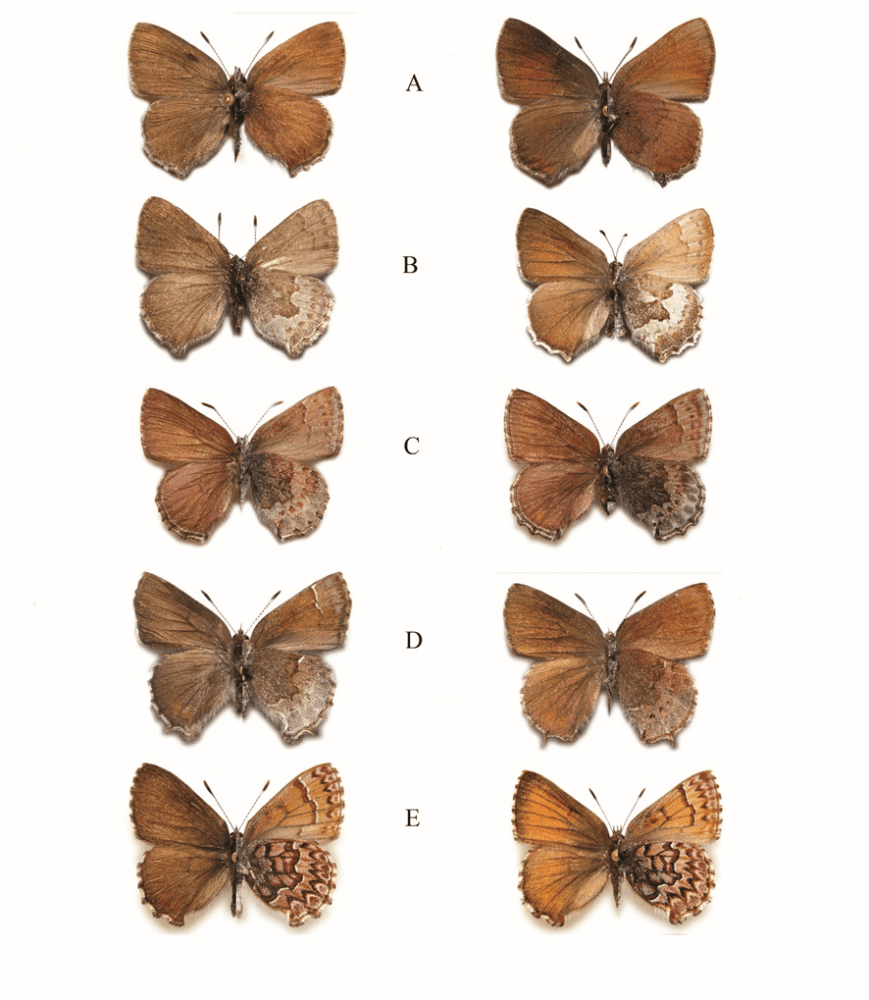
Callophrys augustinus (Westwood 1852) Brown Elfin (updated April 8, 2022)
Description. Like other “elfins”, Callophrys augustinus is small and lacks the false head and tails of other hairstreaks. It is brown above and below; the ventral hindwing is dark basally and iridescent mahogany or gold-brown distally. New Mexico has three “brown” elfins which can be difficult to distinguish: Brown Elfin, Hoary Elfin and Henry’s Elfin. Brown Elfin, true to its name, is brown underneath; often the basal portion of the VHW is darker than the postmedian area, but variations occur and sometimes the VHW is plain brown throughout. Hoary Elfin has frosted margins on both the VFW and the VHW. Hoary Elfin often occurs with Brown Elfin, so look for the plain, unfrosted V surface that distinguishes Brown Elfin. Henry’s Elfin occurs much further south in New Mexico than either Brown Elfin or Hoary Elfin, so range will help you tell it apart. Additionally, Henry’s Elfin has white lines at the apical end of the postmedian lines. Range and Habitat. Brown Elfins are widespread in temperate and subarctic North America, from AK east to NF, south to GA, AL and the Sierra Madre of Mexico. They inhabit wooded savannas in mountains of northern NM (counties: Co,RA,Sv,SJ,SF,SM) and southwest NM (counties: Ca,DA,Gr,Hi,Lu), generally 5200 to 8500′. Life History. Hosts in New Mexico are bearberry or kinnikinnic (Arctostaphylos uva-ursi) in the north and manzanita (Arctostaphylos pungens) in the south (both Ericaceae). Pupae overwinter. Flight. Adults are univoltine and fly in spring; extreme dates are February 25 to June 3. Peak flight occurs in April in the southwest and in May farther north. Brown Elfins bask and perch on hosts and come to nectar (e.g., willow) and wet sand. Comments. Some taxonomists consider the correct name to be Callophrys augustus (W. Kirby). Our populations belong to ssp. Callophrys augustinus annetteae (dos Passos 1943), which was described from specimens collected at an unknown location in “New Mexico.” When seeking Brown Elfin in its southwestern NM habitat, it can be useful to patiently scan green-leafed manzanita bushes for the occasional brown “leaf.”
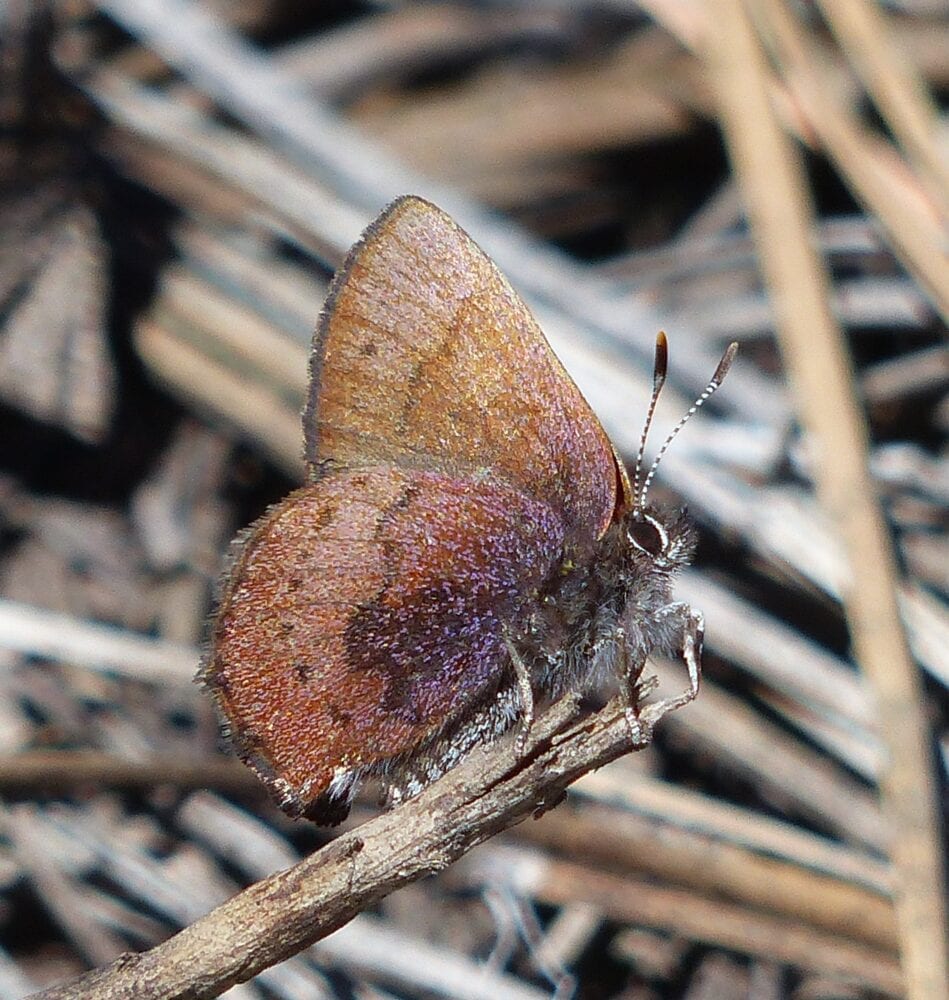
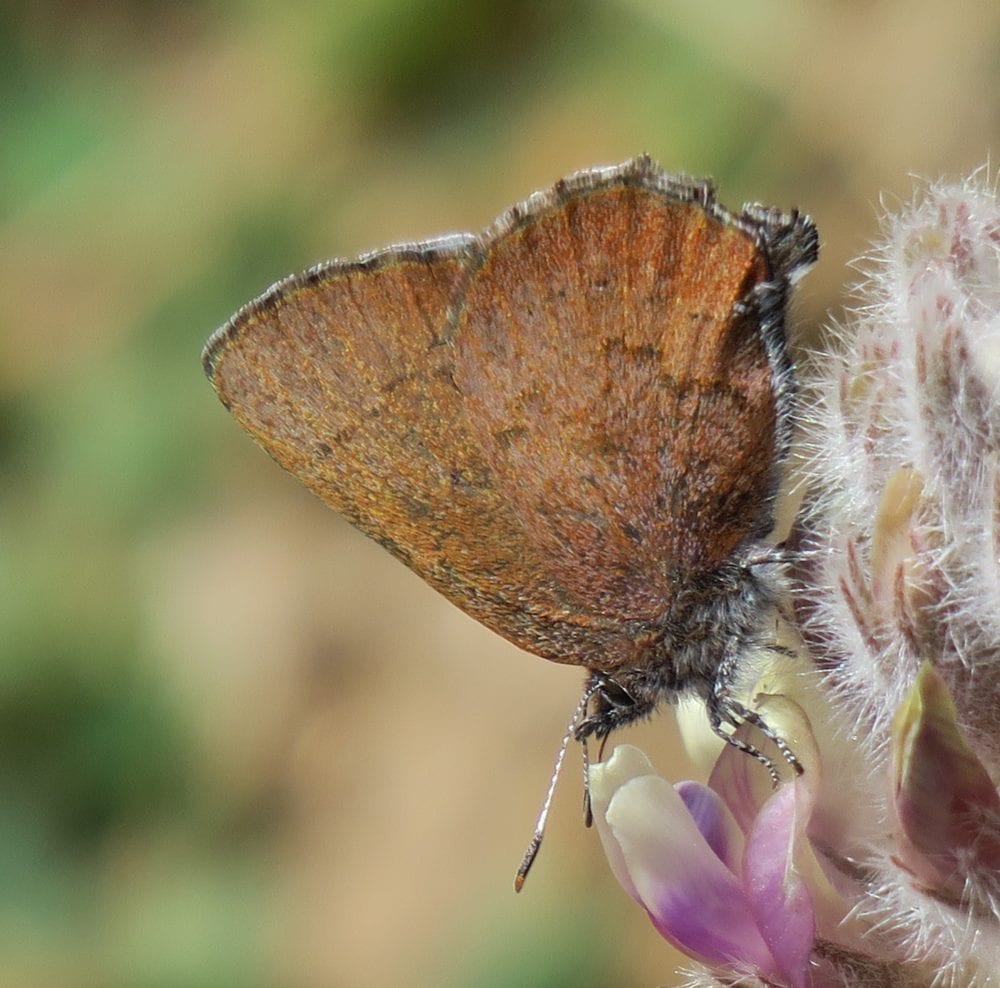
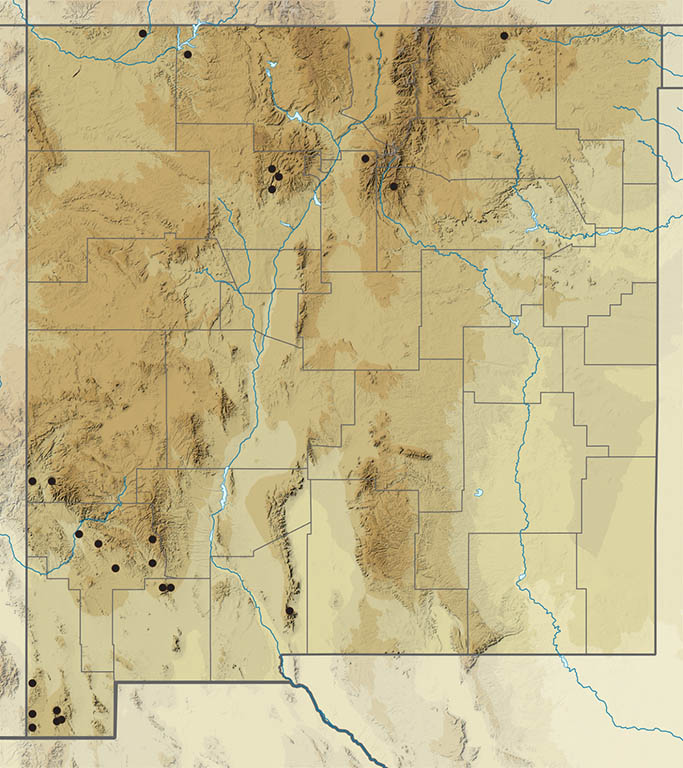
Callophrys fotis (Strecker [1878]) Desert Elfin (updated April 5, 2022)
Description. Desert Elfins have gray dorsal colors with a gold sheen. The ventrum is mottled gray with frosty, whitish scaling on the hindwing. Range and Habitat. Desert Elfins have a limited distribution in the Great Basin and Mojave Deserts in California, Nevada, Arizona, Utah, Colorado and northwest New Mexico (counties: Ci,MK,Sv(?),SJ). Here it lives in Upper Sonoran Zone canyons and foothills where the host grows, usually 6000 to 8000′ elevation. Life History. This butterfly’s life cycle depends entirely on cliffrose (Cowania mexicana var. stansburiana; Rosaceae; sometimes placed in Purshia). Eggs are placed on the flowers; larvae eat flowers and nutritious young fruit. Winter is passed by the pupae. Flight. Adults emerge in spring. Observations fall between April 17 and June 8, with peak numbers in May. Desert Elfins fly near the pale, scented flowers of the shrubby host, perching nearby or feeding at flowers and moist sand. Comments. Nominate Callophrys fotis includes the New Mexico colonies. The Carnegie Museum has a John Woodgate specimen labeled from the Jemez Mountains (Sv?) on 22 April 1916. That is our first report, but there are no modern reports from that area. Confirmation of that Sandoval County report is desired. A couple years earlier, Woodgate collected extensively in the Zuni Mountains where Desert Elfins remain well established, so it is not unreasonable to speculate that the CM specimen was actually caught in the Zunis and simply mislabeled later. Another extremely dubious record, also in the CM, is from High Rolls, Otero County. Cliffrose doesn’t occur in Otero County as far as we know. The closest this plant has been found is in Socorro County (https://www.fs.fed.us/database/feis/plants/shrub/pursta/all.html#33).
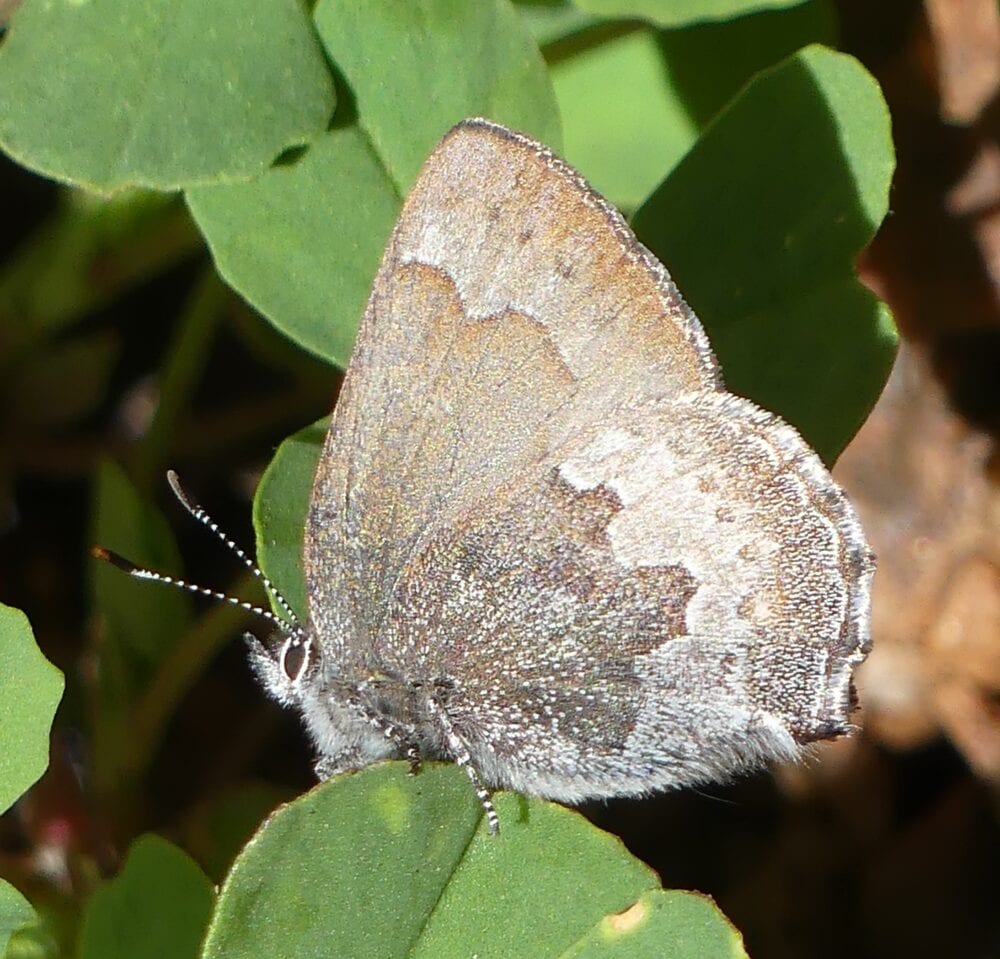
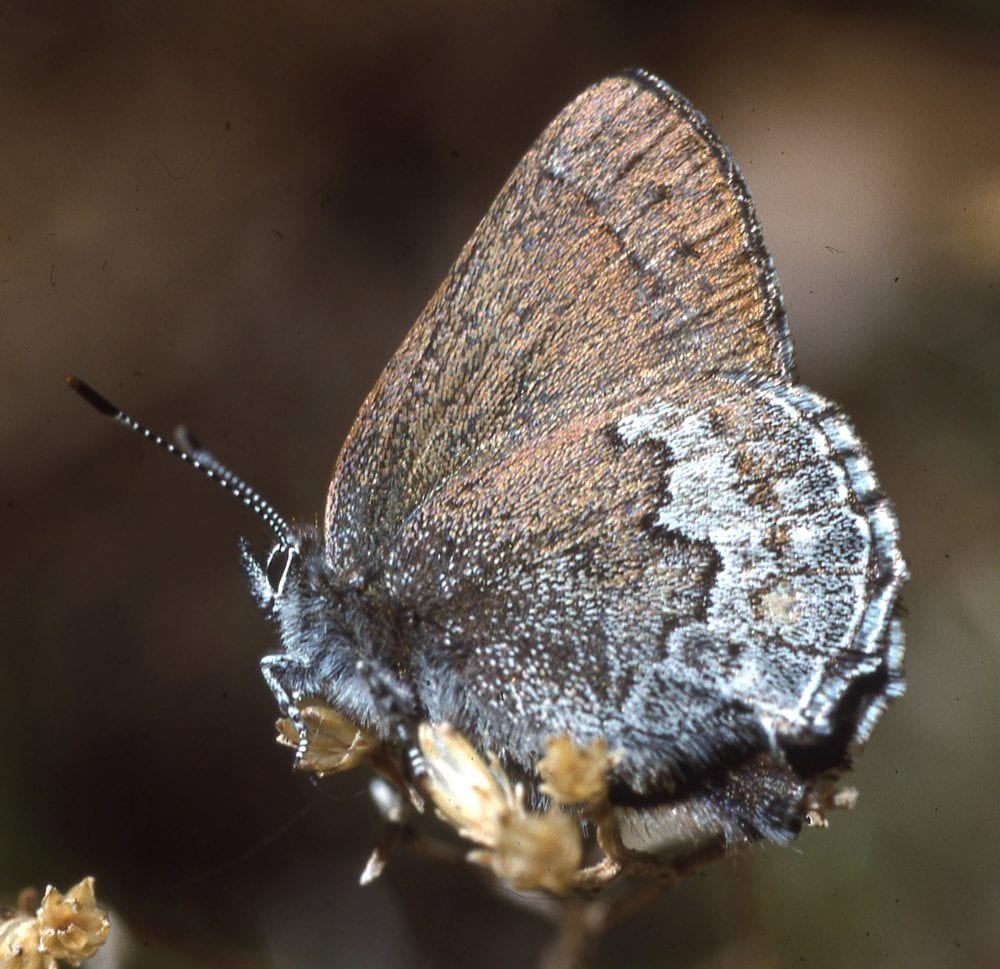
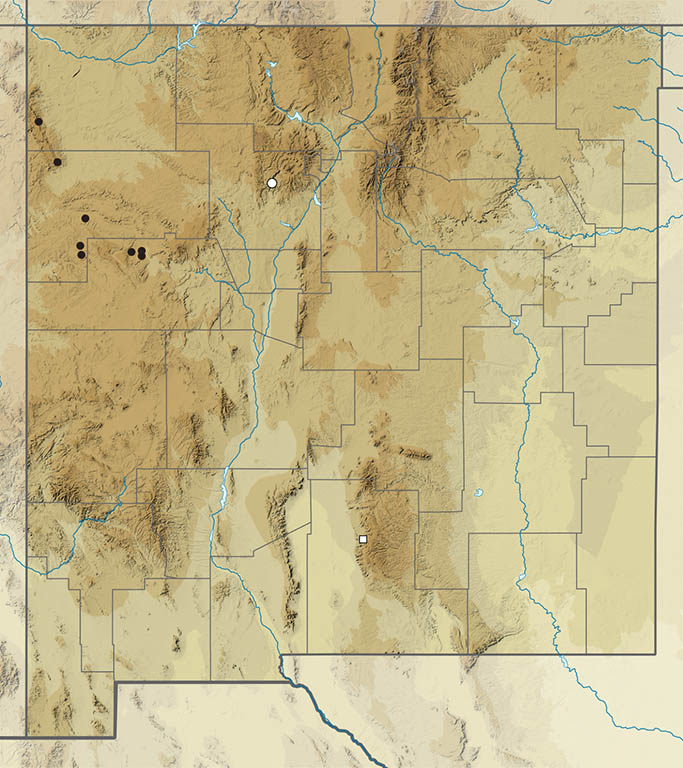
Callophrys polios (Cook & F. Watson 1907) Hoary Elfin (updated April 8, 2022)
Description. Hoary Elfin is brown above and gray-brown beneath. The hindwing underside is dark basally and lighter distally with a band of dark spots and rust-colored highlights. It resembles a chip of pine bark when perched. The frosted edges on the V surface will distinguish this species from the Brown Elfin, which often occurs with it. Range and Habitat. This little butterfly lives from Canada south to the Appalachians and in the southern Rockies as far as the mountains of north-central NM (counties: Co,LA,MK,Mo,RA,Sv,SM,SF,Ta). New Mexico records indicate a preference for open pine woodlands and savannas, 7300 to 10,400′, where the larval host sprawls across sunny forest floors. Life History. The New Mexico host is the low groundcover, kinnikinnic or bearberry (Arctostaphylos uva-ursi; Ericaceae). Richard Holland observed oviposition on this plant near Fenton Lake (Sv) on 4 May 1996. The chrysalis overwinters and adults emerge upon persistent spring warmth. Flight. Callophrys polios is univoltine in spring. Our observations fall between March 27 and June 19, with greatest numbers in May. Hoary Elfins fly near the ground, frequently perching and nectaring on or near stands of the prostrate host. Comments. Our populations our Callophrys polios obscurus (Ferris and M. Fisher 1973). Callophrys polios and Callophrys augustinus may fly together in the same patches of kinnikinnic. If you see one, then look for the other, too.
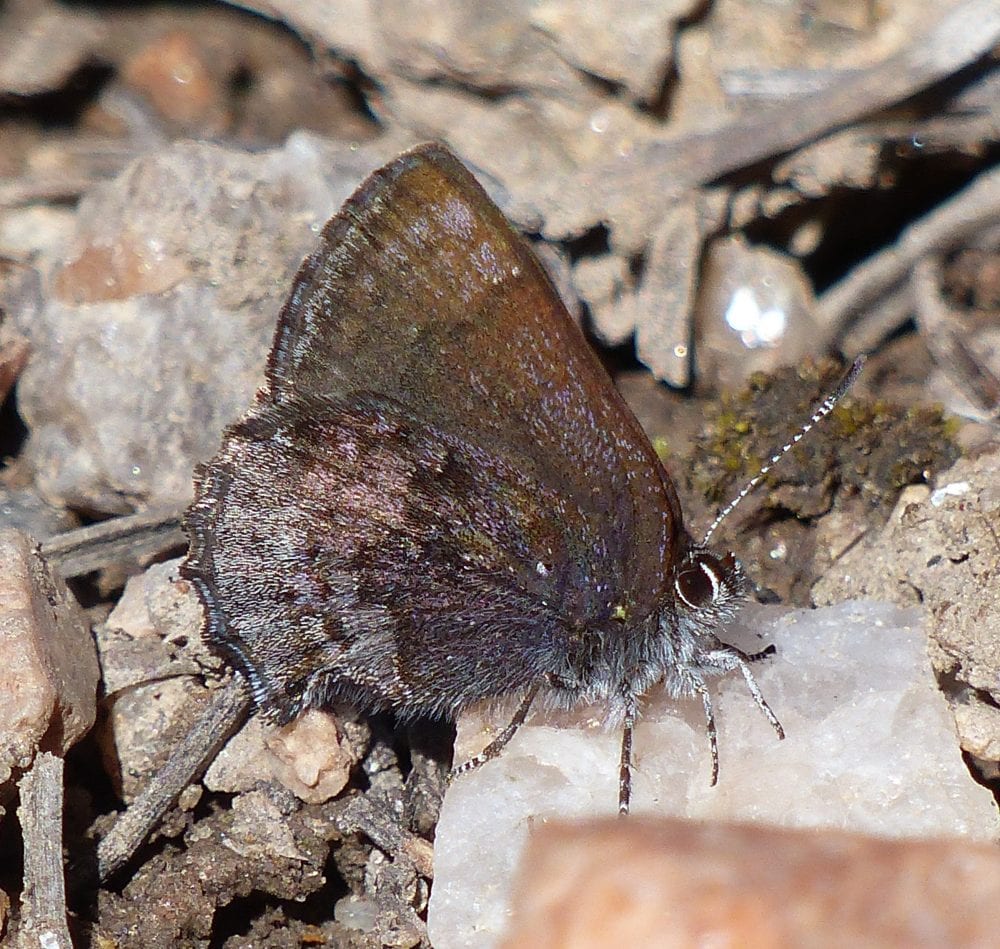
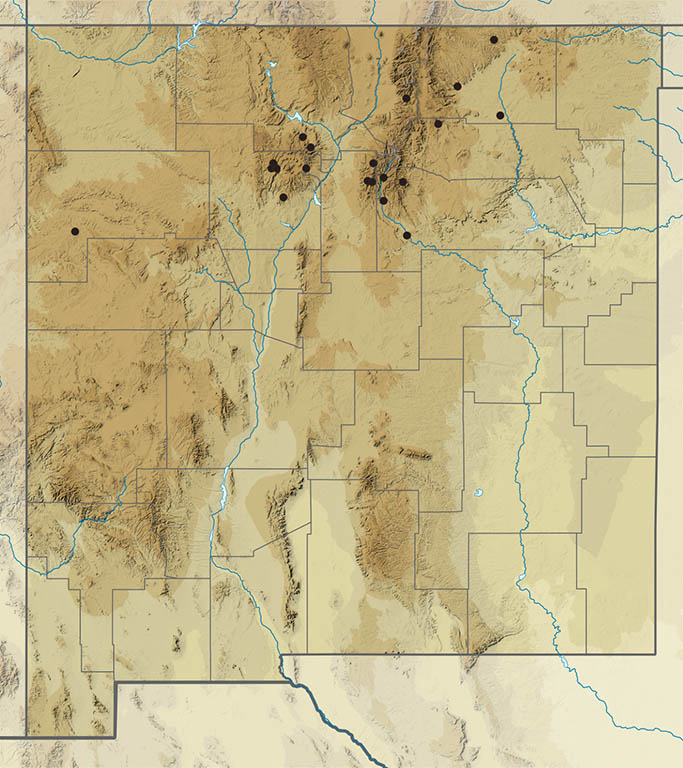
Callophrys henrici (Grote & Robinson 1867) Henry’s Elfin (updated April 11, 2022)
Description. Henry’s Elfin is brown. Lavender highlights and a small tail make up the rudimentary false head near the ventral hindwing tornus. Males lack a dorsal forewing stigma, which is unique among the elfins. The postmedian line on both VFW and VHW end with a white line near the top. Range and Habitat. This generally is a butterfly of eastern North America, but a courageous southwestern race occurs in west Texas, northeast Mexico and as far west as southern New Mexico (counties: DA,Ot?,Ed). Here this butterfly inhabits rocky Chihuahuan Desert canyons below 5500′ and supporting the host. The uncertain Otero County reflects speculation that the old High Rolls report of Desert Elfin may have been a misidentified Henry’s Elfin, whose larval host does occur in Otero County. Life History. Overall, Henry’s Elfin uses hosts that produce spring flowers and fleshy fruits, regardless of plant family. Our populations have red or green larvae (see photos below) that eat buds, flowers and seeds of New Mexico buckeye (Ungnadia speciosa; Sapindaceae). Pupae diapause through summer and winter. Flight. Univoltine adults emerge in early spring. New Mexico records span February 22 to April 30. Look for Henry’s Elfin near the larval host, a large woody shrub with bright pink flowers – easy to pick out on early spring days in the desert. Comments. Our handful of colonies belong to Trans-Pecos subspecies Callophrys henrici solatus (Cook & F. Watson 1909).
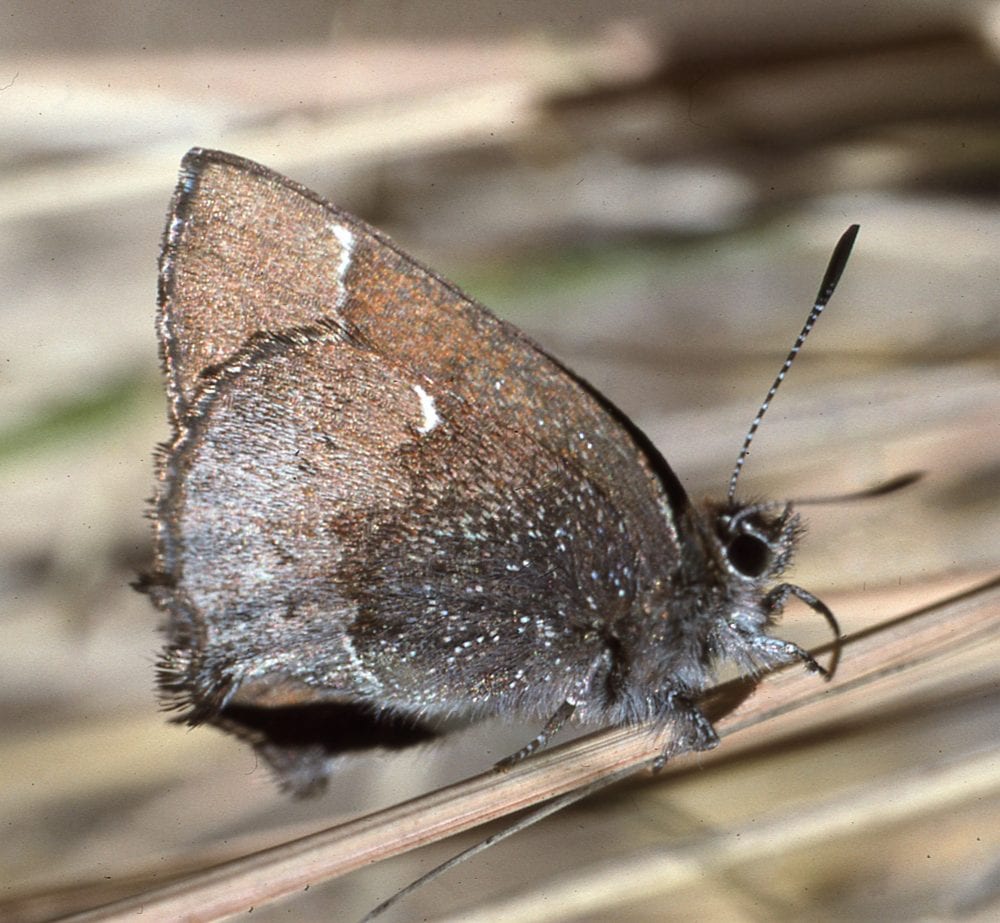
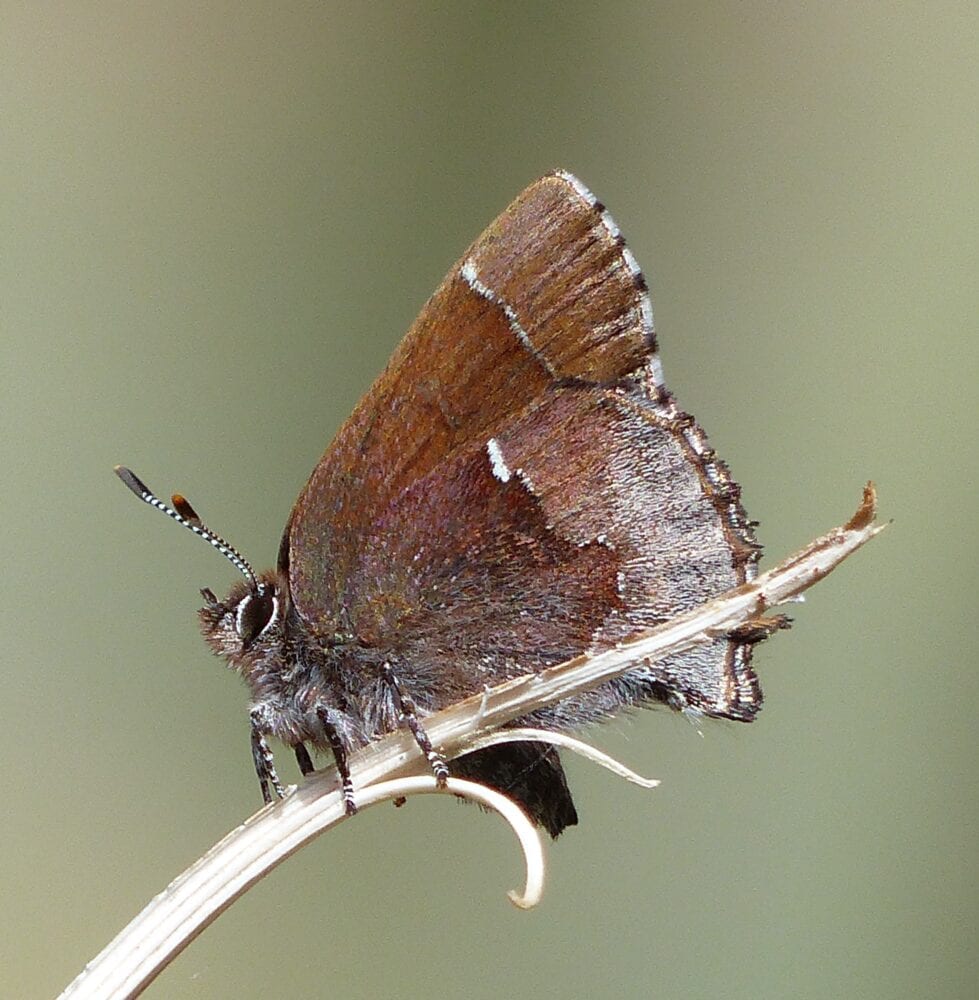
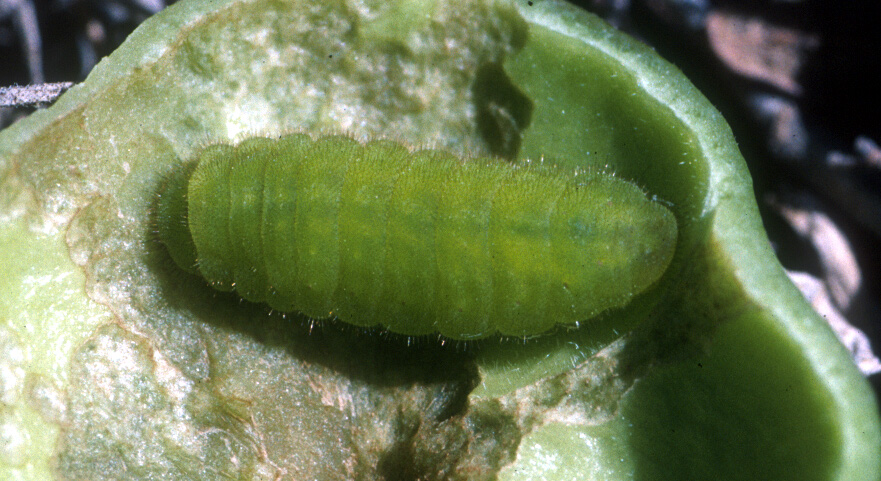
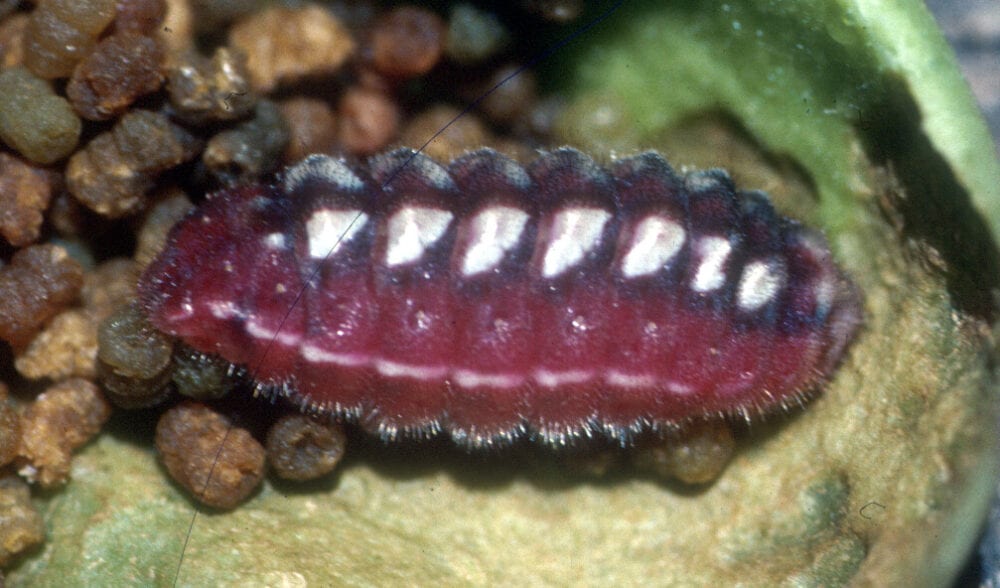
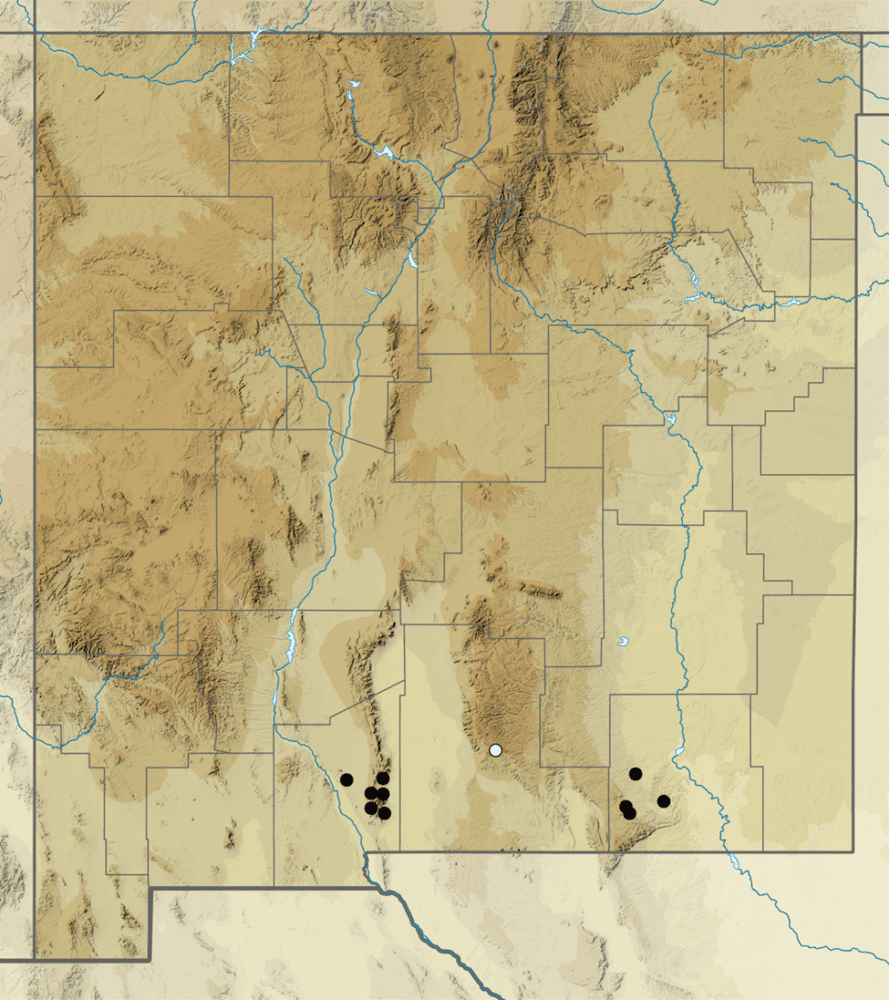
Callophrys eryphon (Boisduval 1852) Western Pine Elfin (updated April 11, 2022)
Description. This is our largest and most widespread elfin; it is thumbnail-size instead of merely fingernail-size! It is brown above and red-brown below, sometimes with a lavender hue on fresh individuals. The ventrum has an intricate design of quilted colors. Wing fringes are strongly checked black and white. Range and Habitat. Pine Elfin inhabits nearly all pine-cloaked mountains in western North America north of Mexico. It overlaps with its eastern cousin, Callophrys niphon (Hübner), in central Canada. In New Mexico it occupies Transition and Canadian Zone woodlands in all our major mountain ranges (counties: Ca,Ci,Co,Gr,LA,MK,Mo,Ot?,RA,Sv,SJ,SM,SF,So?,Ta), usually 7000 to 9600′. Life History. Callophrys eryphon larvae eat fresh needle growth of various pines (Pinaceae). Ponderosa pine (Pinus ponderosa) is the principal host in New Mexico, but piñon (Pinus edulis) may be used on occasion. Flight. This butterfly is univoltine with adults on the wing from April 13 to July 16, peaking in May. Look for Pine Elfins in pine savannas where they perch head-high on and near young pine saplings. They also nectar at flowers. Comments. We have always considered that NM has the nominate race, but Pelham (2022) very recently indicated that we have Arizona ssp. Callophrys eryphon fusca Austin 1998, so we will have to give that some thought. Unconfirmed reports from Otero and Socorro counties seem unlikely, but may yet be substantiated.
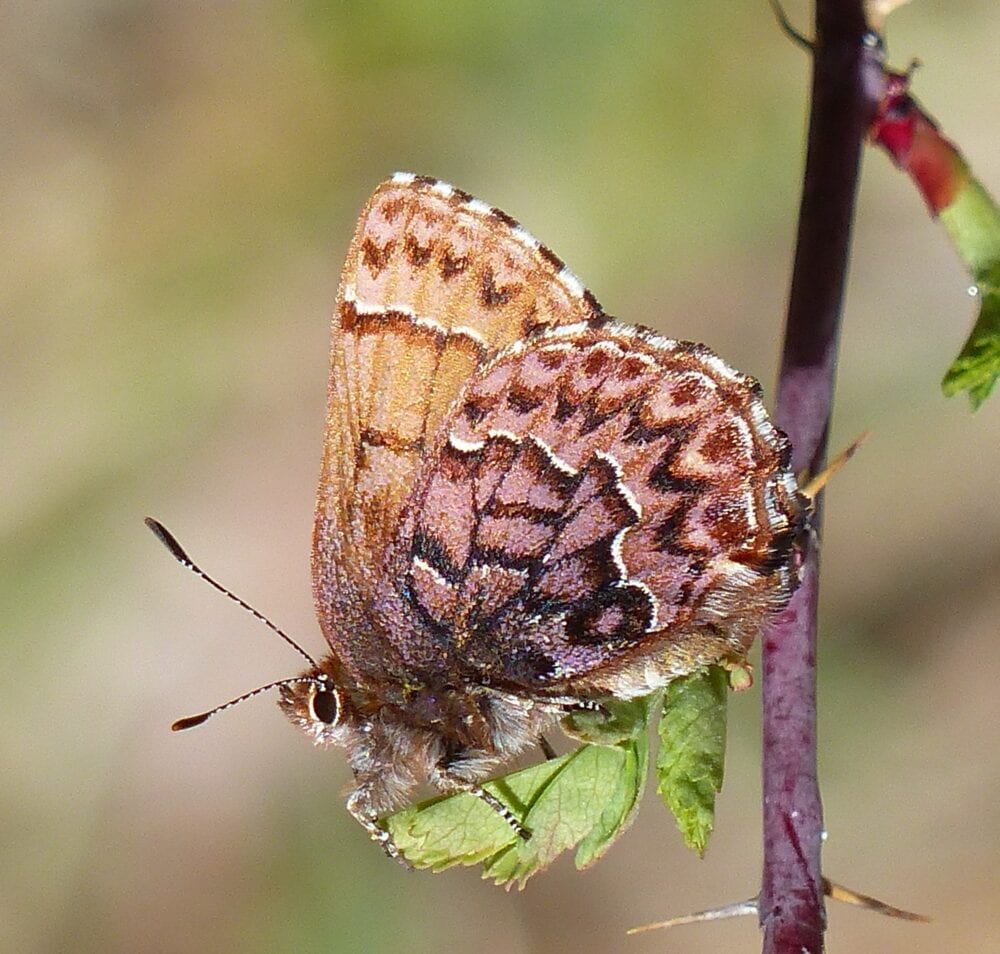
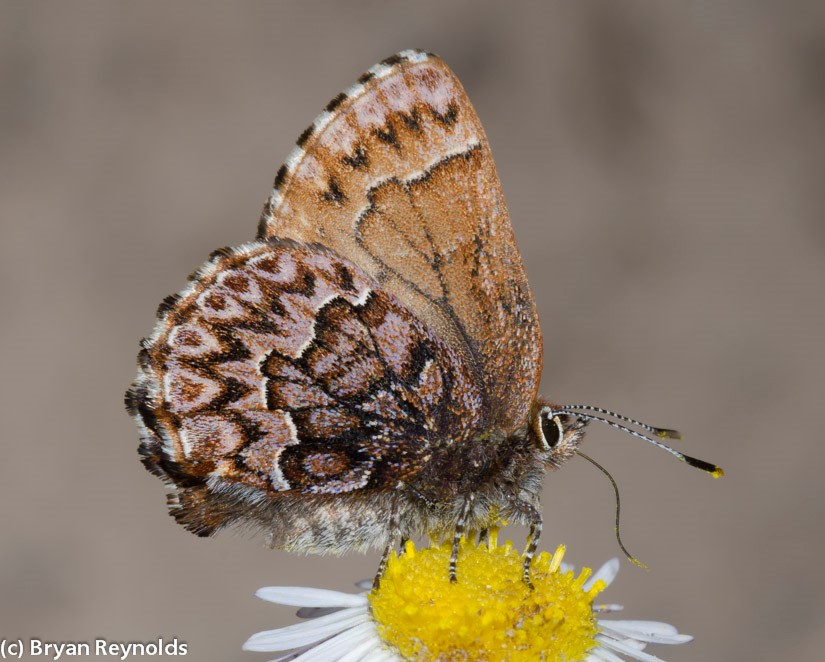
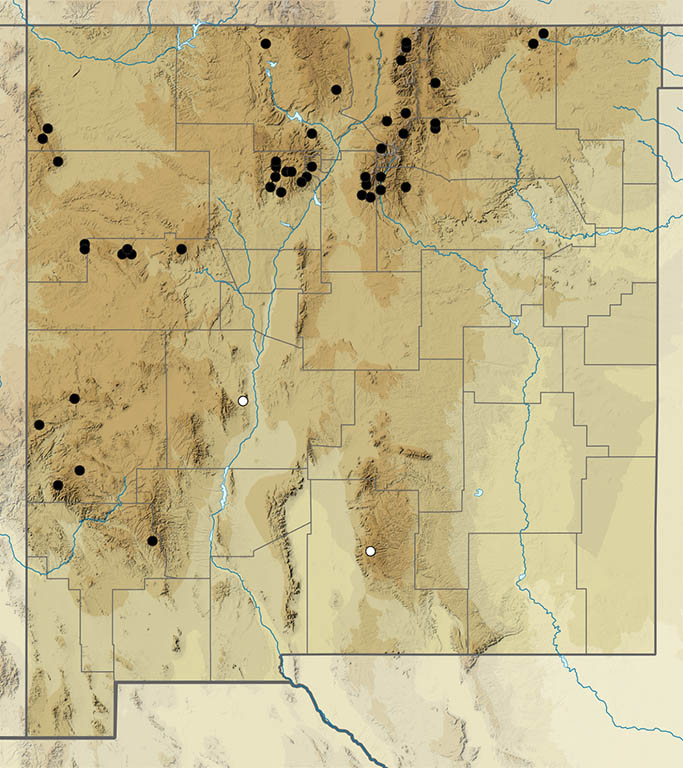
Callophrys mcfarlandi P. Ehrlich & Clench 1960 Sandia Hairstreak (updated April 24, 2022)
Description. Underneath, this iconic New Mexico butterfly is bright, iridescent green with marginal and submarginal white lines enclosing dark and violet scaling. Dorsal colors are muted gray-gold. Range and Habitat. Callophrys mcfarlandi was discovered in the Sandia Mountains foothills in 1959. New Mexico encompasses nearly all of its US range. In Upper Sonoran Zone habitats is regular east of the Rio Grande, but more localized to the west, 4200-7200’ (all counties except Ca,Gr,Hi?,Le,LA,MK,RA,SJ,Ta), with confirmation needed for a Hidalgo County sighting of larvae on the host, which could have been the polyphagous Gray Hairstreak. This Hairstreak occurs in west Texas, south into Mexico, and a colony was recently discovered just north of the Colorado border in the Mesa de Maya area. Life History. Larvae have a very restricted diet, eating only flowers and developing seeds of Texas beargrass (Nolina texana var. compacta; Agavaceae). The similar Nolina microcarpa is widespread in southwest New Mexico and Arizona, but it blooms in late in summer, which apparently is a deal-killer. Pupae overwinter. Flight. Adults fly in an extended spring brood spanning February 9 to July 4, peaking in April. It generally flies for only a month in any given location, the timing driven by local weather. A rare partial summer emergence is represented by very scarce July, August and October sightings. After a dry winter, the Nolina may not bloom and C. mcfarlandi pupae may choose to remain in diapause for another year, or another. Sandia Hairstreaks perch and nectar near host plants. Comments. The first Sandia Hairstreak was collected near High Rolls (Ot) on 12 June 1902, but the specimen languished. Callophrys mcfarlandi was finally described in 1959 [1960] from specimens taken in the foothills of the Sandia Mountains. This most famous of New Mexico’s green hairstreaks was adopted as New Mexico’s State Butterfly in 2003. I like to call it the New Mexico Hairstreak, but that introduces another potentially unhelpful name into the system.
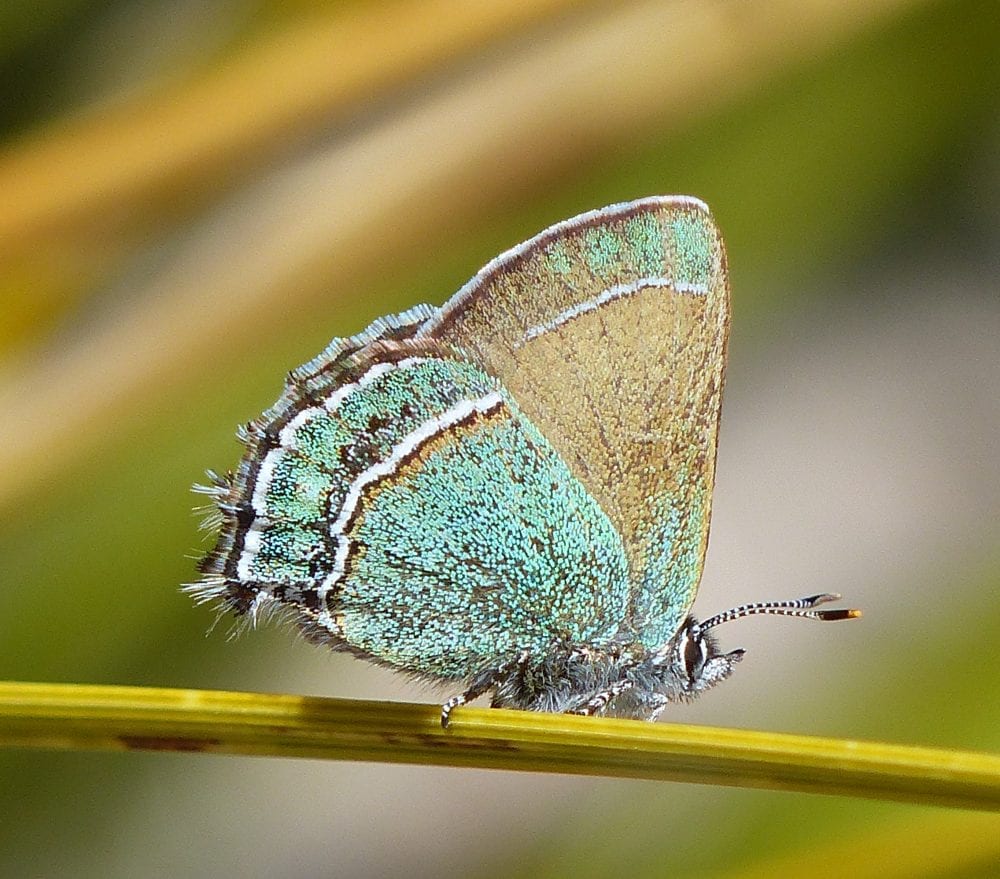
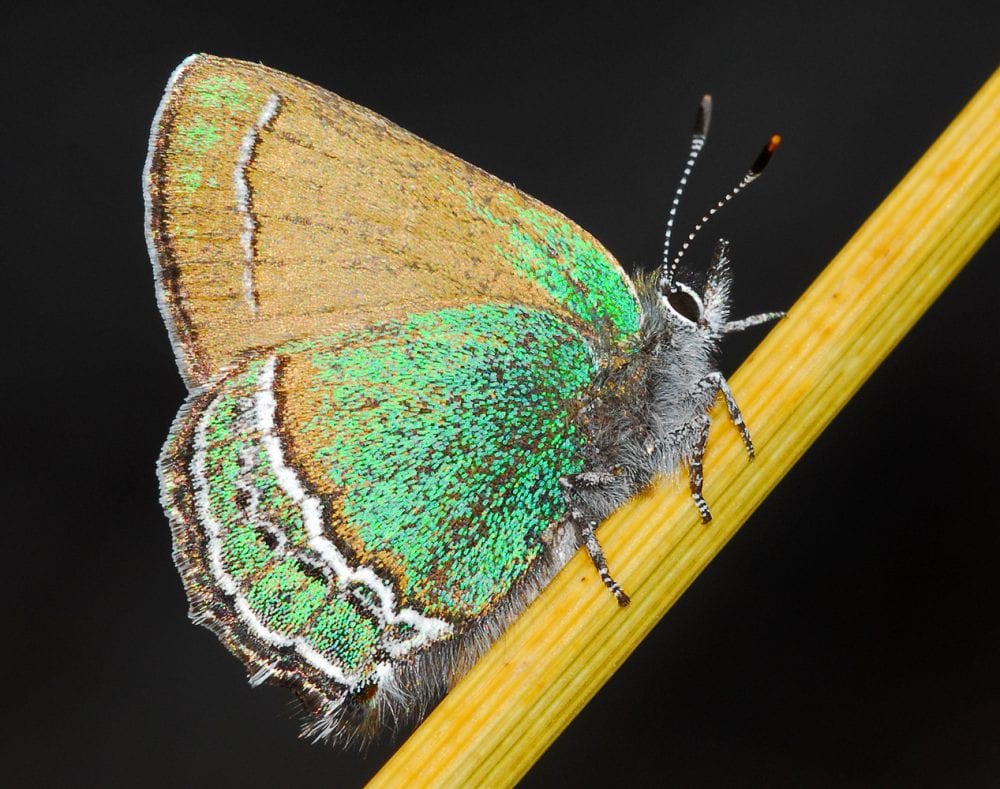
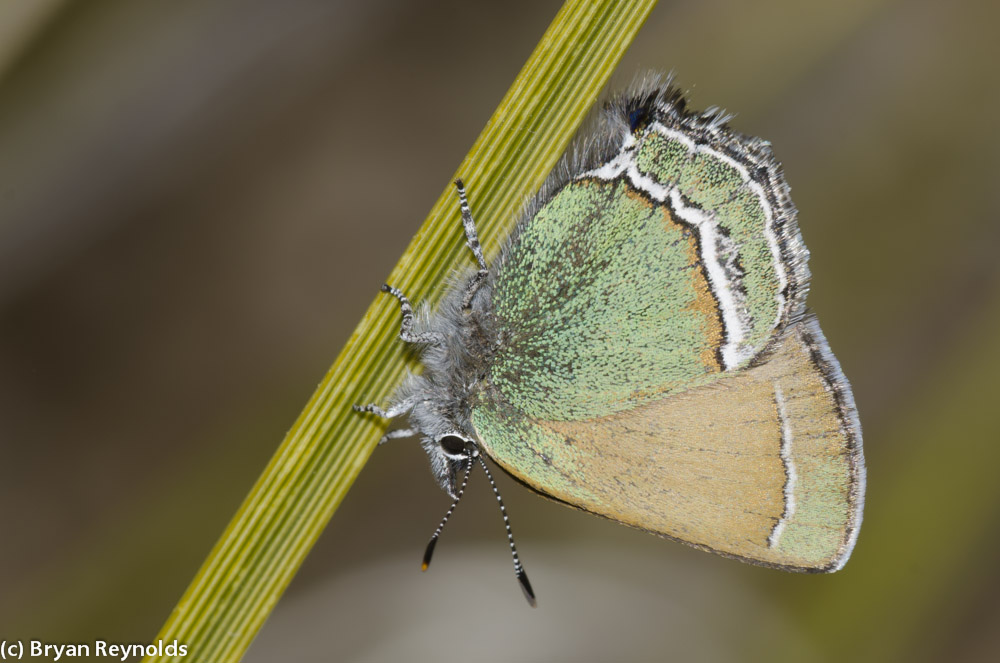
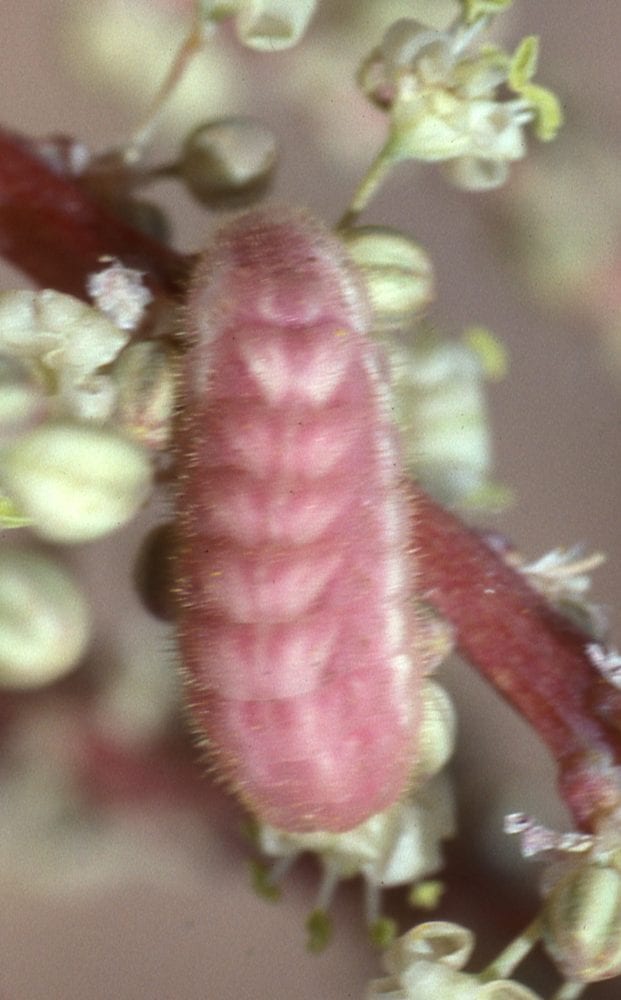
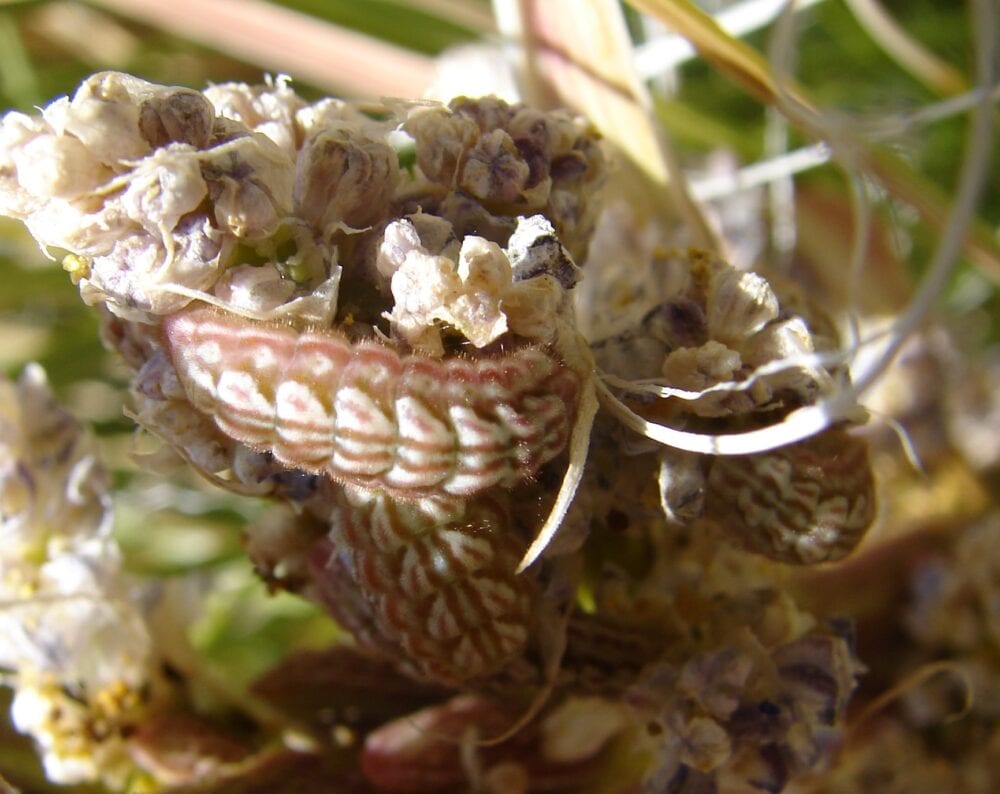
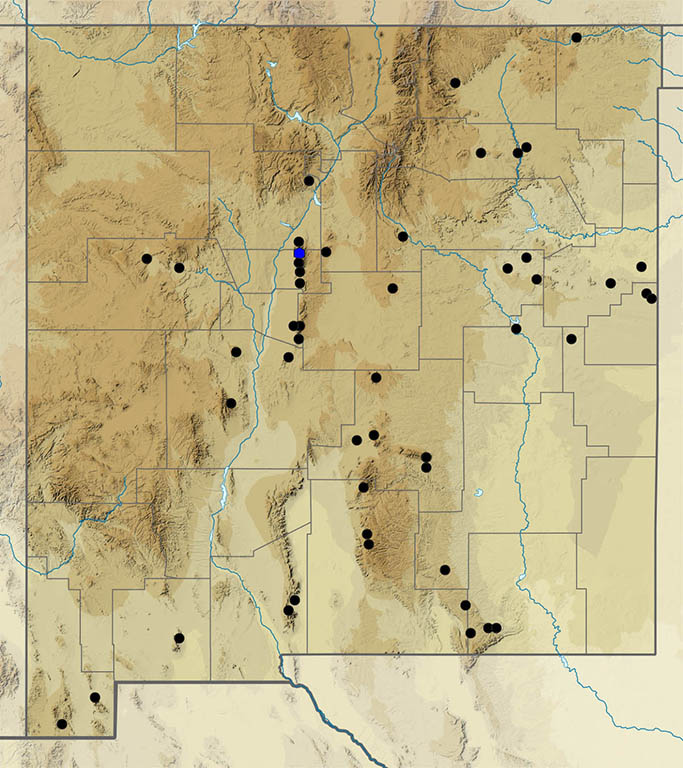
Callophrys xami (Reakirt [1867]) Xami Hairstreak (updated April 11, 2022)
Description. Xami looks a fair bit like Callophrys gryneus with a more olive-green ventral ground color. The prominent hindwing postmedian white line is smooth on the basal side but is formed into an unmistakable “W” at the tornus, thus accentuating the tails and the false head. Range and Habitat. Xami is a Mexican species whose range extends into the southwest US in southern Arizona, southwest Texas and southwest New Mexico (counties: Gr). Its colonies are very local in Upper Sonoran cliff country where the larval hosts grow and where finding new colonies can be very challenging. Life History. Larvae eat succulent Crassulaceae, including Sedum species and Echeveria species. Hosts in Arizona and New Mexico appear to be the scarce cliff specialists Graptopetalum bartramii, G. rusbyi and a Sedum species. One supposed host, Sedum cockerellii (Bailowitz & Brock 2022), has a fairly wide distribution in New Mexico, but the Graptopetalum species seem to have a much more limited distribution. Finding the hosts is key to finding more colonies of this hairstreak. Flight. Several generations are passed each year near Mexico City. In New Mexico we expect two or three broods. Our one record with data is for 22 April 1989, but flight peaks also could occur in July and October. Adults come to nectar, but do not wander far from cliff-dwelling larval hosts. Comments. Kilian Roever discovered this species in New Mexico at the Apache Box (Gr). Xami should occur in other cliffy southwest New Mexico desert mountains, too, but so far, no other colonies have been located.
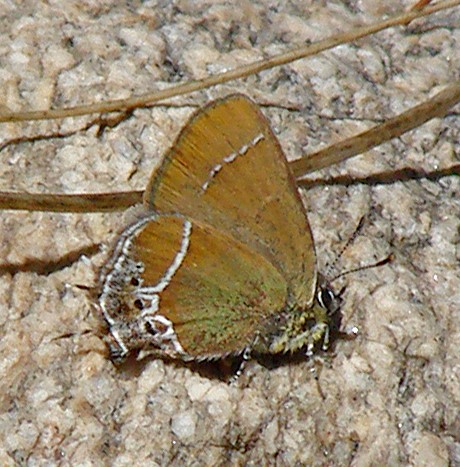
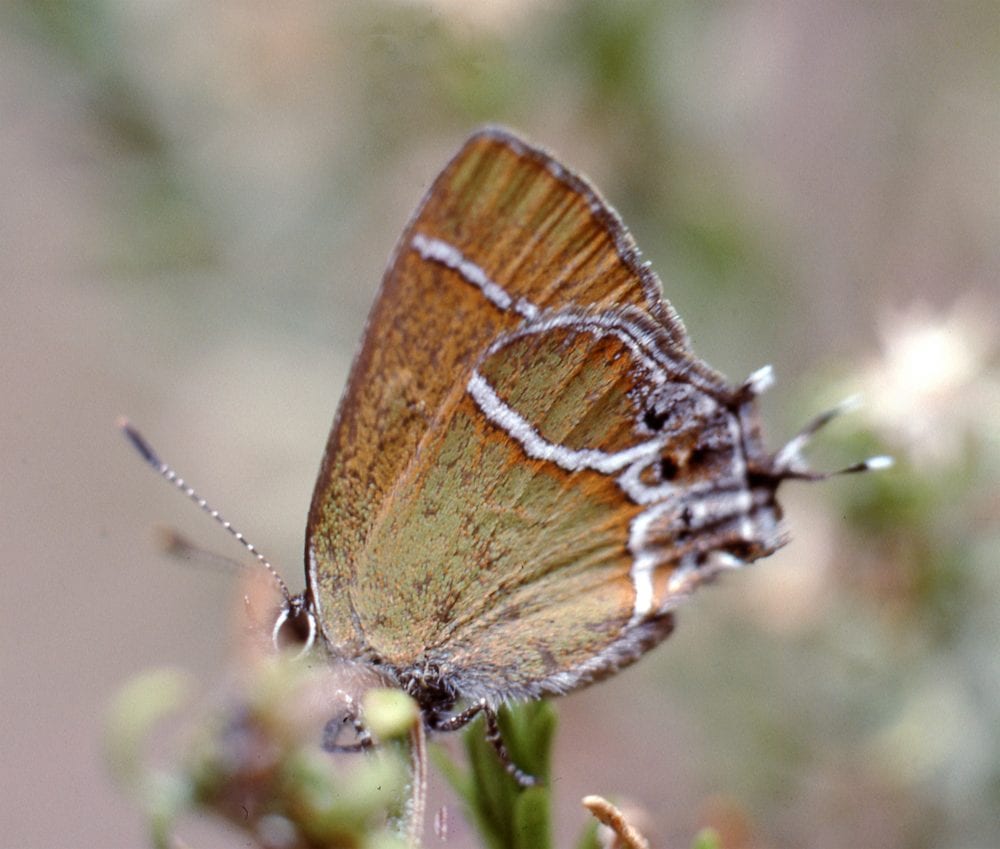
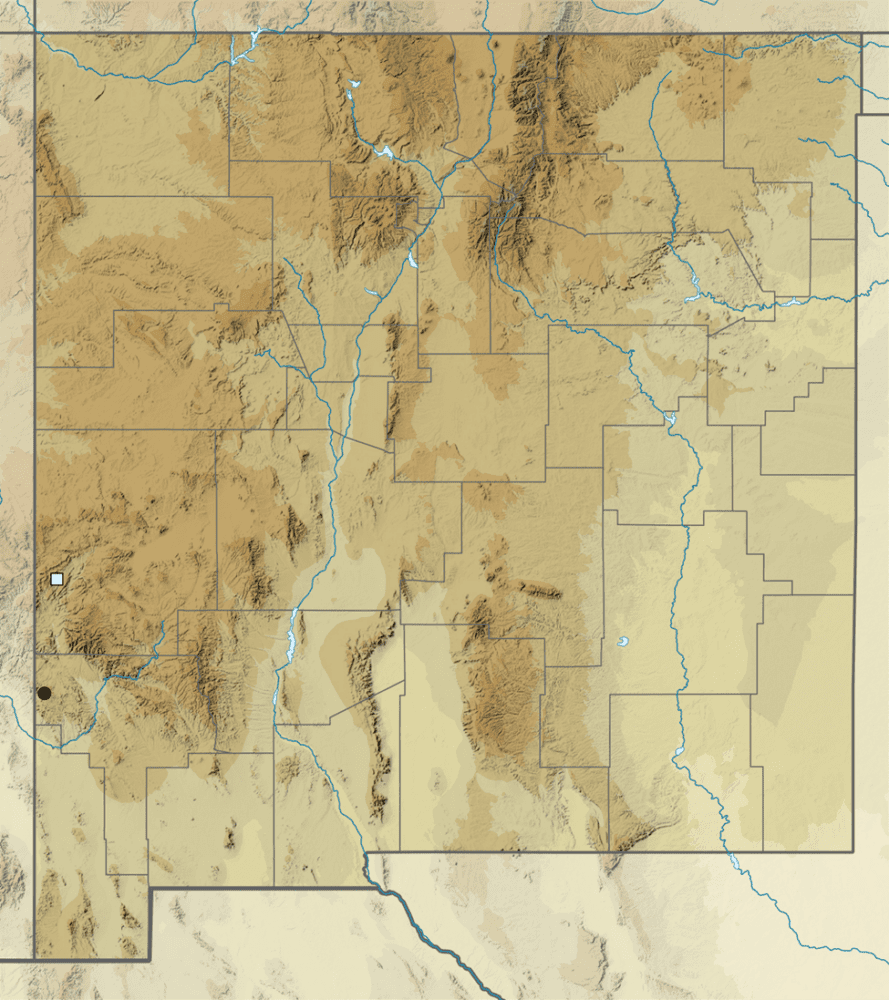
Callophrys sheridanii (W. H. Edwards 1877) Sheridan’s Hairstreak (updated May 4, 2025)
Description. Sheridan’s Hairstreak is emerald green below, fading to gray as it wears over time. The hindwing white line is regular and nearly continuous. This fingernail-sized butterfly is gray above, not brown as is Bramble Hairstreak (see chart below). Range and Habitat. Sheridan’s Hairstreak lives in the Great Basin from Washington to California and east to the Rockies. Satellite colonies occur in North Dakota, Nebraska, Arizona and New Mexico. Here it occurs from 7000 to 10,000′ in the Sierra Blanca Range (Li,Ot) and the Tusas Mountains (RA) near Chama and Canjilon. Life History. Larvae eat various wild buckwheats, or Eriogonum spp. (Polygonaceae), two of which we know. Eriogonum wootonii is the host in the Sacramentos (Li,Ot). Eriogonum jamesii v. jamesii is suspected near Chama (RA). Larvae eat Eriogonum umbellatum elsewhere in the Rockies, but that pant seems too scarce to be a significant host in N NM. Flight. The single annual brood flies from April 9 to July 5, peaking in April at low sites, in May – June at higher sites. Sheridan’s Hairstreaks fly and bask near the ground, occasionally feeding at nectar and wet soil. Comments. Northern New Mexico has the nominate race. Our other population is Callophrys sheridanii sacramento Scott 2006, which is larger with a narrower hindwing white band and with more extensive ventral gray (Scott 2006). Our oldest specimen is in the US National Museum from Cloudcroft (Ot), taken on 11 May 1902 by Henry L. Viereck.
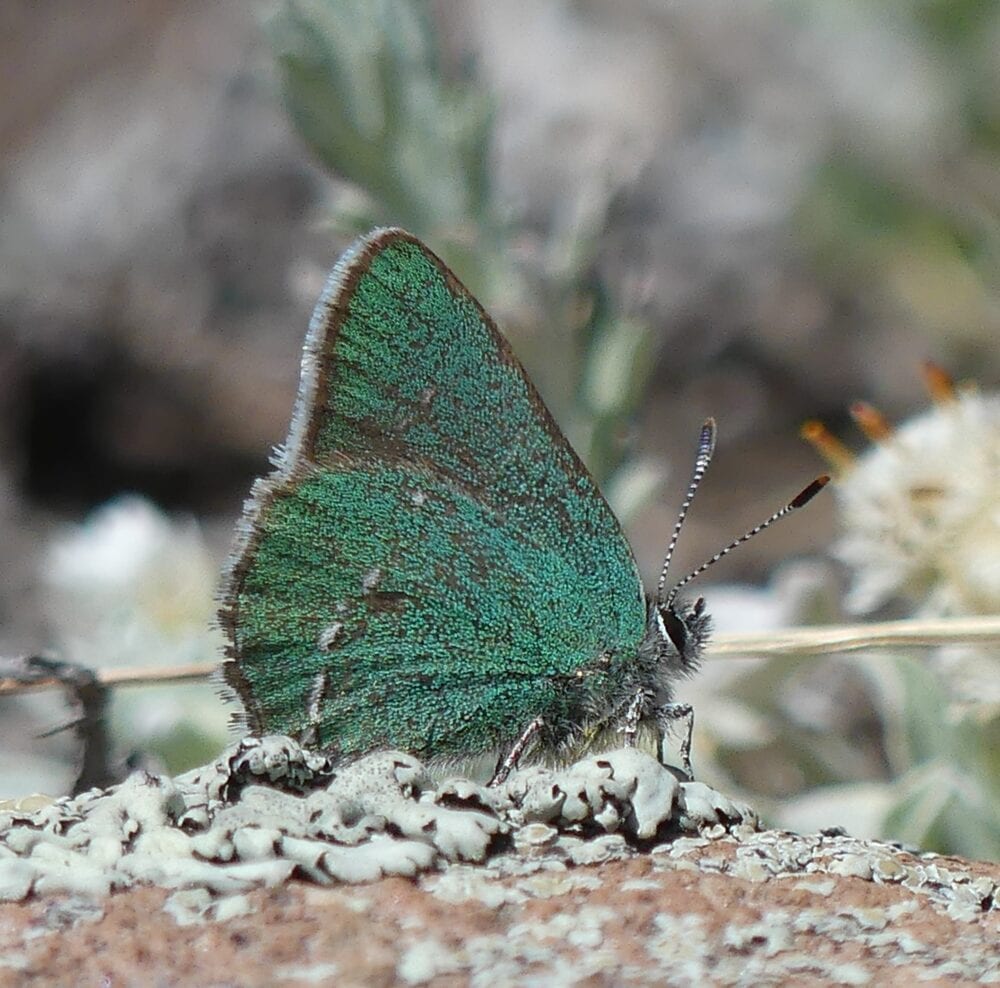
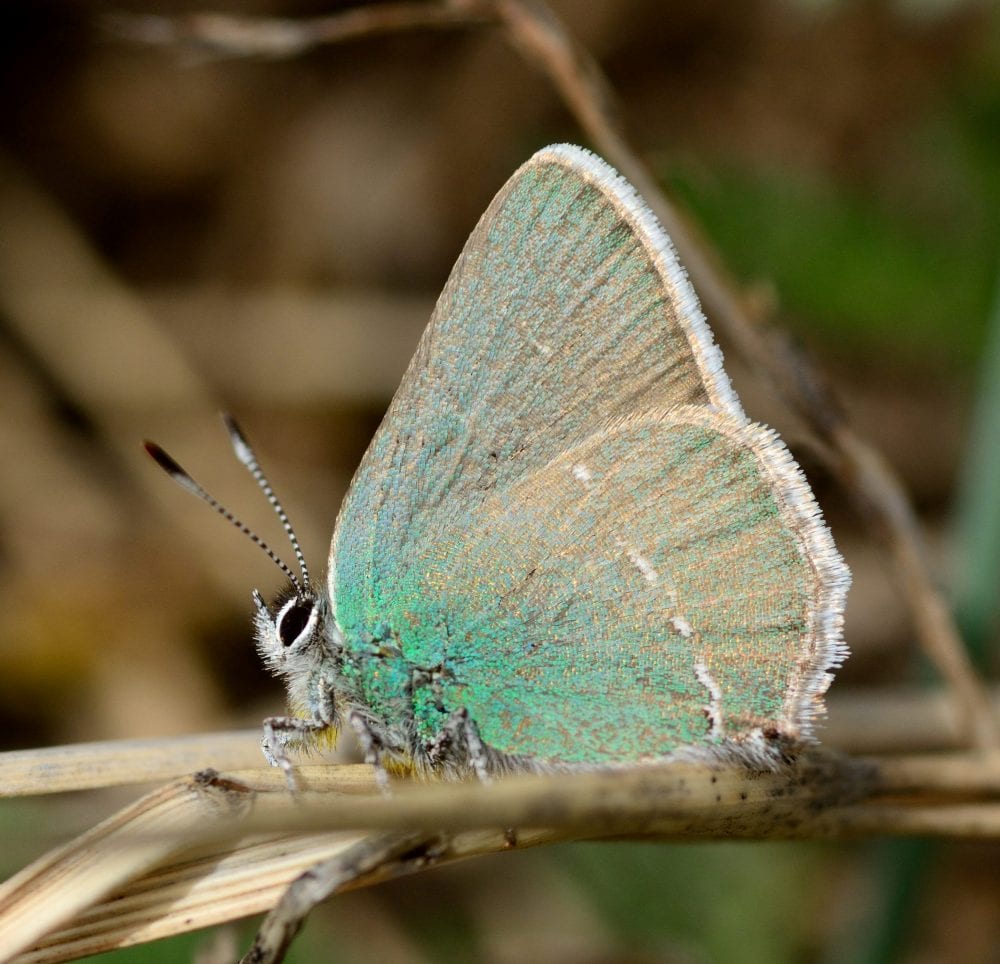
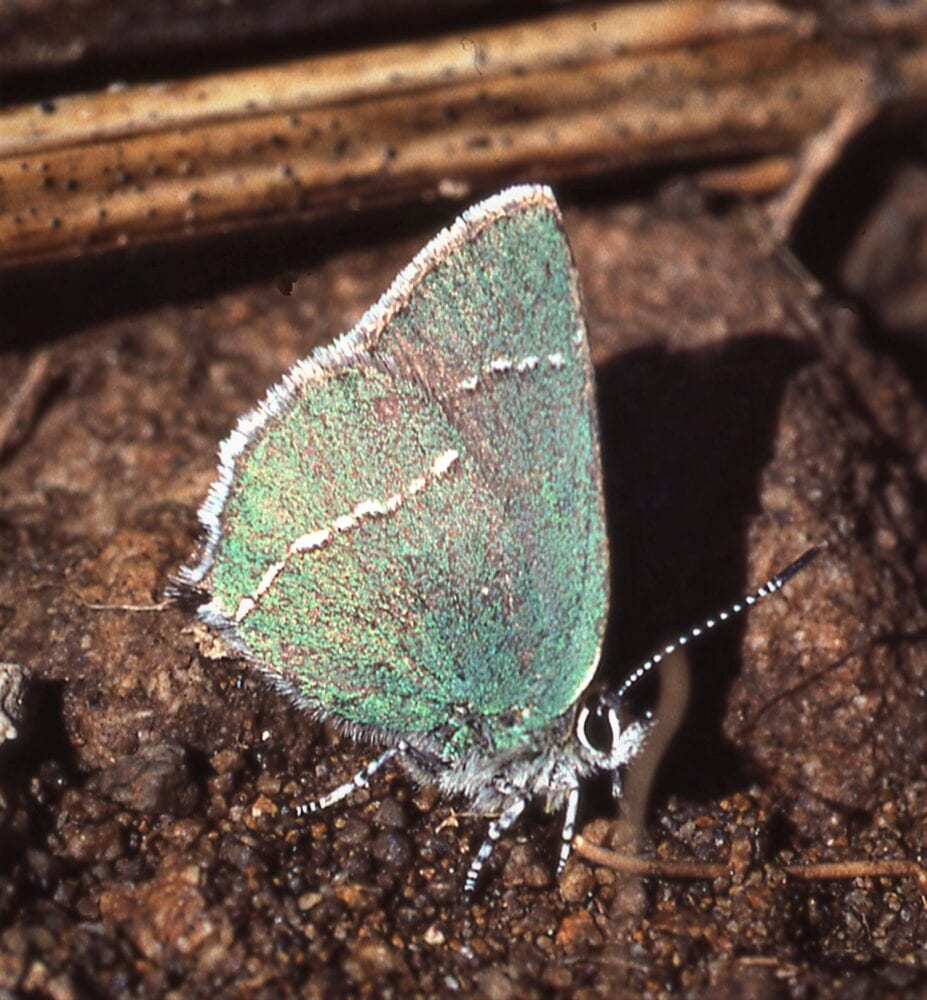
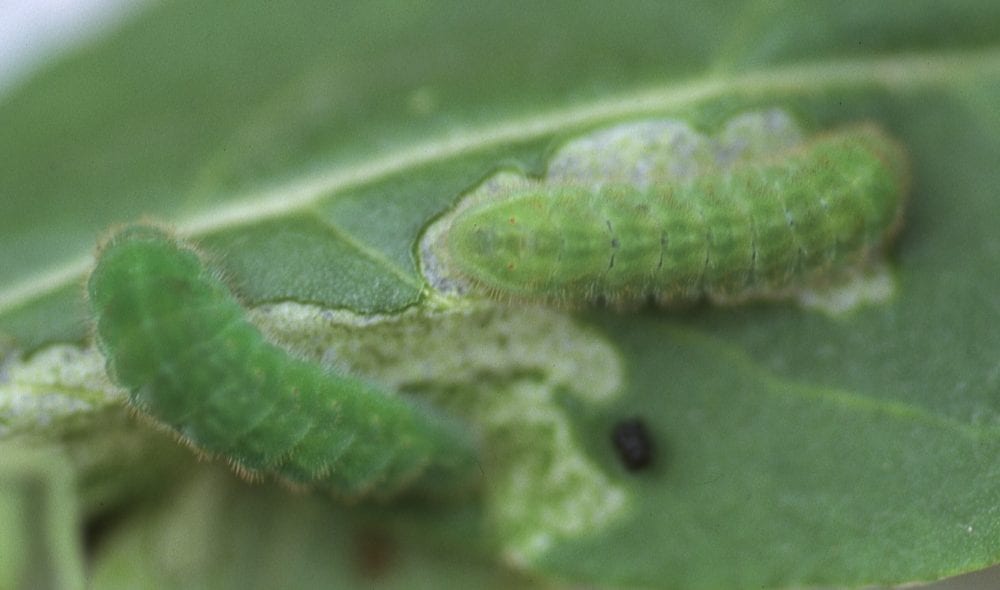
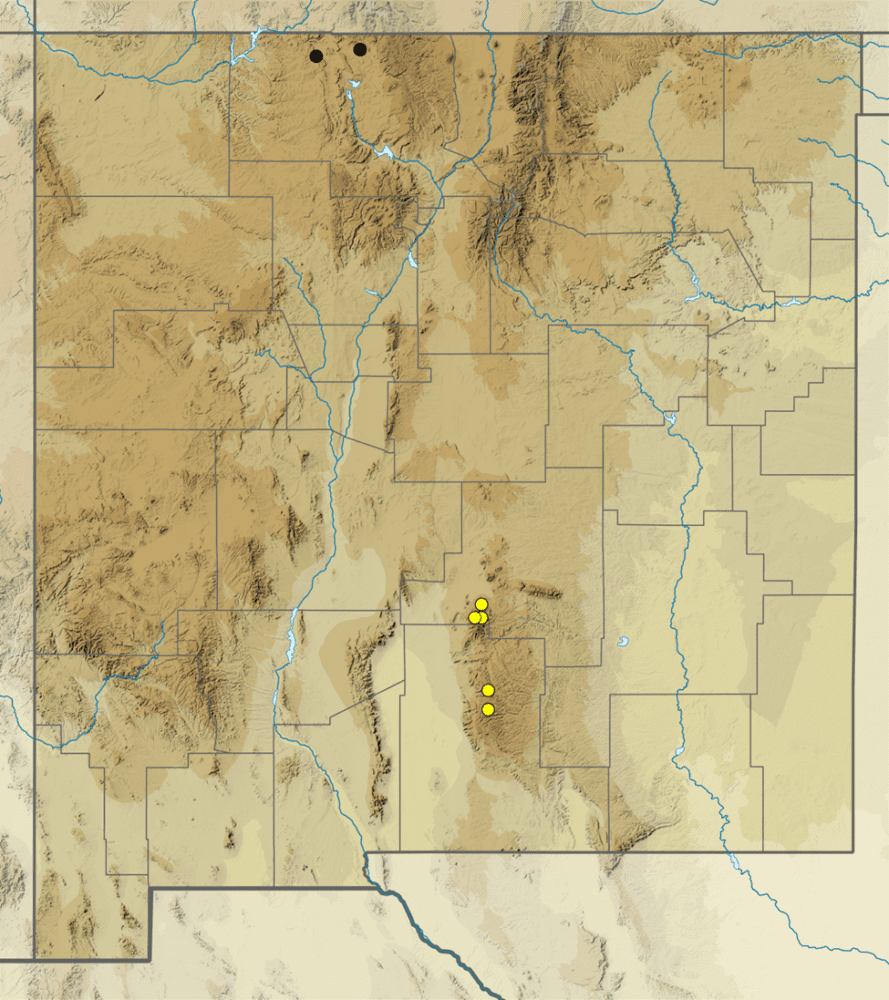
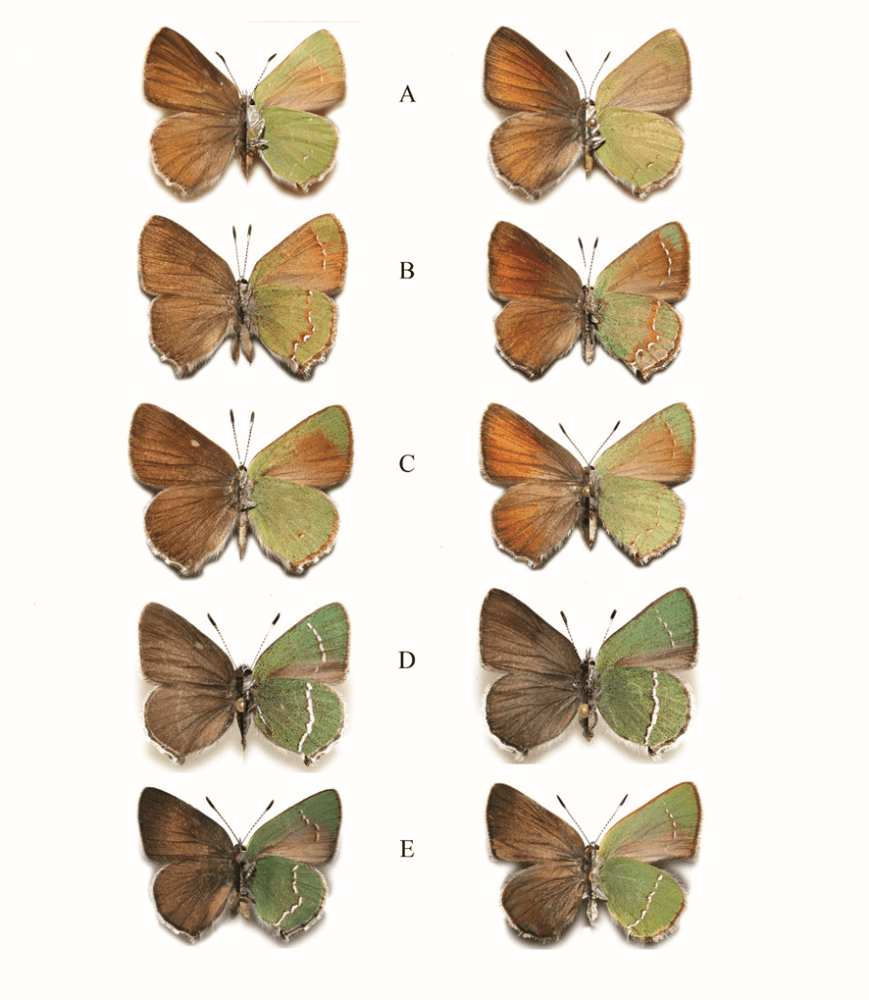
Callophrys affinis (W. H. Edwards 1862) Bramble Hairstreak (updated April 20, 2022)
Description. Bramble Hairstreaks are green below and rust-brown above, compared to the gray of Sheridan’s (see comparison above). An irregular band of brown-edged, white spots crosses the tailless ventral hindwing. The ventral white spots (when present) tend to be more disconnected in affinis compared to sheridanii, although the Sacramento Mountains version of sheridanii approaches the apama version of affinis in this character. Since the two species are distinct in that mountain range, observers should be able to tell them apart (see comparison figure to be sure). Range and Habitat. Brambles live in the central Rockies south to the Mexican Sierra Madre, including all our major mountains (counties: Ca,Ci,Co,Gr,Li,LA,MK,Ot,RA,Sv,SJ,SM,SF,Ta,Un), usually 6500 – 9000′ elevation. Life History. Fendler’s buckbrush (Ceanothus fendleri; Rhamnaceae) is a major host; larvae also eat buckwheats (i.e., Eriogonum alatum; Polygonaceae) east of the Continental Divide. Larvae on Eriogonum alatum are yellow-green, turning red as flowers go to seed. As with most hairstreaks and blues, ants tend larvae. Because its host plants thrive in frequent-fire landscapes, Callophrys affinis is considered a fire-climax butterfly. Flight. Callophrys affinis is bivoltine. Flights peak in May and July in southern New Mexico, but later farther north. Early and late dates are April 14 and August 31. Adults often perch on Ceanothus fendleri and nectar at its flowers. Comments. Gorelick (2005) showed that Callophrys apama (W. H. Edwards) is a subspecies of Callophrys affinis. Western New Mexico has Callophrys affinis apama (W. H. Edwards 1882) with a prominent white hindwing band. South-central New Mexico (Li,Ot) adults have a nearly immaculate hindwing and are Callophrys affinis albipalpus Gorelick 2005. The two forms converge in our north-central mountains where the hindwing spot band is variable and adults are placed with subspecies Callophrys affinis homoperplexa W. Barnes & Benjamin 1923.
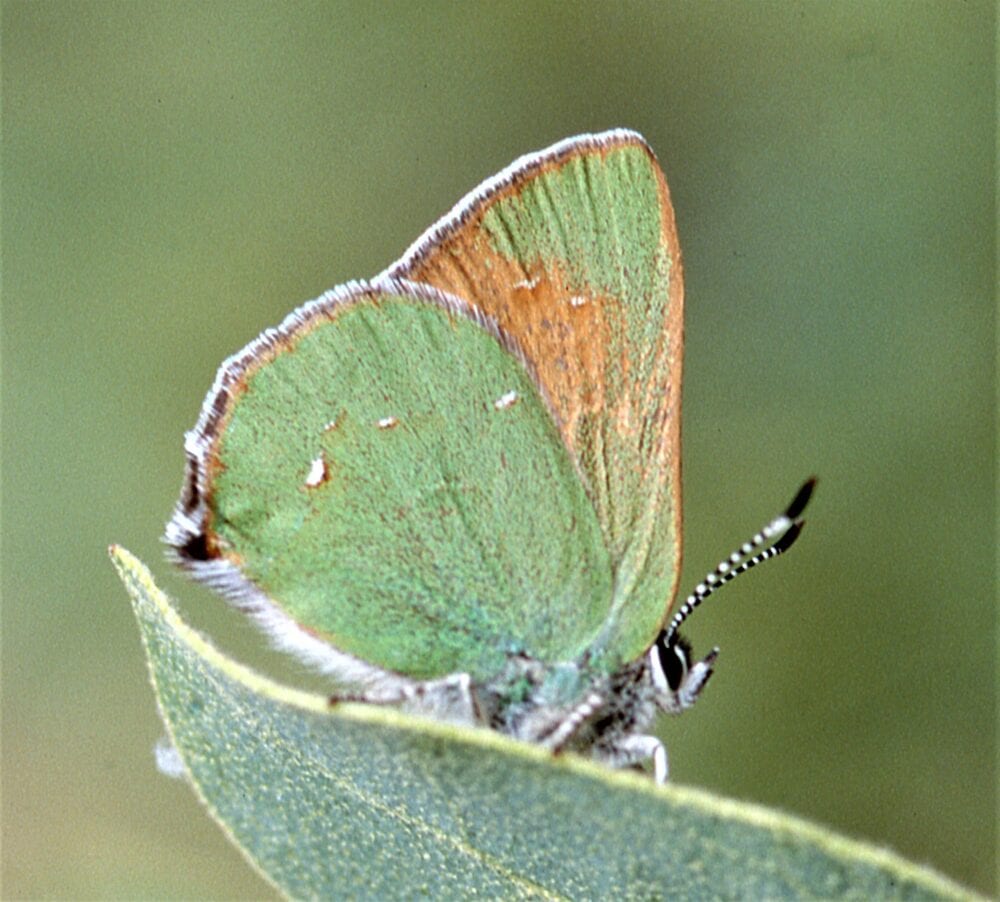
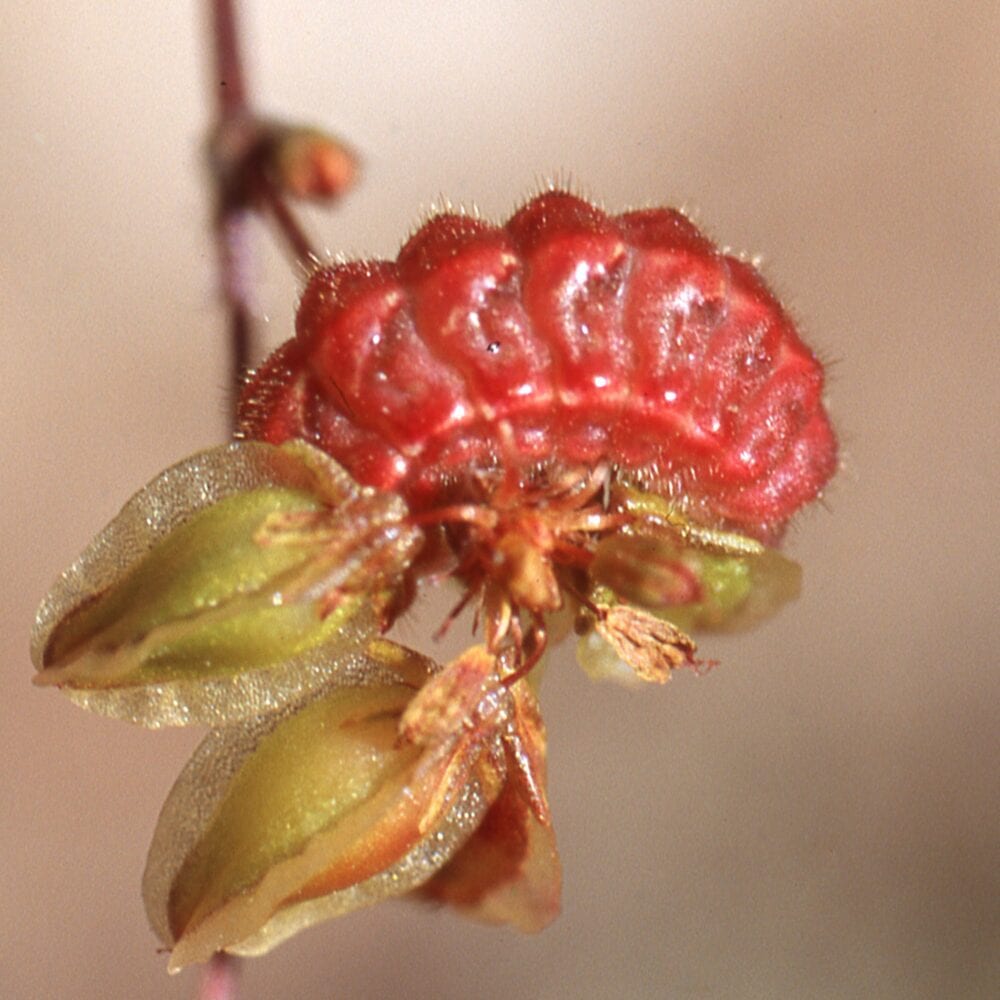
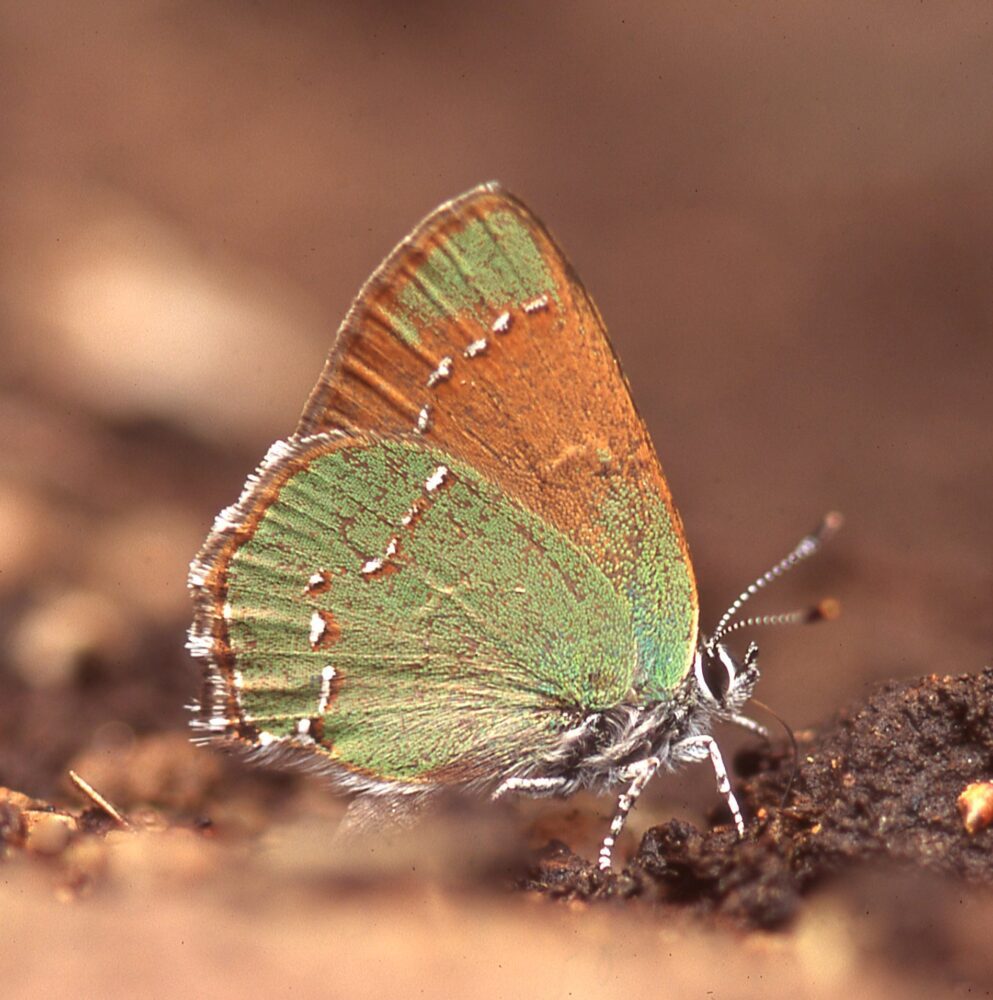
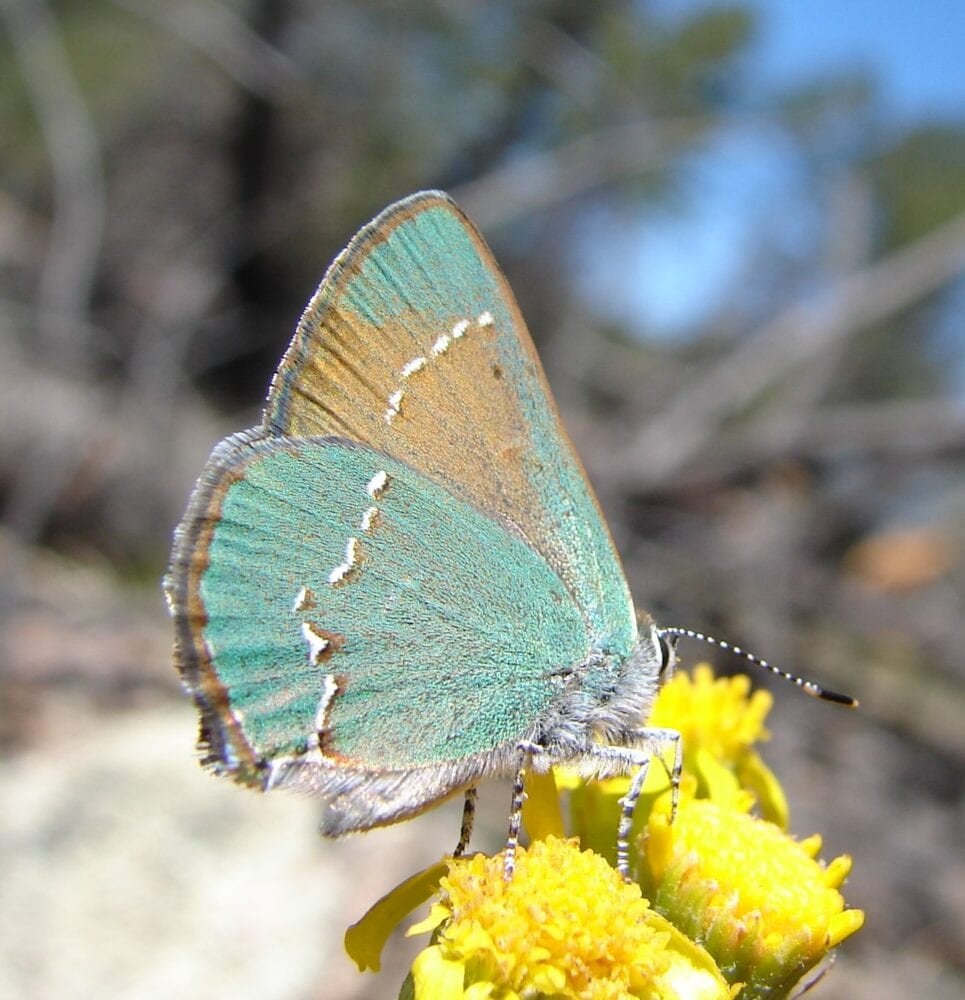
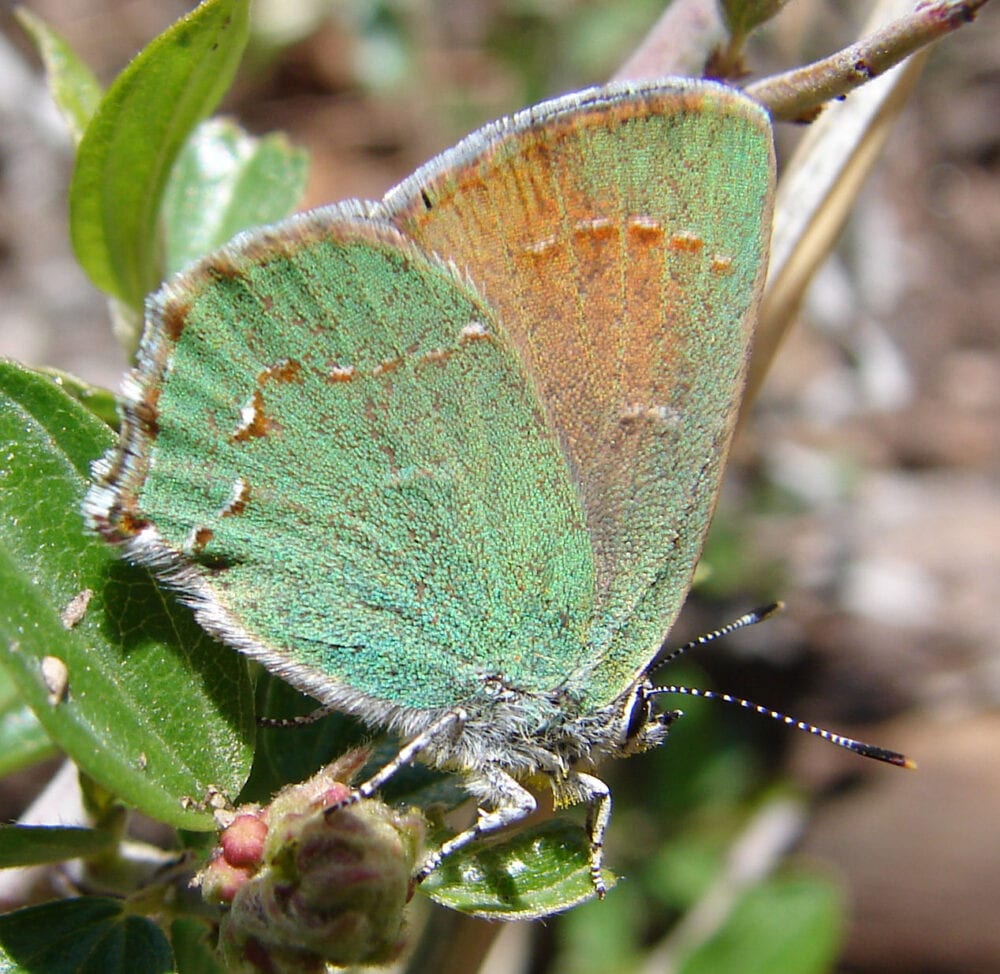
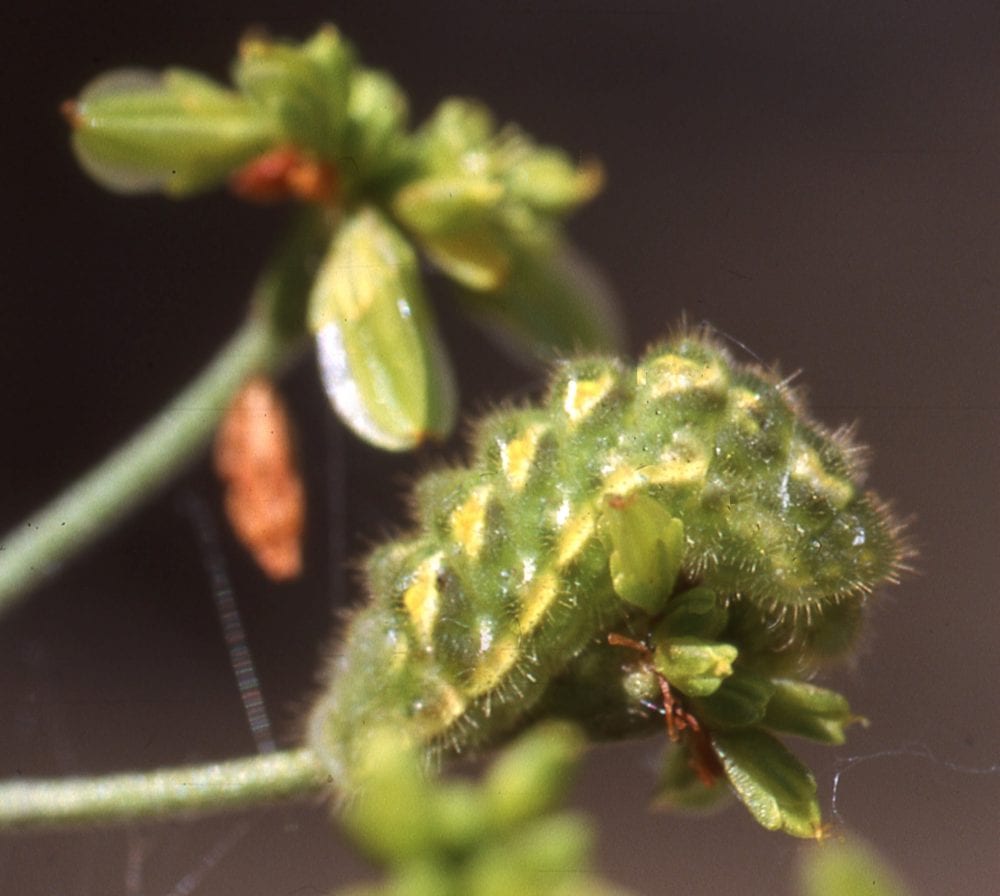
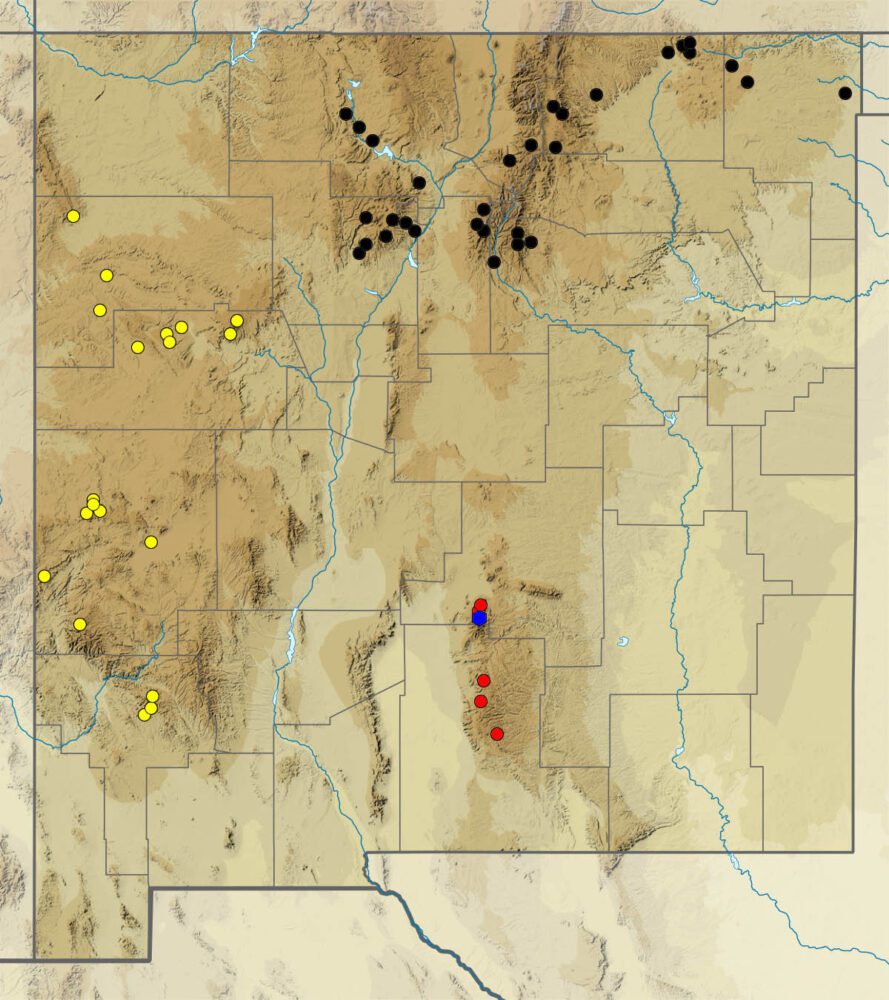
Chlorostrymon simaethis (Drury 1773) Silver-Banded Hairstreak (updated April 15, 2022)
Description. Chlorostrymon simaethis looks at first glance like Juniper Hairstreak, but examination of the hindwing shows a single postmedian silver band against a gray-maroon area near the tails on an olive-green background. Males are iridescent purple above; females gray. Range and Habitat. Silver-banded Hairstreaks occupy subtropical scrublands in Mexico and far south Texas, but they do wander a bit, straying rarely to southern California, southern Arizona, and southern New Mexico. Jeff Glassberg gave us our first sighting, near Oliver Lee Memorial State Park (Ot) on 13 May 1998. Rob Wu saw two nectaring at native Buddleia marrubifolia in Las Cruces (DA) on 21 and 22 May 2020. One was worn, the other fresh, which suggests they may have been breeding in that general area. A few days later, Rita Herbst photographed Chlorostrymon simaethis in Silver City (Gr). Life History. Larvae eat balloon-vine (Cardiospermum in the family Sapindaceae), but reproduction has been considered unlikely in New Mexico. Flight. Our specimens have all been seen in May, and that fits with what Bailowitz and Brock (2022) found for SE AZ. Observers should be on the lookout in autumn, too, as the AZ folks have seen it from mid-September into November. Comments. Our subspecies is Chlorostrymon simaethis sarita (Skinner, 1895). The only seeming vagrant among our green hairstreaks, Silver-Banded is also our rarest, but a warmer climate increases the likelihood of seeing them here.
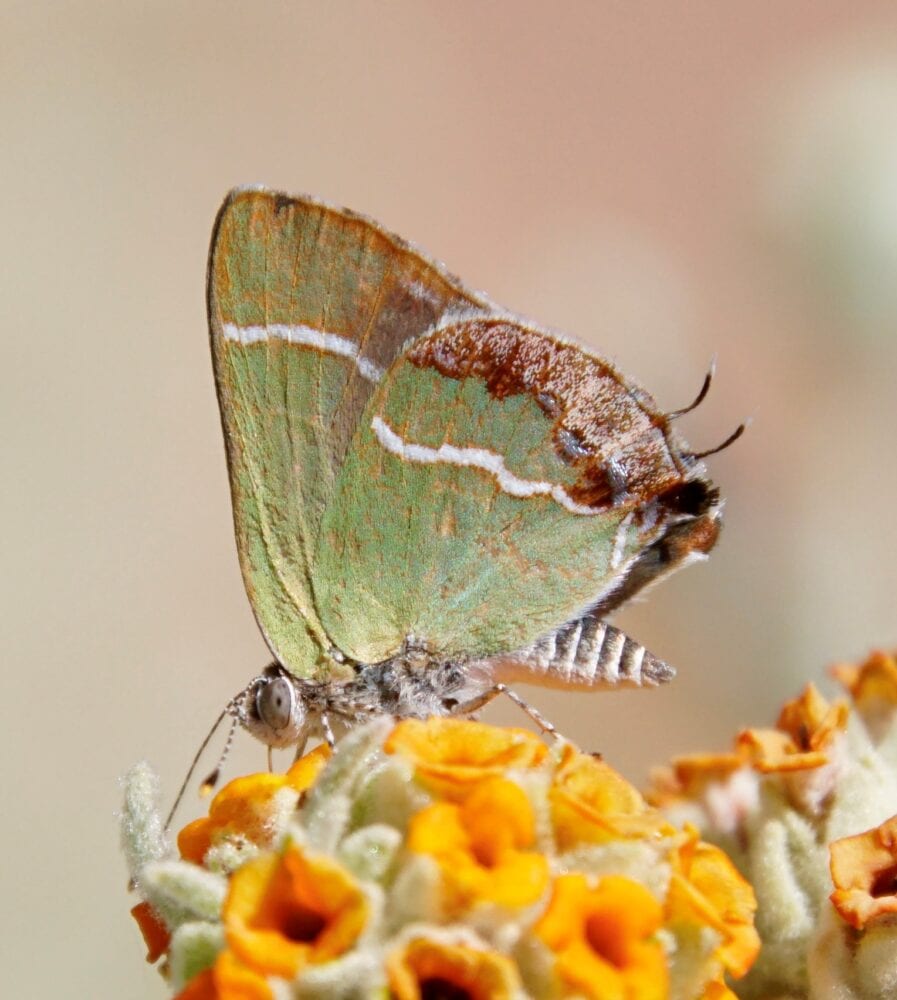
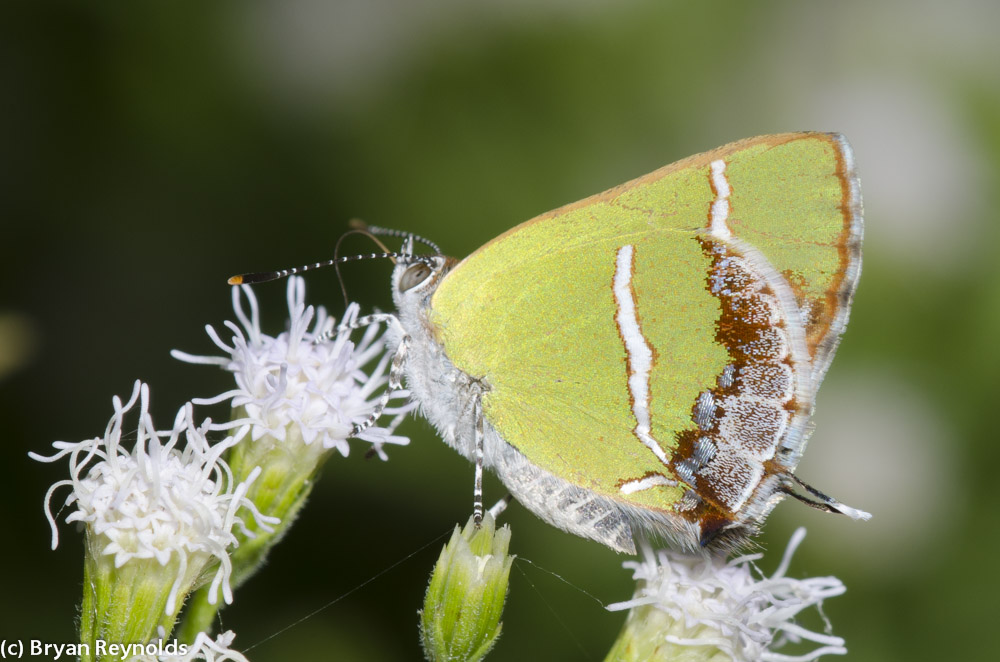
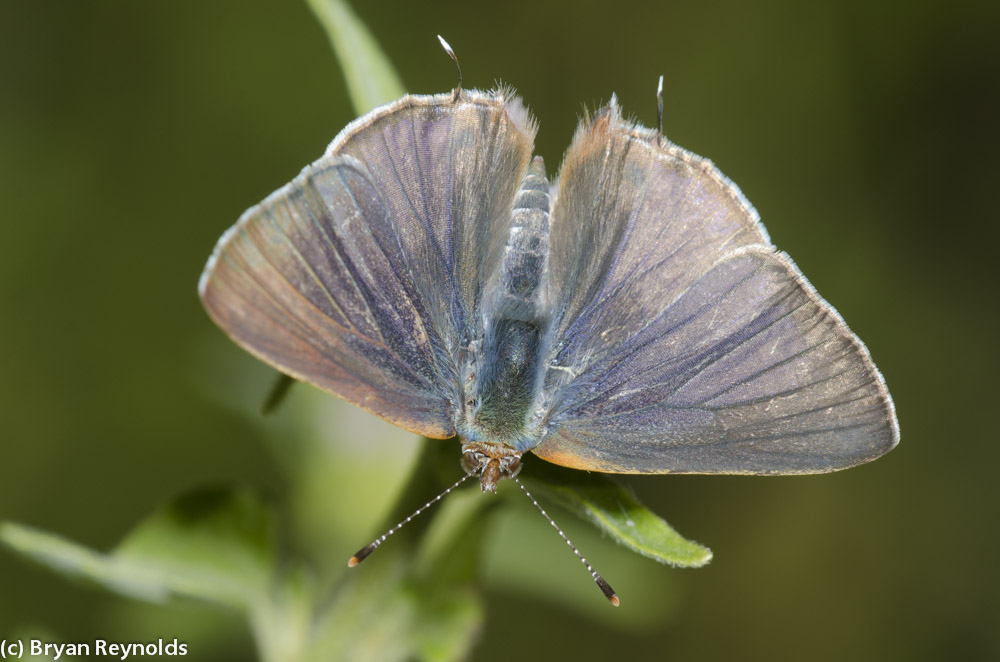
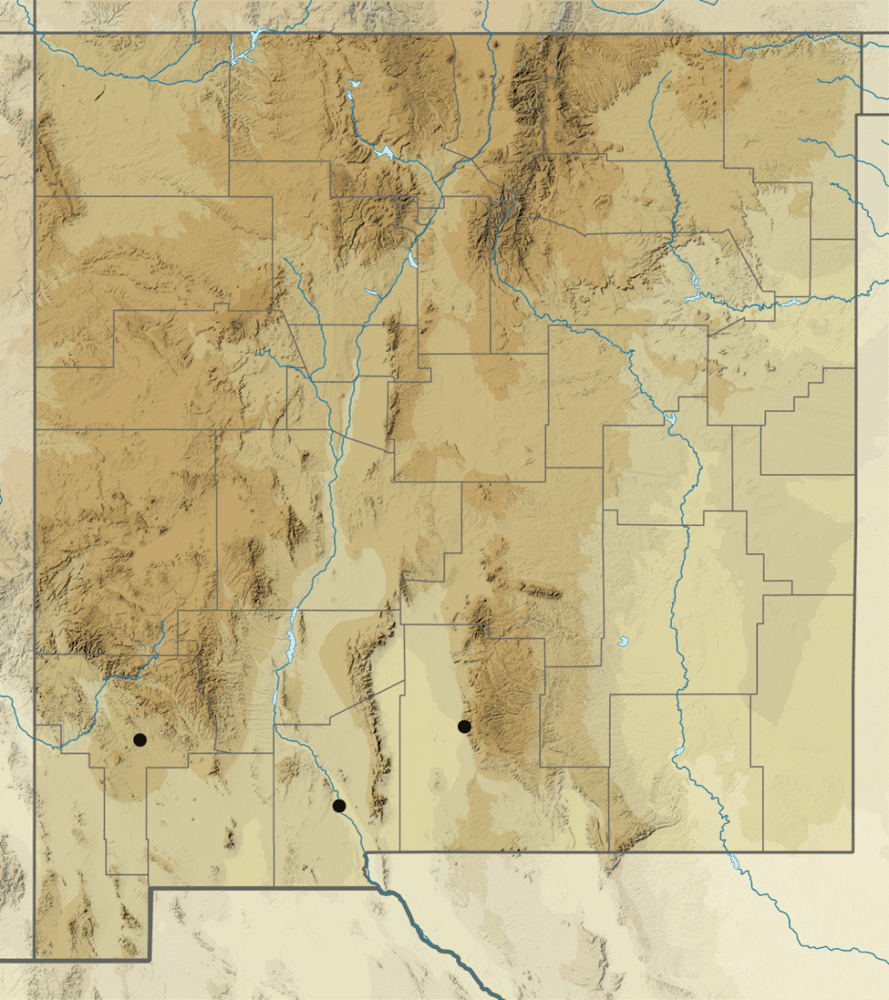
Erora quaderna (Hewitson 1868) Arizona Hairstreak (updated August 22, 2023)
Description. Arizona Hairstreak undersides are pale green to turquoise, with orange spots, all iridescent. On the topside, which they sometimes show you, males are black while females display sapphire basal scales and a cantaloupe-colored fringe. This is one of the “tailless” hairstreaks. Range and Habitat. Erora quaderna is distributed from Guatemala north along the Sierra Madre to Arizona, New Mexico and west Texas. In our state it inhabits open woodlands in southwestern and central mountains (counties: Ca,Gr,Hi,Lu,Si,So,To,Va), generally 5400 to 8500′ elevation. Hilltopping males have been found up to 10,000′ in the Black Range (Gr,Si). Life History. Like many hairstreaks, E. quaderna larvae eat nutritious reproductive flower parts. Because conditions can vary from year to year, and some host species may not bloom when desired, thus not providing the needed flowers, “many hairstreaks are known to be opportunistic when it comes to groceries” (Bill Beck 2024). Which is to say that females place eggs on different plant species in different seasons, years, or under different circumstances. Fendler’s buckbrush (Ceanothus fendleri; Rhamnaceae) is a documented larval host for this species. Unconfirmed plants on the larval menu include Arizona oak (Quercus arizonica) and Emory oak (Quercus emoryi) (both Fagaceae). Desert buckbrush (Ceanothus greggii) also merits a look. Flight. Arizona Hairstreaks are bivoltine. Adults fly in spring between March 11 and May 9, peaking in April. The summer brood flies between June 25 and August 15, peaking in July. Females are often seen at flowers (e.g., willows in spring) or wet sand. Males will puddle, too, but most stay on the hilltops and treetops. Comments. Our subspecies is Erora quaderna sanfordi dos Passos 1940.
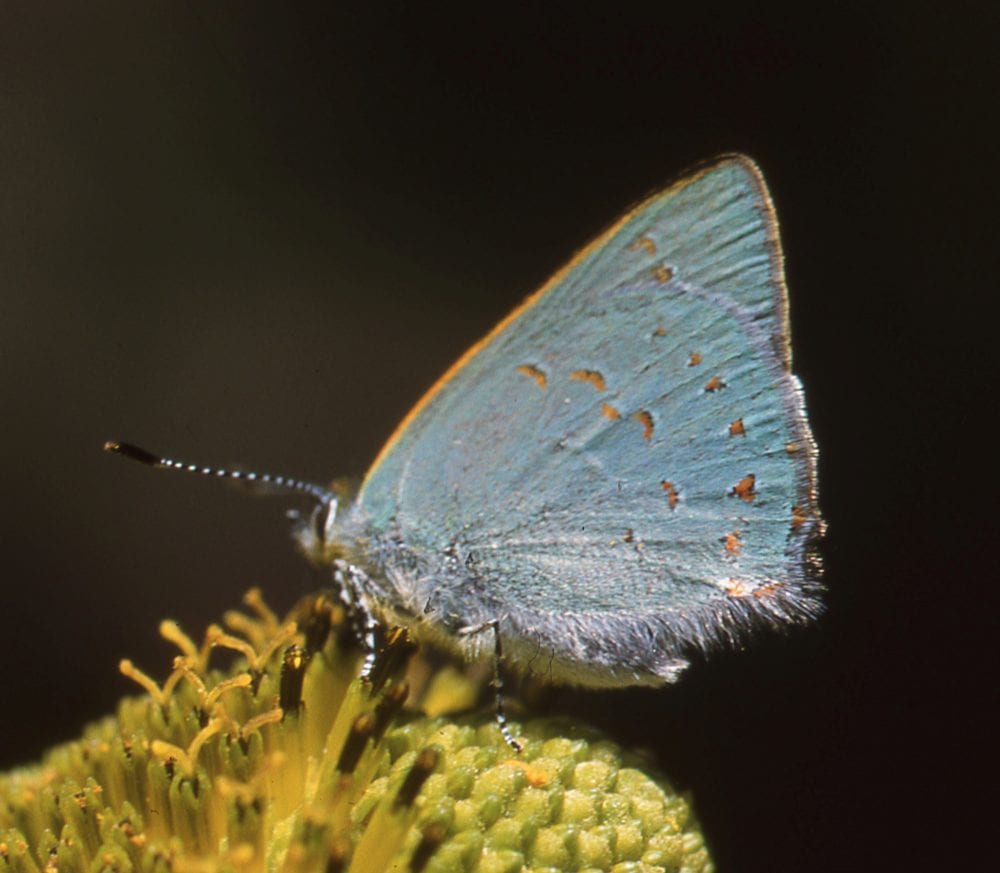
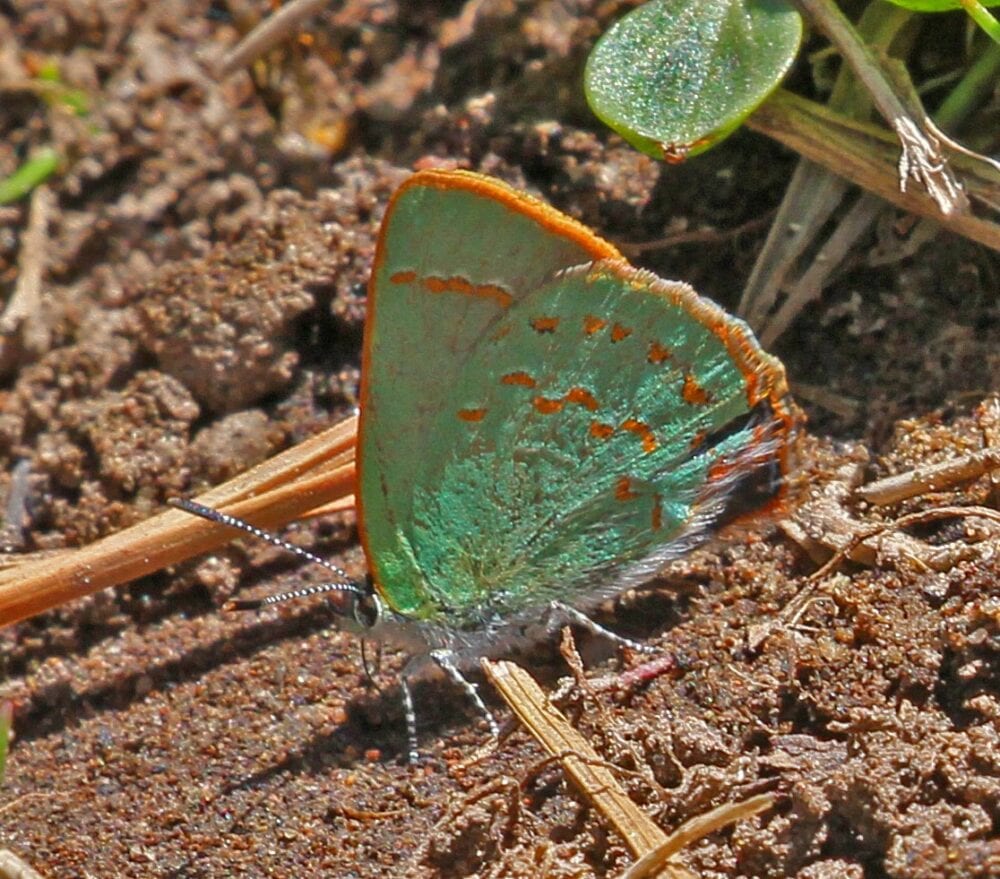
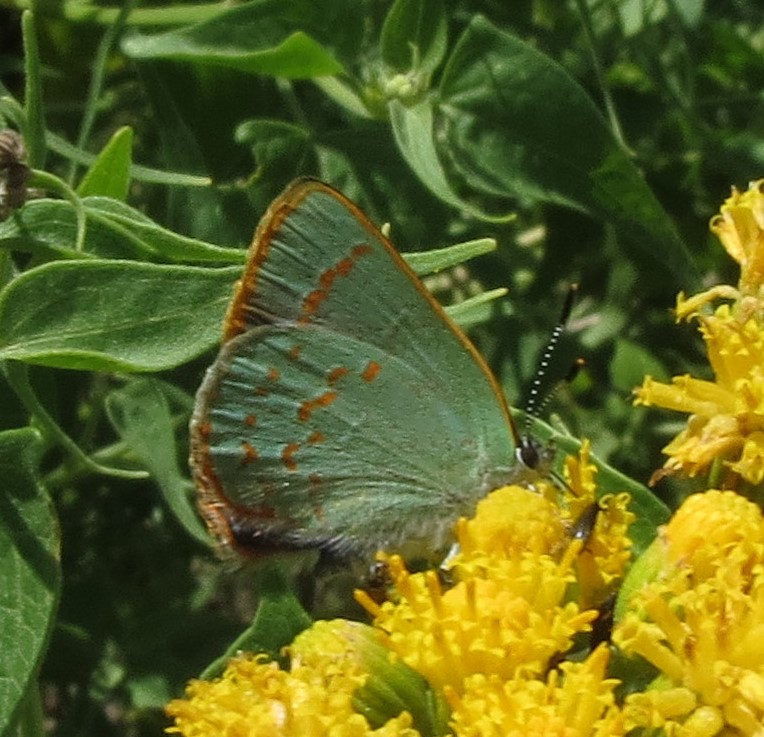
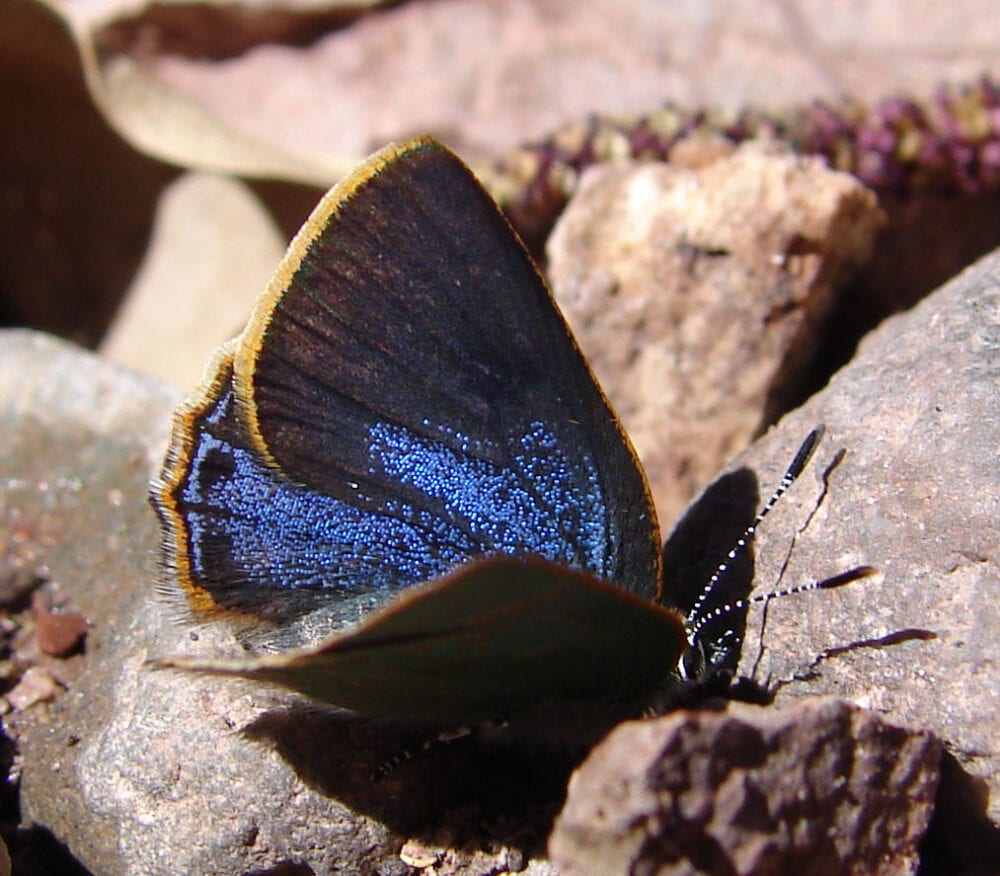
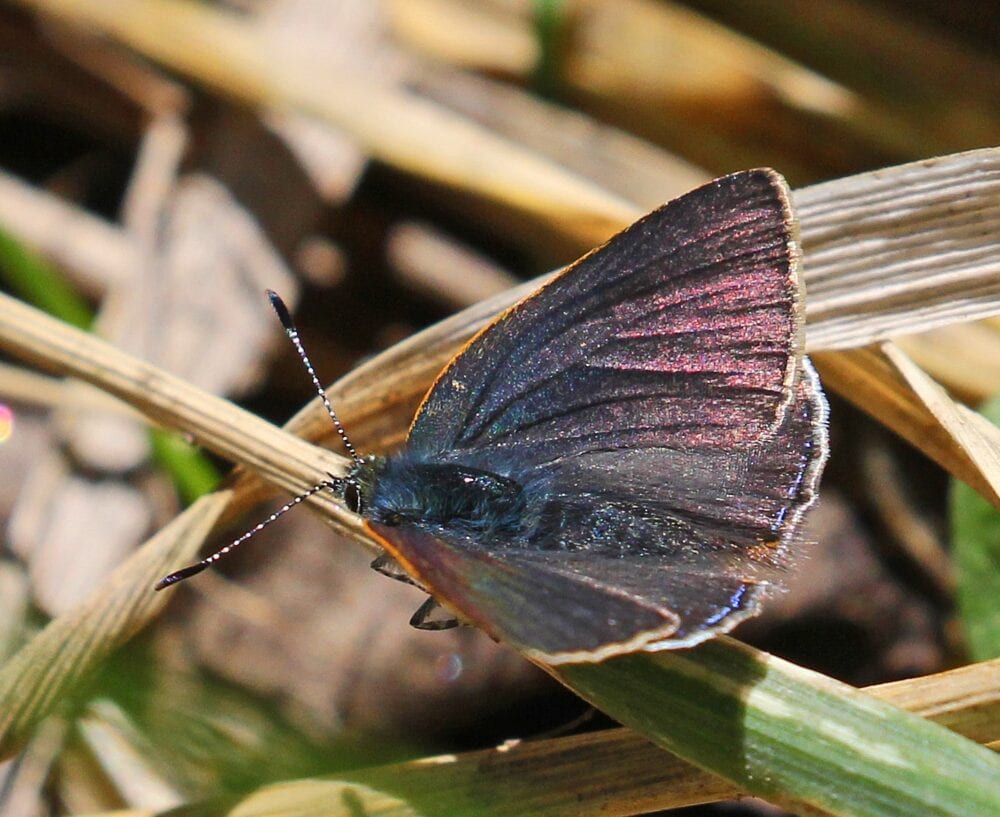

Satyrium behrii (W. H. Edwards 1870) Behr’s Hairstreak (updated June 15, 2024)
Description. Behr’s Hairstreak has tawny orange dorsal colors edged with brown. Its ventral side has a grizzled appearance, with marginal and submarginal dark spots. Rather like the elfins, Behr’s has a hindwing false head that is poorly developed, including no tails. Range and Habitat. Satyrium behrii lives in Transition Zone savannas and shrublands in the Great Basin, from Washington and California east to Wyoming and New Mexico. In our state it is restricted to the north-central and northwest mountains (counties: Be,Co,LA,MK,Mo,RA,Sv,SJ,SM,SF,Ta,To,Un), generally 6500 to 9000′ elevation. Life History. Larvae eat antelope brush (Purshia species) and mountain mahogany (Cercocarpus montanus), both Rosaceae. Eggs overwinter. Flight. Univoltine, adults are in flight from May 20 to August 13, peaking in July. Behr’s Hairstreak nectars avidly, preferring small, white flowers such as Eriogonum jamesii, but never straying far from the shrubby hostplants. Comments. Our populations are Satyrium behrii crossi (W. D. Field 1938), which is darker below than typical Great Basin populations. Some taxonomists place this butterfly in the genus Callipsyche, which is treated here as a subgenus. New Mexico sightings of this grizzled butterfly have declined in recent years. There is a (very) dubious record from “High Rolls” in Otero County (marked on the map with a white circle). There are a number of questionable records from that locality from the early 1900s.
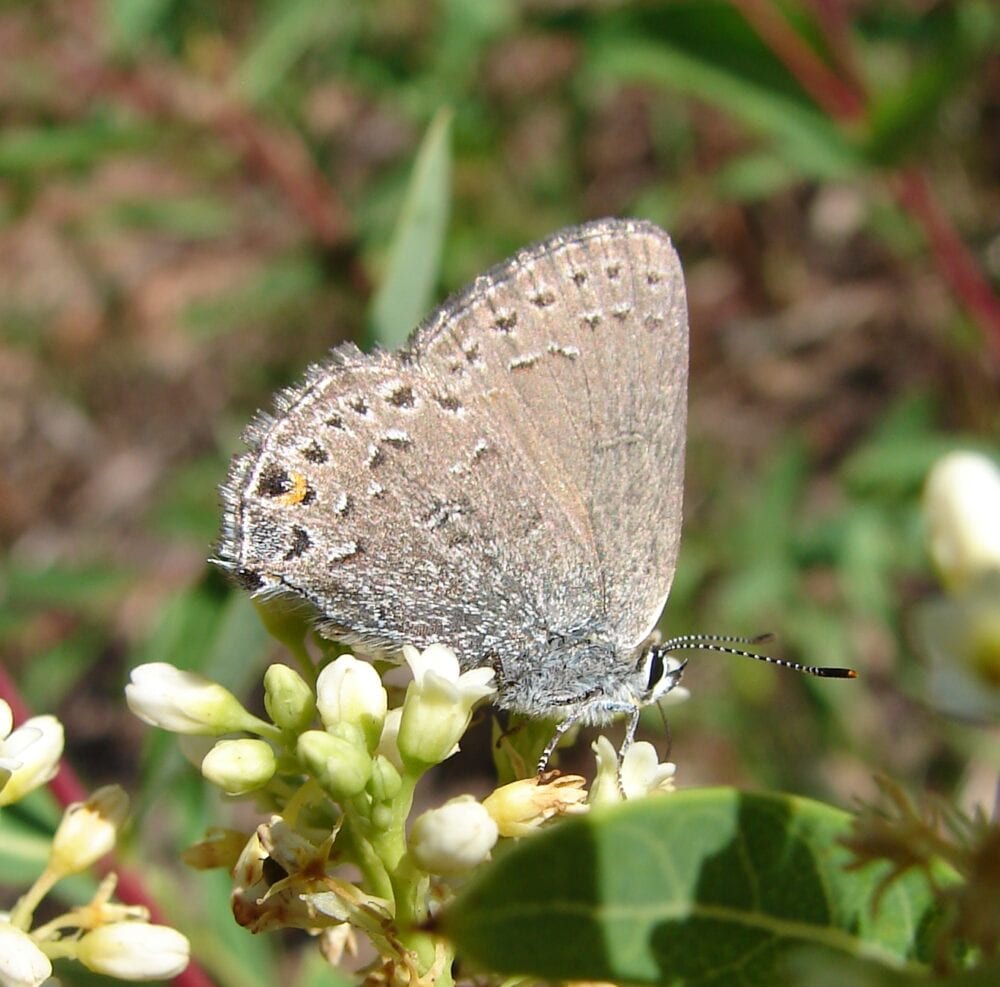
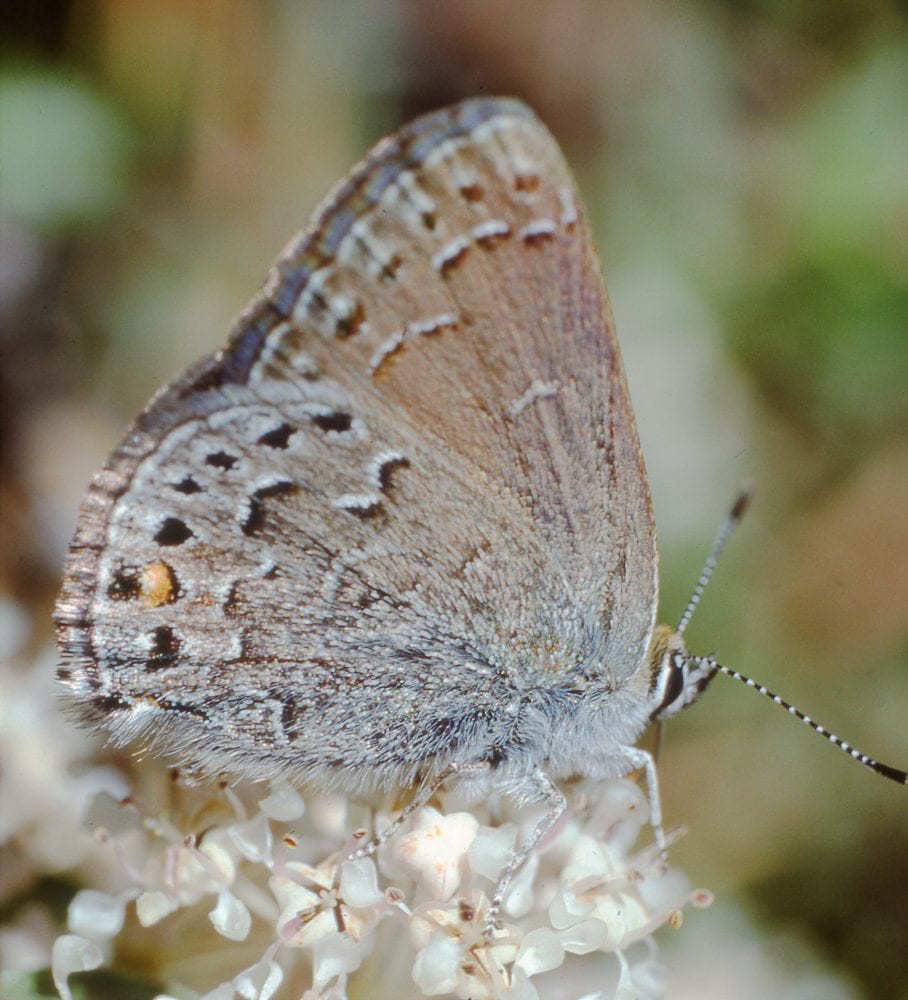
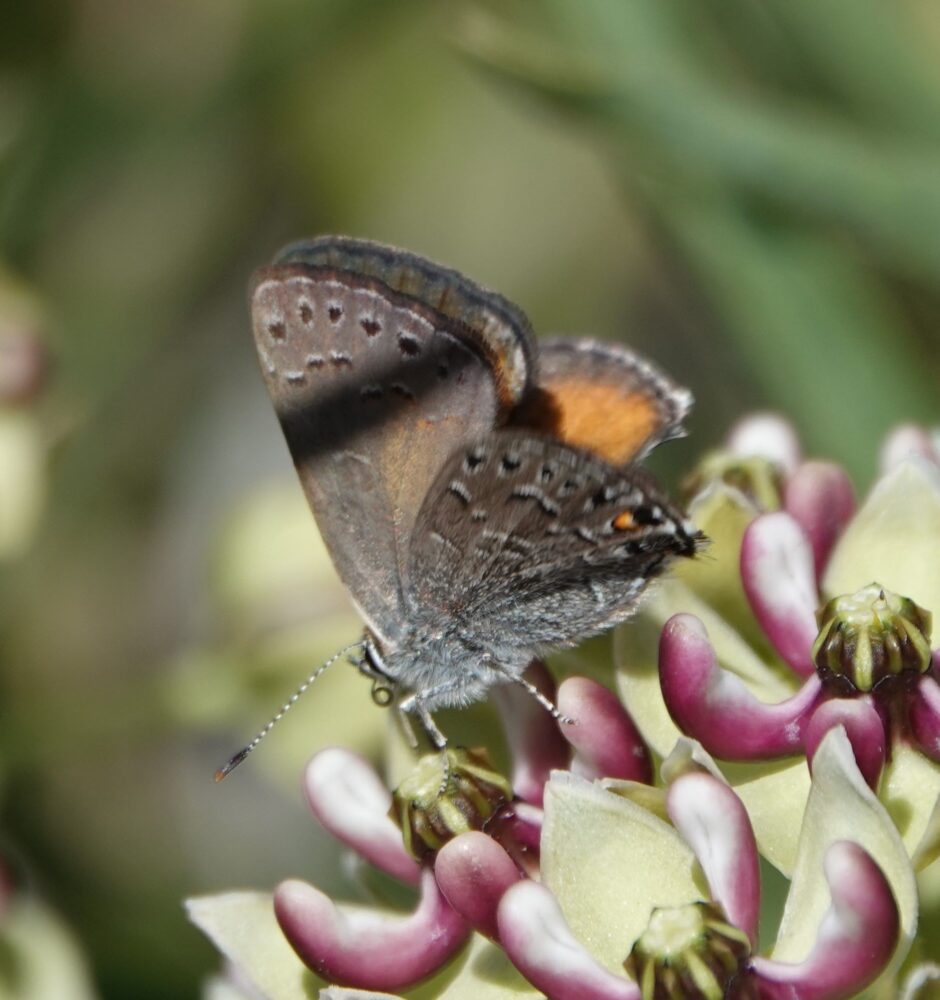
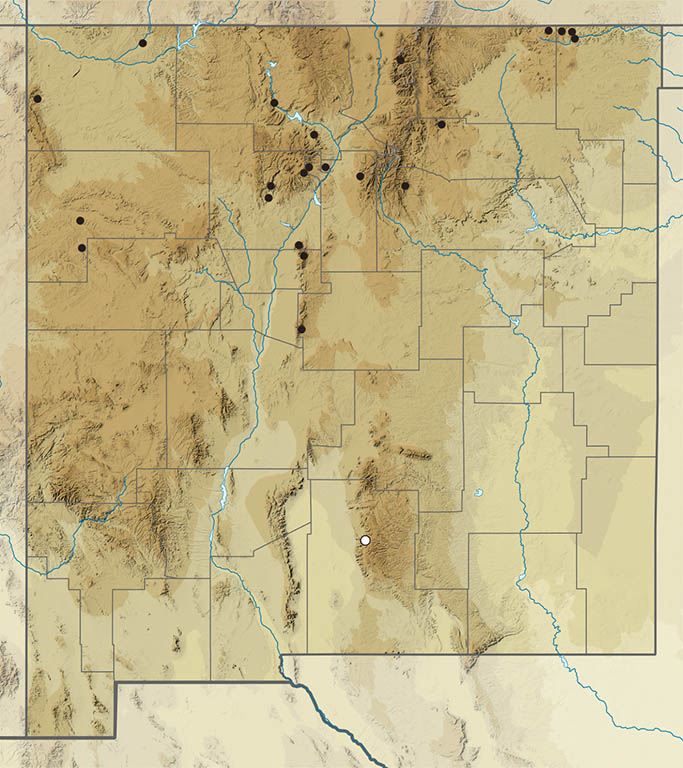
Satyrium titus (Fabricius 1793) Coral Hairstreak (updated May 5, 2022)
Description. Satyrium titus resembles its congeners in general size and markings, but in place of a hindwing false head of spots and tails it sports only a pronounced lobe, making it yet another of our tailless hairstreaks. It is gray-tan with a row of orange-coral spots along the hindwing margin, making it unique among our hairstreaks. Range and Habitat. Coral Hairstreaks occur across much of temperate North America. In New Mexico they live in Transition Zone deciduous woodlands (counties: Be,Co,Li,RA,Sv,SM,SF,Ta,To,Un), usually 6500 to 9200′ elevation. Life History. Throughout its range, Coral Hairstreak larvae eat fruits and foliage of wild plums and cherries (Rosaceae). The main New Mexico host seems to be chokecherry (Prunus virginiana), or ‘capulin’ in local Spanish vernacular. Eggs overwinter. Friendly ants appear to be vital for survival of Satyrium titus colonies. Flight. Univoltine, adults fly between June 25 and August 30, peaking in July. Coral Hairstreaks nectar avidly and may hilltop. Comments. Colonies in northeast New Mexico (Co,Un) resemble subspecies Satyrium titus watsonii (W. Barnes & Benjamin, 1926). Colonies in north-central New Mexico resemble Great Basin subspecies Satyrium titus immaculosus (W. Comstock 1913), whose hindwing black spot band is reduced or faded. Members of relict colonies on Nogal Peak and Carrizo Peak (both Li) are recently described subspecies Satyrium titus carrizozo (R. Holland 2010).
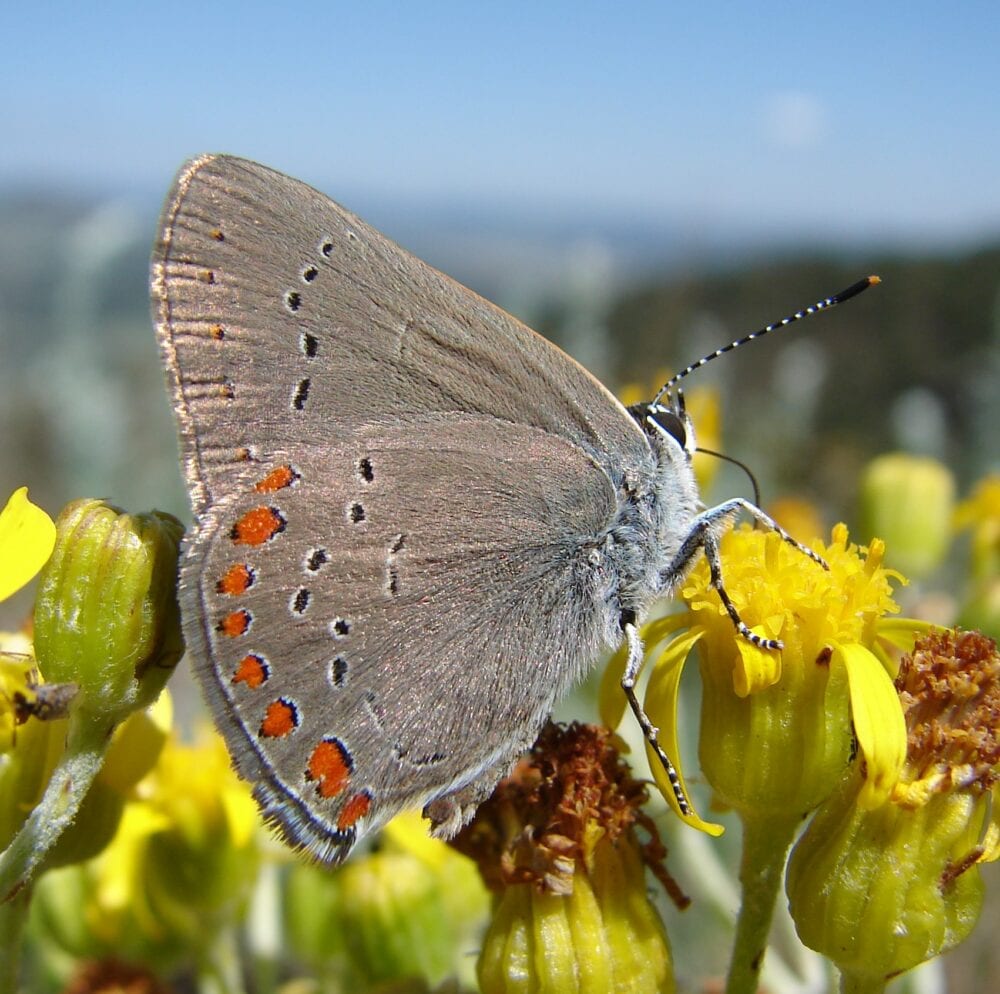
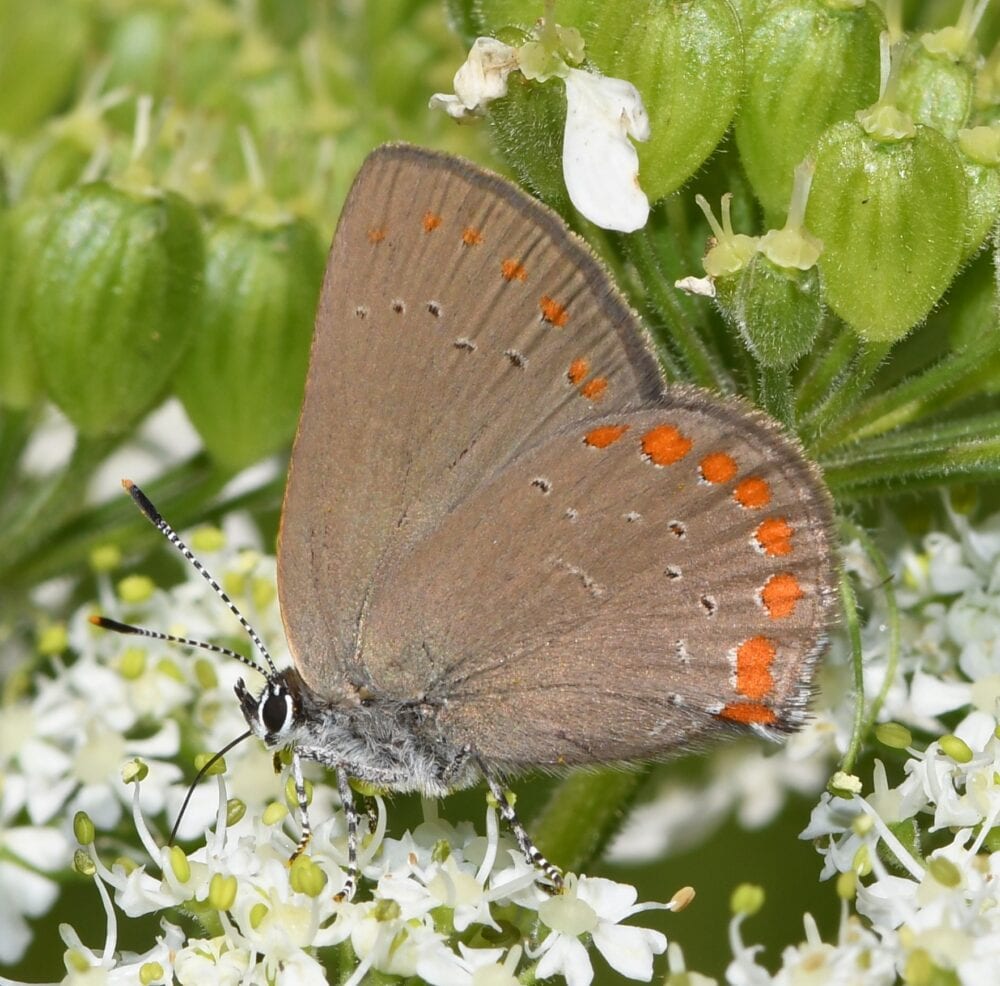
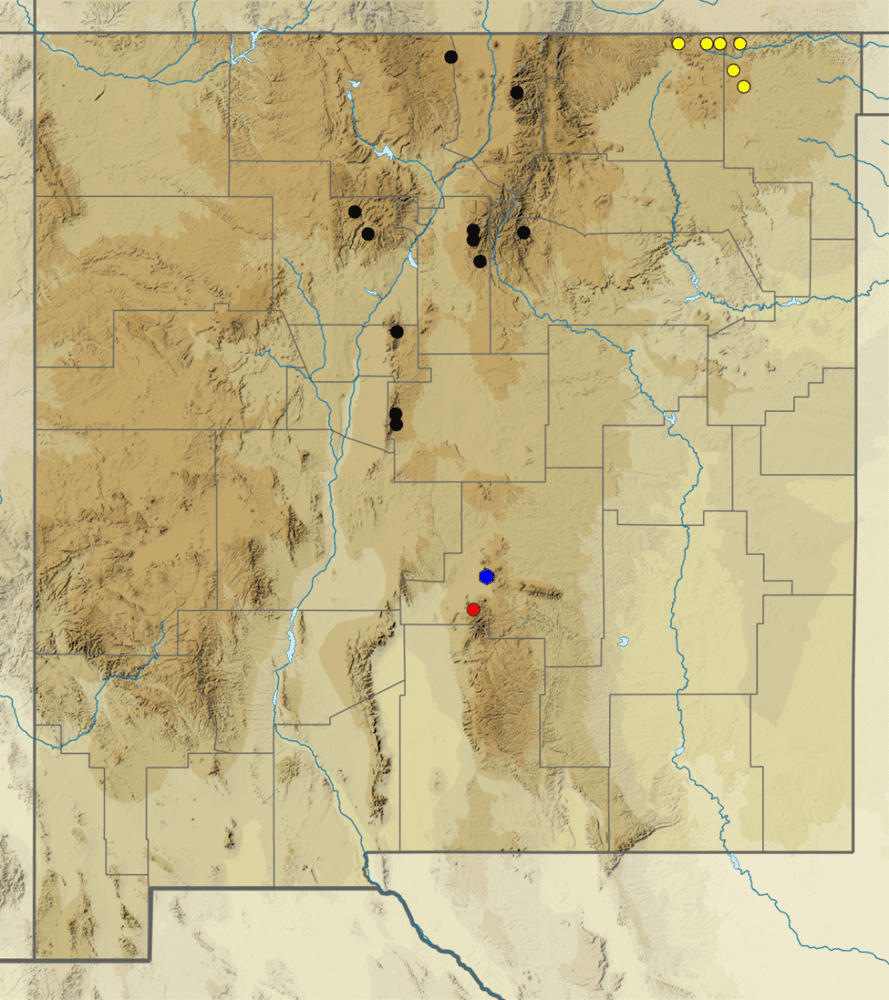
Satyrium favonius (J. E. Smith 1797) Oak Hairstreak (updated May 13, 2022)
Description. The Oak Hairstreak (Satyrium favonius) is gray-brown below and dark brown above with two orange patches. Its hindwing false head is decorated with a tail, a stub, a blue spot, marginal orange spots and a white “W.” The submarginal orange markings on the VHW are more extensive on this hairstreak than on other similar hairstreaks. Range and Habitat. Oak Hairstreaks occupy the eastern US from New York to Florida and west to eastern Colorado and eastern New Mexico. Here they inhabit brushy, oaky Upper Sonoran to Transition Zone canyons and hillsides (counties: Co,Cu,Ha,Li,Mo,Ot,Qu,SM,Un), from 5000 to 8500′ elevation. Life History. Larvae eat oaks (Fagaceae). Wavy-leaf oak (Quercus undulata) is the host in eastern New Mexico. Eggs overwinter; larvae hatch in spring and feed on fresh buds, flowers and leaves. Flight. Oak Hairstreaks fly in early summer. Our records span May 29 to July 7. Adults are best found nectaring near the host oaks, for example at honey mesquite, horehound or dogbane. Comments. Our populations belong to subspecies Satyrium favonius violae (D. Stallings and J. Turner 1947), which was described from specimens collected near Folsom (Un). Because there is a ‘Southern’ Oak Hairstreak subspecies, Satyrium favonius favonius, and a ‘Northern’ Oak Hairstreak, subspecies Satyrium favonius ontario (W. H. Edwards 1868), it makes complete sense to call our subspecies violae the ‘Western’ Oak Hairstreak. Populations on the east slope of the Sacramentos are poorly known and need more study.
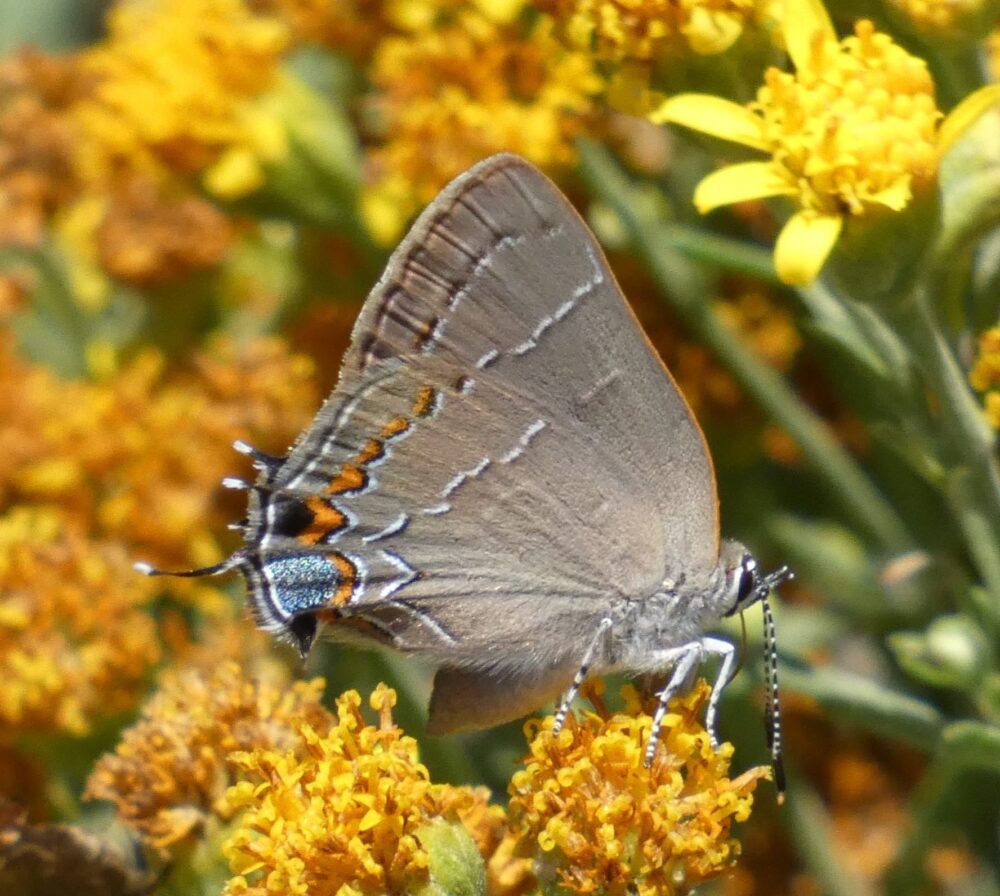
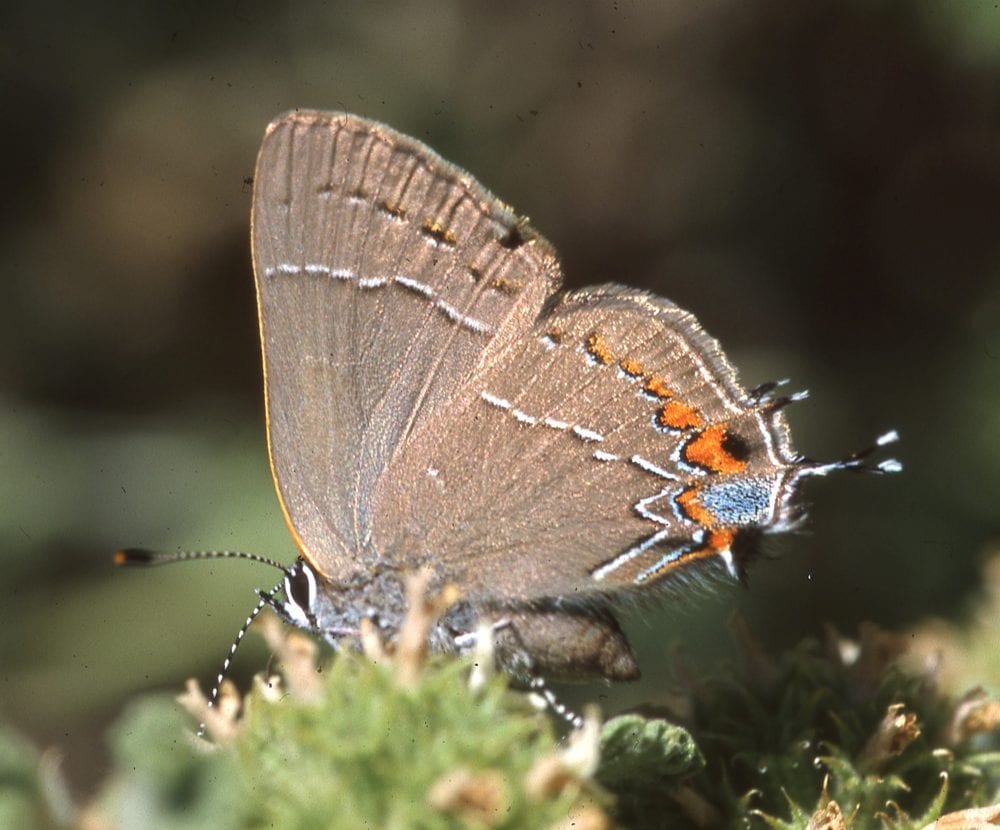
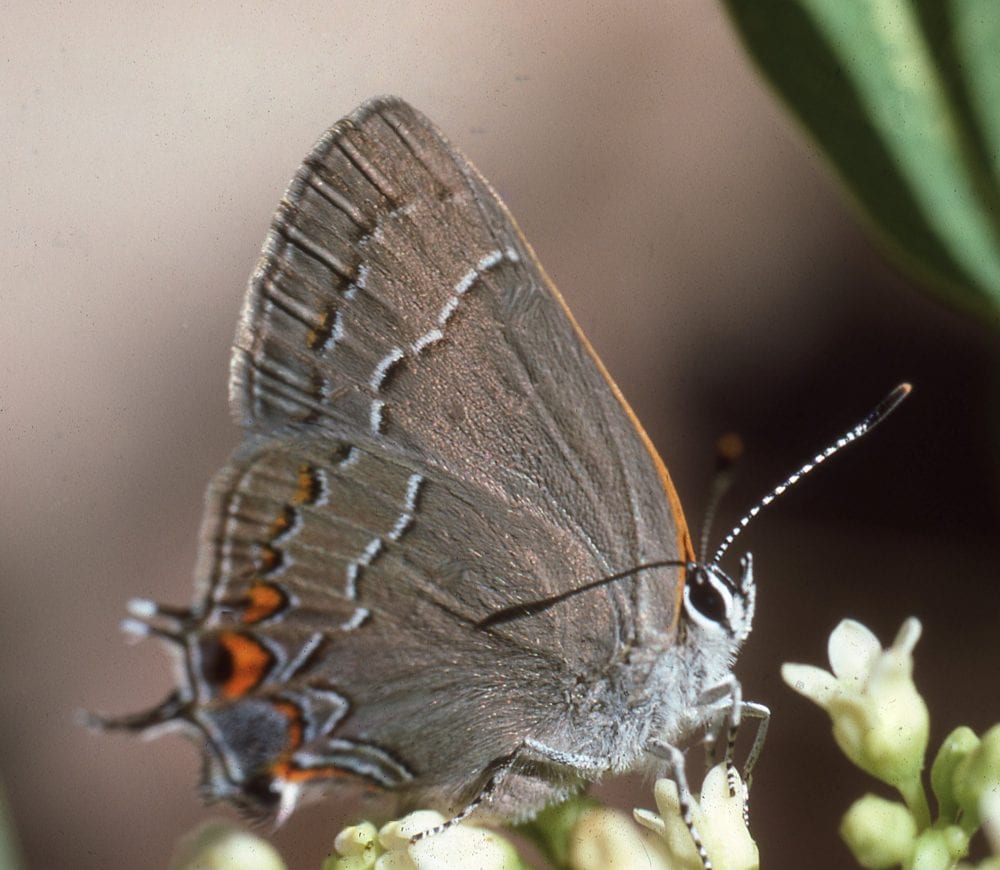

Satyrium ilavia (Beutenmüller 1899) Ilavia Hairstreak (updated April 8, 2023)
Description. Closely related to the foregoing and following species, Ilavia Hairstreak is brown above with orange-tan patches. Below, it is pale gray-brown with a standard Satyrium false head but an indistinct postmedian white line. The ventral surface is much plainer than in related species. Range and Habitat. A southwestern endemic, Satyrium ilavia lives in oak-studded foothills of the Mogollon Rim massif in Arizona and southwest New Mexico (counties: Gr). Life History. Females oviposit on twigs of the scrub oak species Quercus turbinella (Fagaceae). Eggs remain in diapause through summer, autumn and winter, then hatch the following spring and begin feeding on fresh growth. Its infrequent occurrence in New Mexico is punctuated by local population booms, suggesting that it extends diapause during drought years and then capitalizes on wet years when they come along. Flight. New Mexico records are scarce, but the ones we have fall between May 29 and July 7. In 2022, the usual early summer flight in Arizona was followed by a surprising second emergence in September (Beck 2023), possibly as a result of favorable summer monsoons. Look for adults at nectar near its host oaks, for example at Amorpha species. Comments. Once considered a geographic subspecies of ‘Western’ Oak Hairstreak, Ilavia is now considered a distinct species in most recent field guides and catalogs (e.g., Opler and Warren 2002, Brock and Kaufman 2003, Pelham 2021).
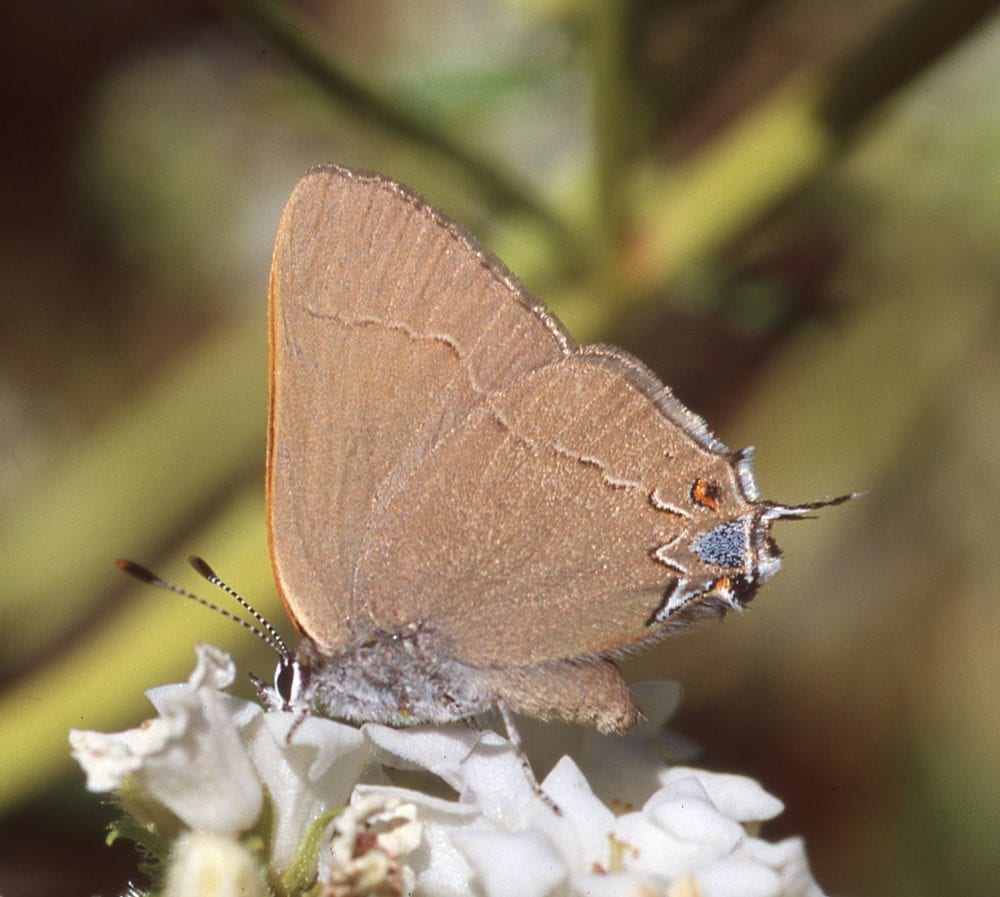

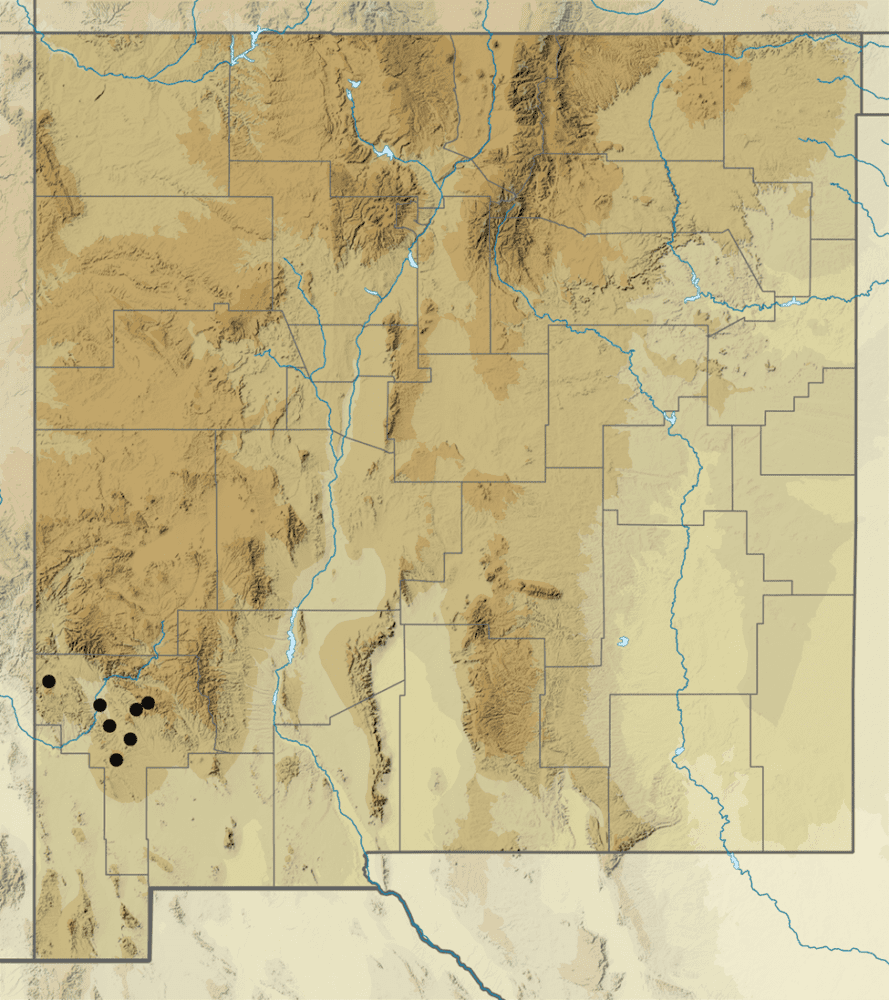
Satyrium polingi (W. Barnes & Benjamin 1926) Poling’s Hairstreak (updated May 16, 2022)
Description. Poling’s Hairstreak is like its close relatives, but the forewing apex is rounded, there is no orange above, the ventrum is slate gray and the hindwing submarginal band of orange spots is reduced, though not as much as in Ilavia. Range and Habitat. Satyrium polingi occupies scrub oak chaparral in mountain ranges of west Texas, southeast New Mexico and northern Mexico (counties: DA,Ed,Li,Ot,Si,So), 5400 – 7000′ elevation. Life History. Evergreen oaks (Fagaceae) are larval hosts. Quercus emoryi and Q. grisea are hosts for the nominate race. Subspecies Satyrium polingi organensis (Ferris 1980) is associated with stands of Quercus turbinella. Ova overwinter; larvae hatch in spring to eat fresh oak inflorescences. Flight. Univoltine, adults perch on host oaks and nectar at nearby flowers (e.g., Texas beargrass). Look for Satyrium polingi between April 16 and June 20, primarily in late May and early June. Comments. Colonies of the nominate subspecies live in the Guadalupe, Sacramento and Capitan mountains. Subspecies Satyrium polingi organensis was first captured by Richard Holland in the Organ Mountains on 16 April 1979. It has slightly weak or faded hindwing markings compared to the nominate race. Its colonies extend north along the San Andres Mountains almost to US 380.
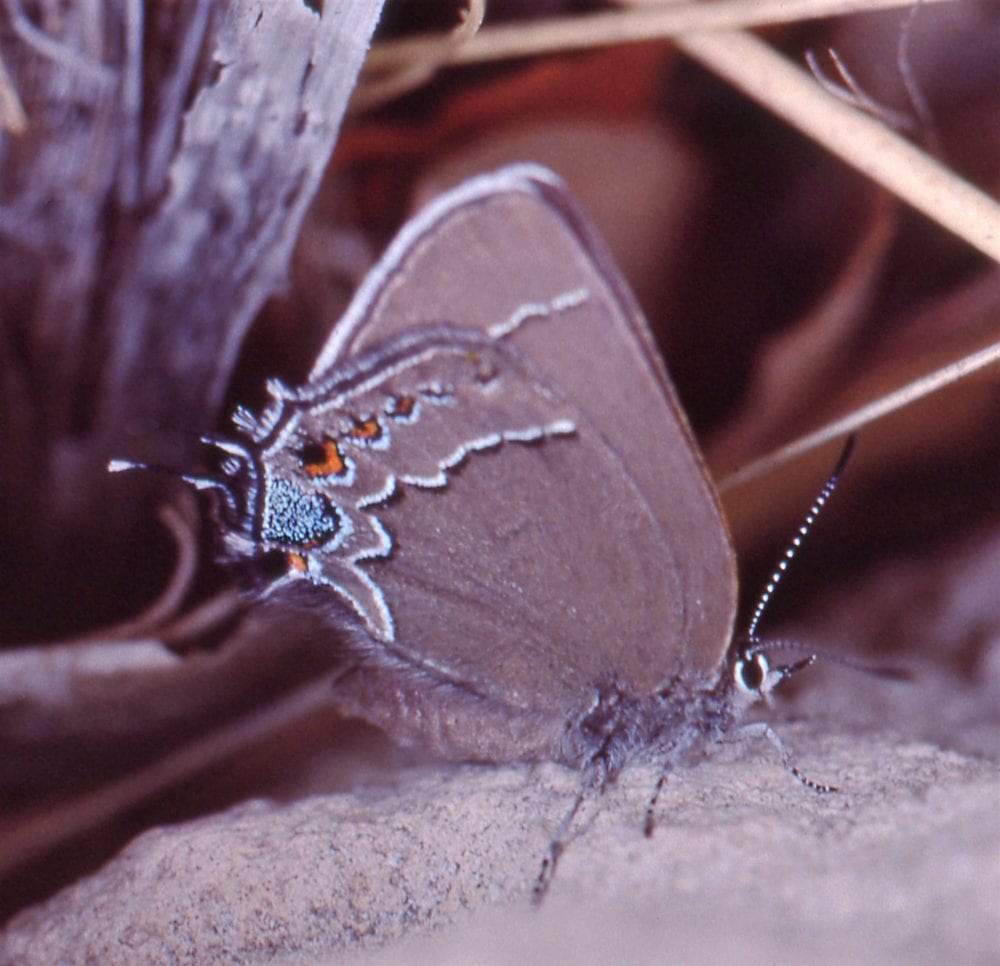
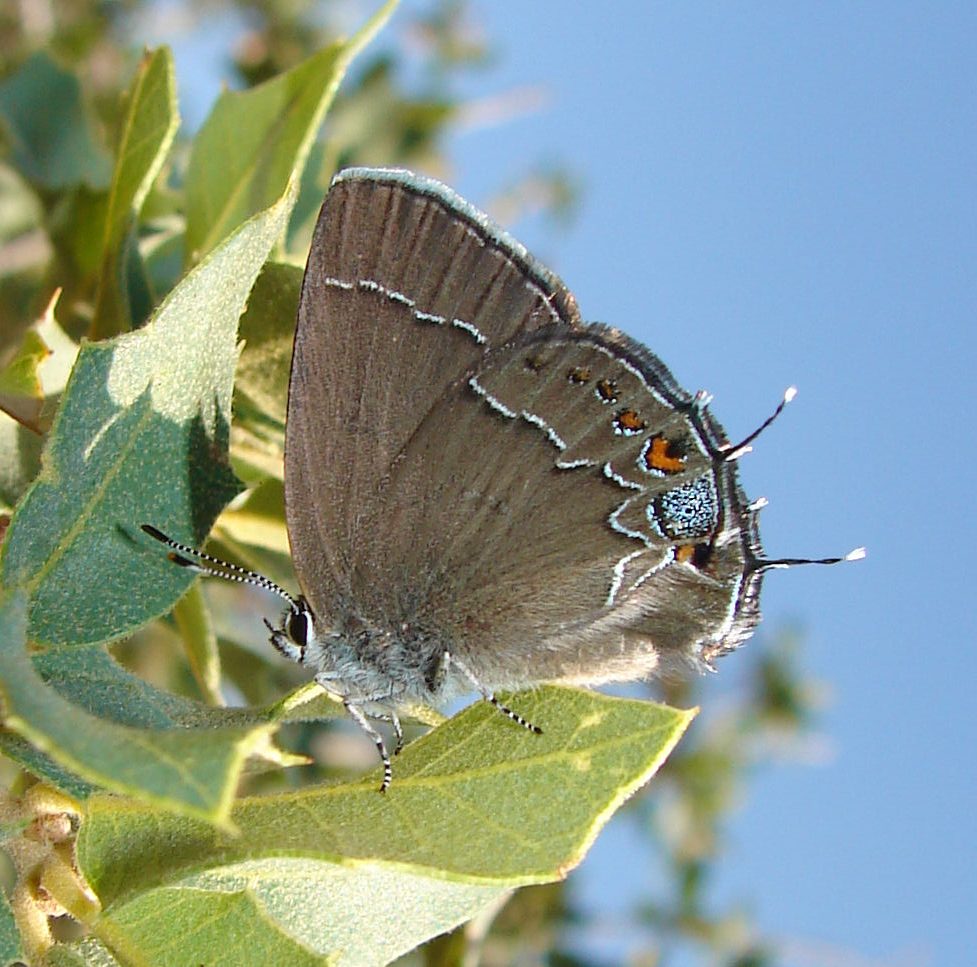

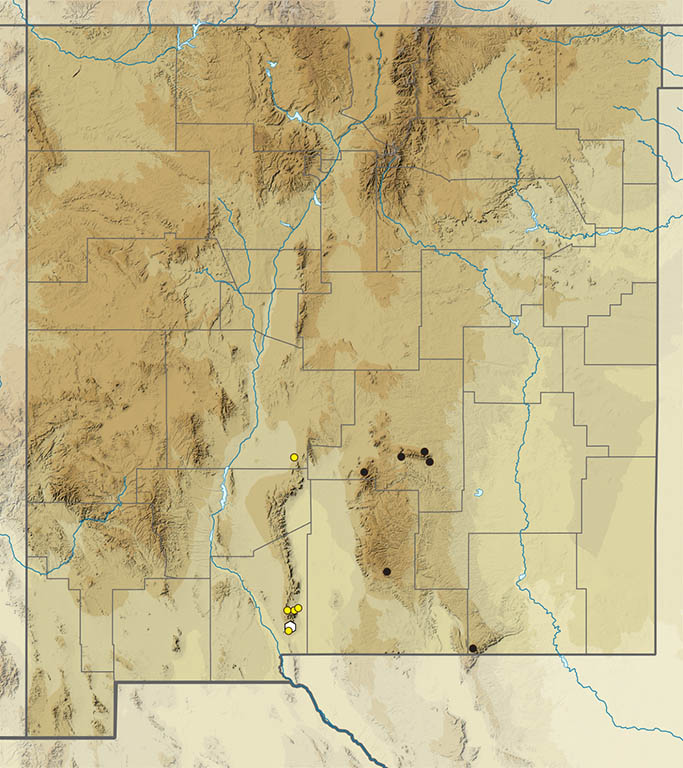
organensis; white hexagon = type locality of ssp. organensis.
Satyrium alcestis (W. H. Edwards 1871) Soapberry Hairstreak (updated May 13, 2022)
Description. Satyrium alcestis is light tan-gray below and unmarked dark brown above. Ventral markings are much like those of other Satyrium species, but there is an extra white bar on ventral forewing and hindwing Range and Habitat. Soapberry Hairstreaks live in the south-central Great Plains and southwestern deserts into northern Mexico, wherever stands of the larval host are found. In New Mexico it likes Upper Sonoran Zone canyons and hillsides (counties: Ch,DB,Ed,Gr,Gu,Ha,Hi,Li,Mo,Qu,Ro,SM,Un), always below 5500′. Life History. Soapberry trees (Sapindus drummondii; Sapindaceae) are the only known host. Eggs overwinter; larvae hatch in spring and eat fresh spring growth. Flight. Adults fly in early summer. New Mexico records fall between May 20 and July 30, peaking in June. Adults perch on the host and seek nectar nearby. On hot days, which are the norm during the June flight period, adults may retreat to the shady interior of soapberry trees. Comments. Populations in southwest New Mexico are lighter on the underside and are subspecies Satyrium alcestis oslari (Dyar 1904). The nominate race prevails elsewhere in our state. Satyrium alcestis seems curiously absent from south-central New Mexico (counties: DA,Lu,Ot,Si). Comments. University of Kansas Professor Francis Huntington Snow was the first to document this butterfly in New Mexico; he found it at Little Walnut Creek north of Silver City (Gr) in August 1884. Until recently, taxonomists had placed this butterfly in the genus Phaeostrymon.
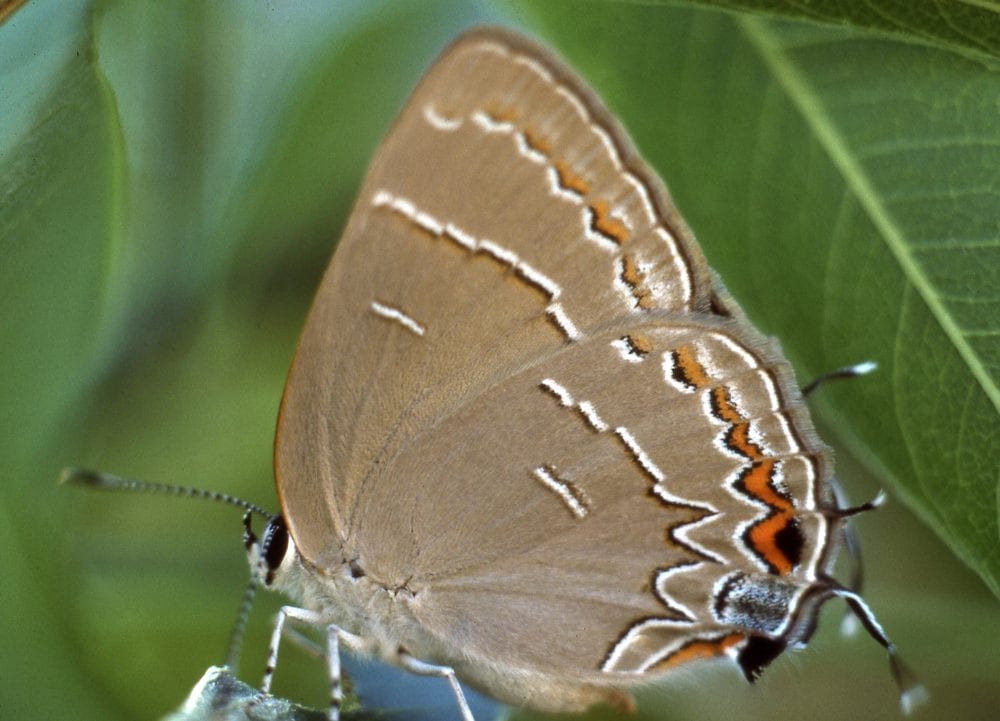
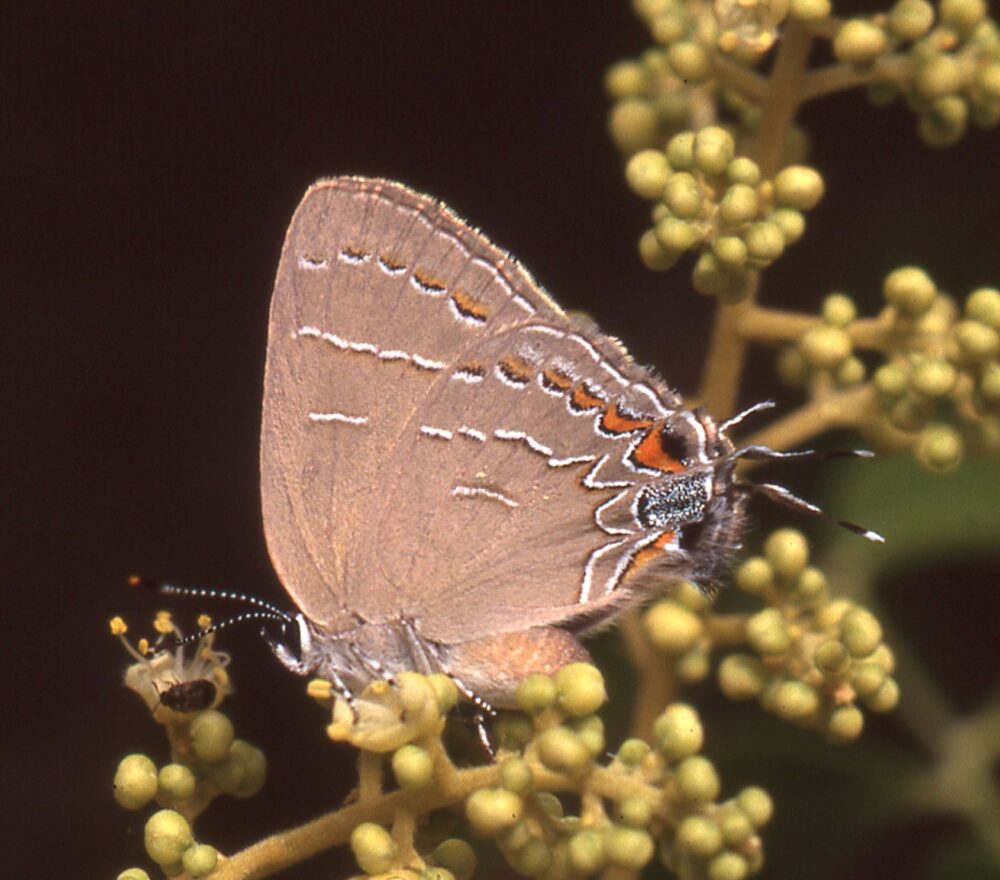
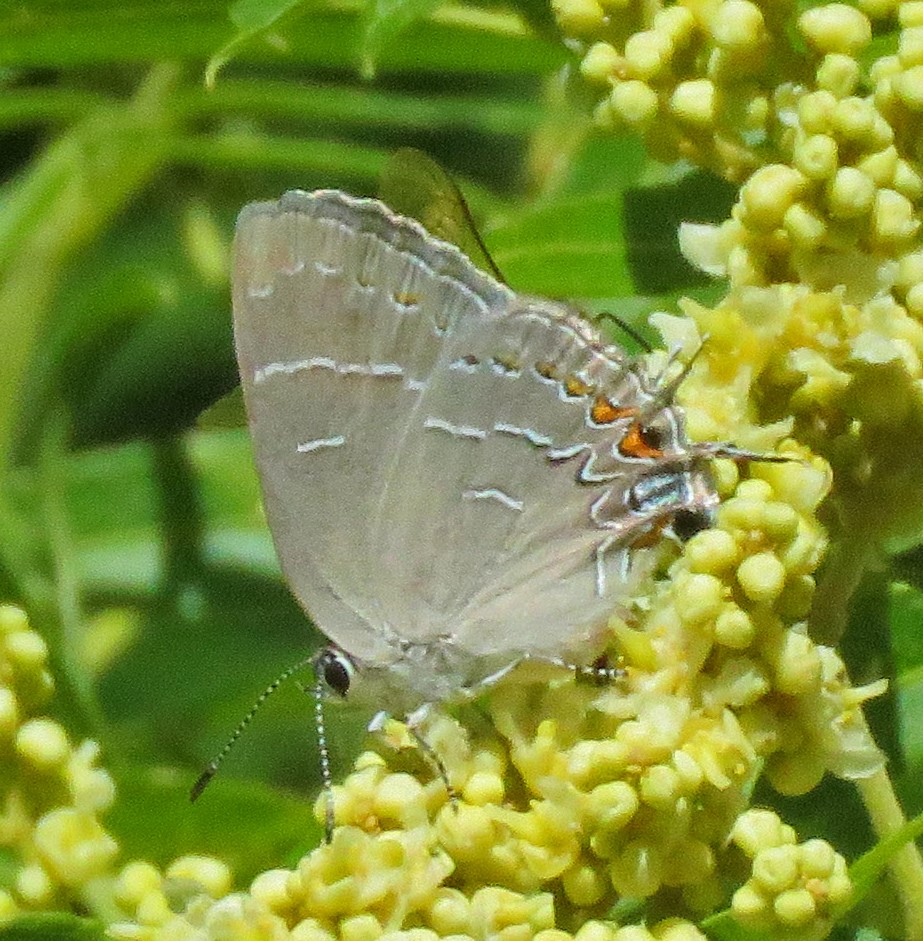
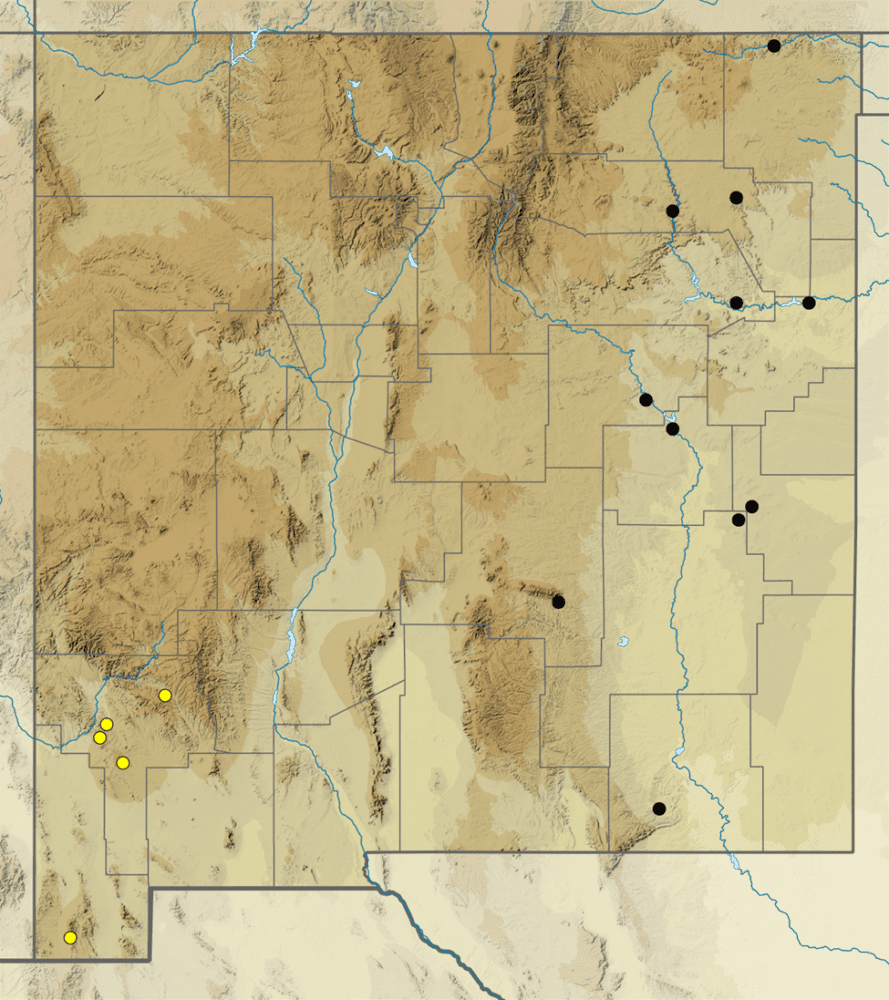
Satyrium liparops (Le Conte 1833) Striped Hairstreak (updated June 12, 2023)
Description. Striped Hairstreak resembles Banded Hairstreak but with the white-edged ventral bands much wider and the white edging on both sides of the band; the area between the white edges is dark. The false head at hindwing anal angle has two orange spots on either side of an orange-hatted blue spot. Range and Habitat. Striped Hairstreaks live in North America’s eastern woodlands and northern Great Plains. They also occur southwestward along the Rocky Mountains edging slightly into north-central New Mexico (counties: Co,RA,Un), where they inhabit cherry-choked canyons and hillsides, 6500 to 8500′ elevation. Life History. Eastern US hosts for Satyrium liparops are various broadleaf trees. New Mexico colonies use native chokecherries, or ‘capulín’ in local Spanish. Oviposition is reported on Prunus americana and Prunus virginiana (Rosaceae). Flight. Our few confirmed reports indicate a flight period of at least June 22 to July 11. Adults stay near the host, perch on its leaves and nectar at nearby flowers. Look for it in thickets of the host. Comments. Mike Fisher found our first Striped Hairstreak at Tollgate Canyon (Un) on 22 June 1990. A second colony was found at the Humphries Wildlife Management Area west of Chama (RA), where a permit from the New Mexico Department of Game and Fish is required for access. We have subspecies Satyrium liparops aliparops (Michener & dos Passos, 1942). Many canyons in the mountains of northern New Mexico bear the name ‘Capulín’, which tempts butterflyers to look there for additional colonies of this secretive butterfly.
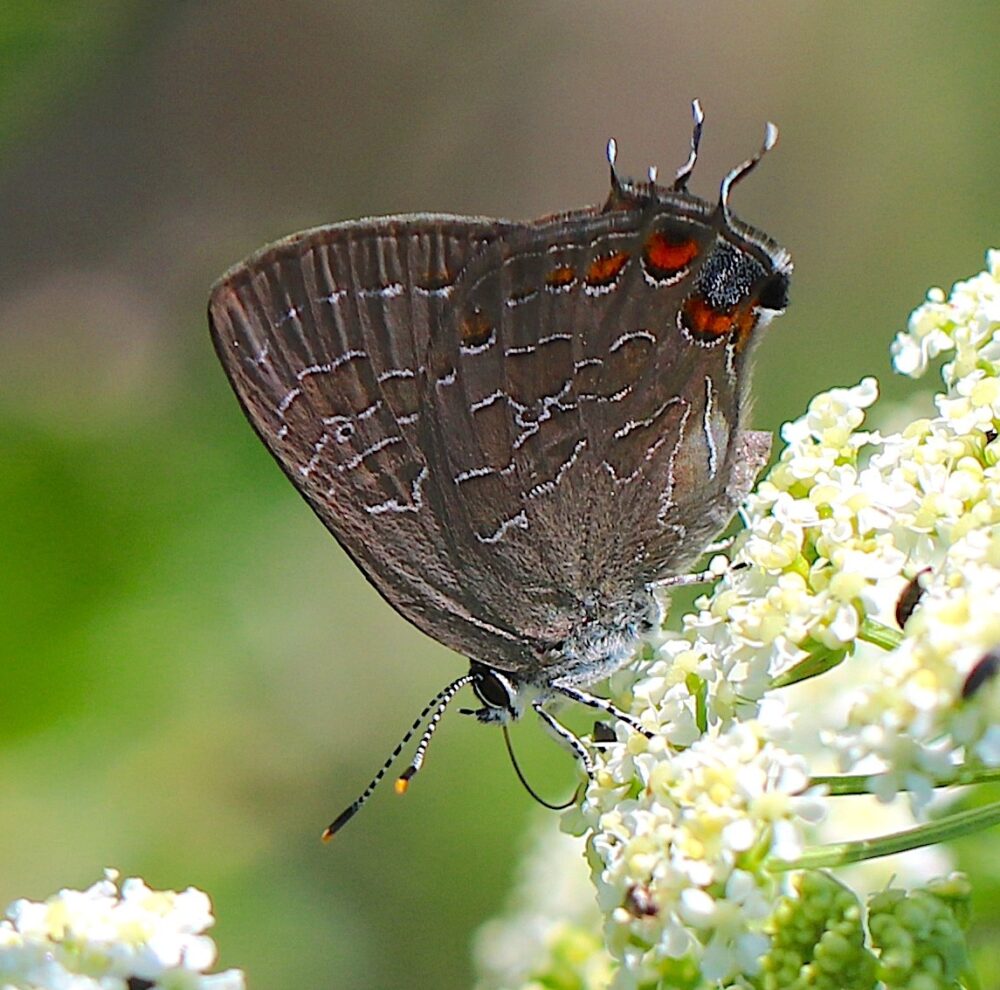
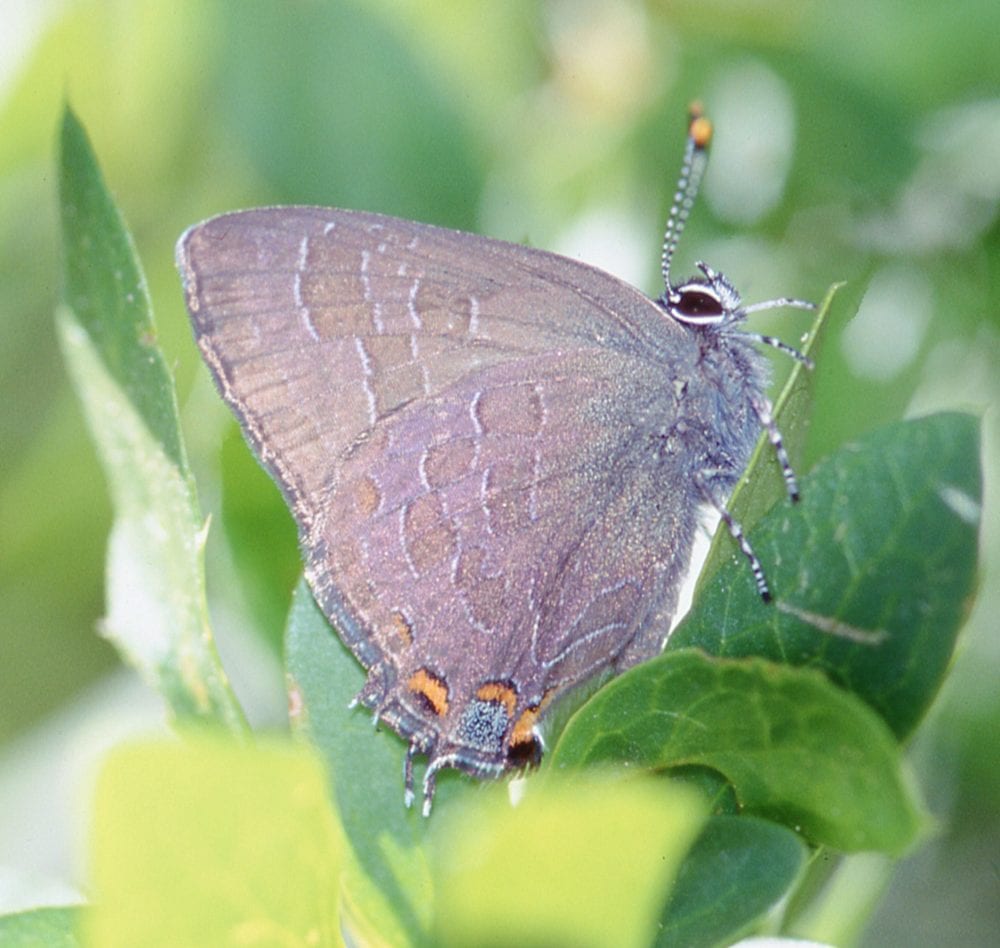
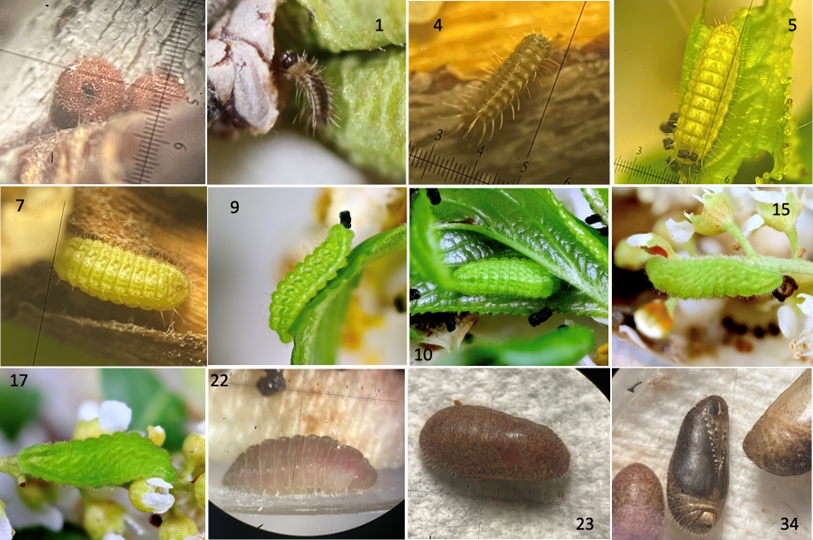
All life stages of Striped Hairstreak (Satyrium liparops aliparops) reared in 2023 from eggs collected near Folsom, Colfax Co., NM in June 2022 (photo courtesy of Bill Beck)
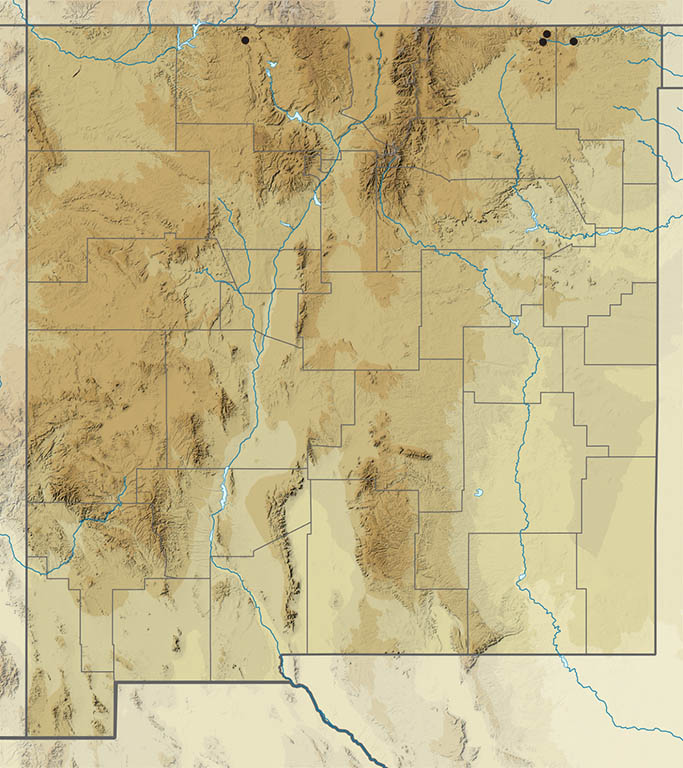
Satyrium calanus (Hübner [1809]) Banded Hairstreak (updated May 13, 2022)
Description. Banded Hairstreaks have a dark gray underside, aging to brown, with postmedian bands, white-edged on the distal (outer) side (a related species which doesn’t occur in NM has white edging on both sides, and the occasional Banded may have that as well). A false head at the hindwing anal angle includes orange spots, a blue spot and a tail. Range and Habitat. Banded Hairstreaks range from Texas and North Dakota to the Atlantic Ocean. A disjunct population in the southern Rockies includes northern New Mexico (counties: Be,Co,LA,Mo,RA,Sv,SM,SF,Ta,Un). Our populations live in Transition Zone oak groves, 6500 to 9500′ elevation. Life History. Here, larvae eat Gambel’s oak (Quercus gambelii; Fagaceae). Other oak species are used elsewhere. Eggs are placed in mid-summer and then diapause through winter; larvae hatch in spring and eat new growth. Flight. Banded Hairstreaks are univoltine with adults on the wing in mid-summer. New Mexico records span June 7 to September 7, with most in July. Males perch on oaks; both sexes come to nectar. Comments. Rocky Mountain populations are Satyrium calanus godarti (W. D. Field 1938). The Sandia Mountains east of Albuquerque host the southernmost colony of this beautiful southern Rocky Mountain hairstreak.
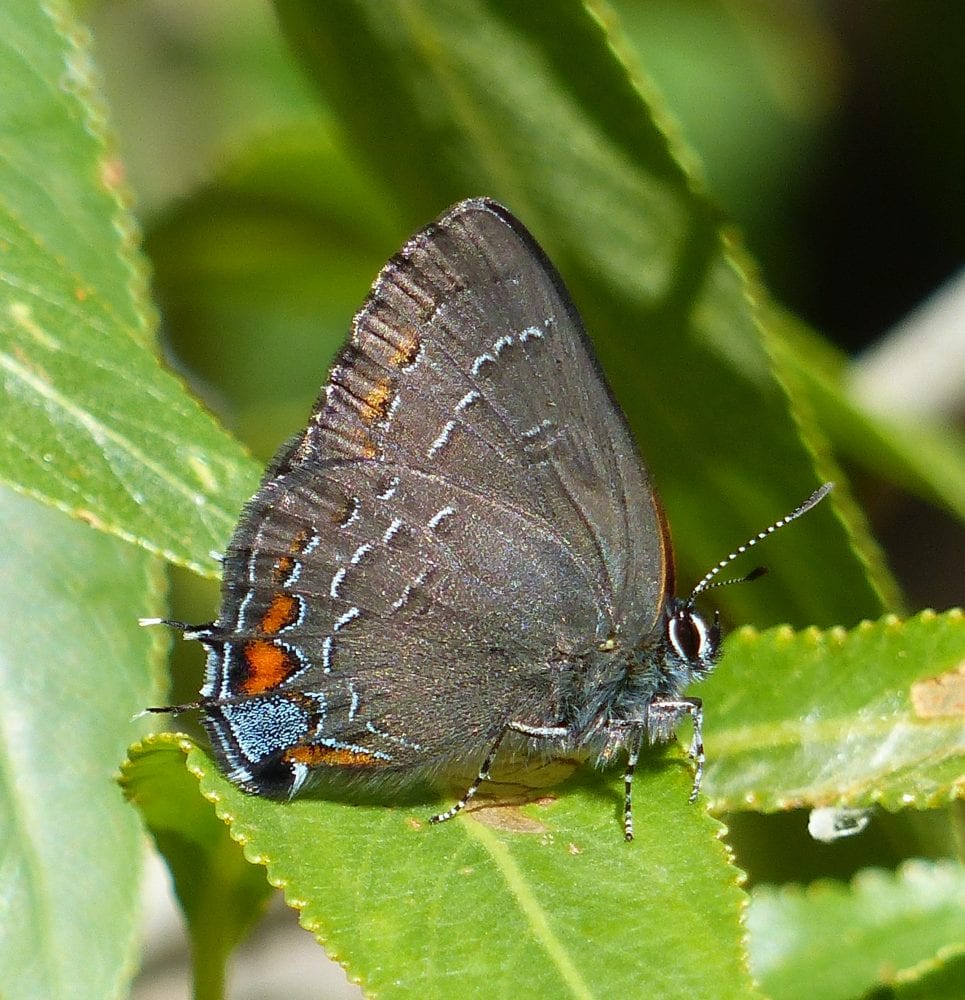
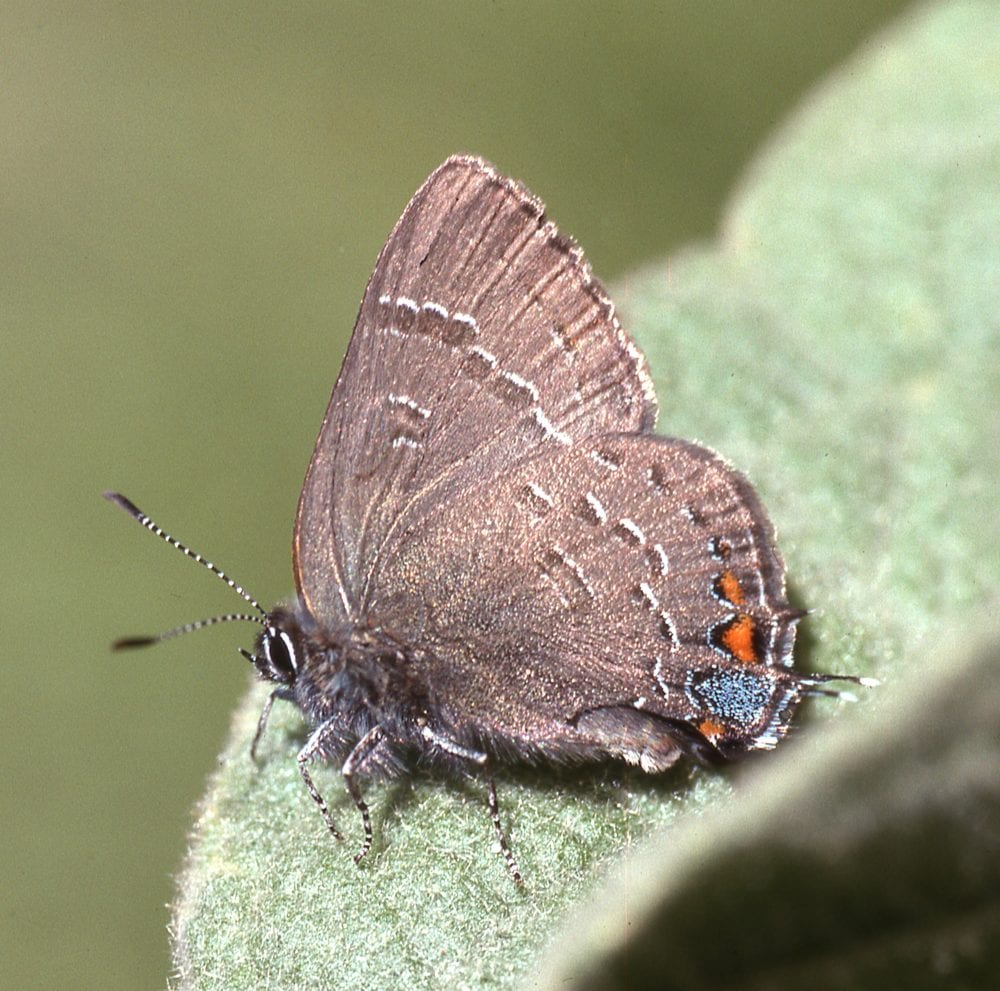
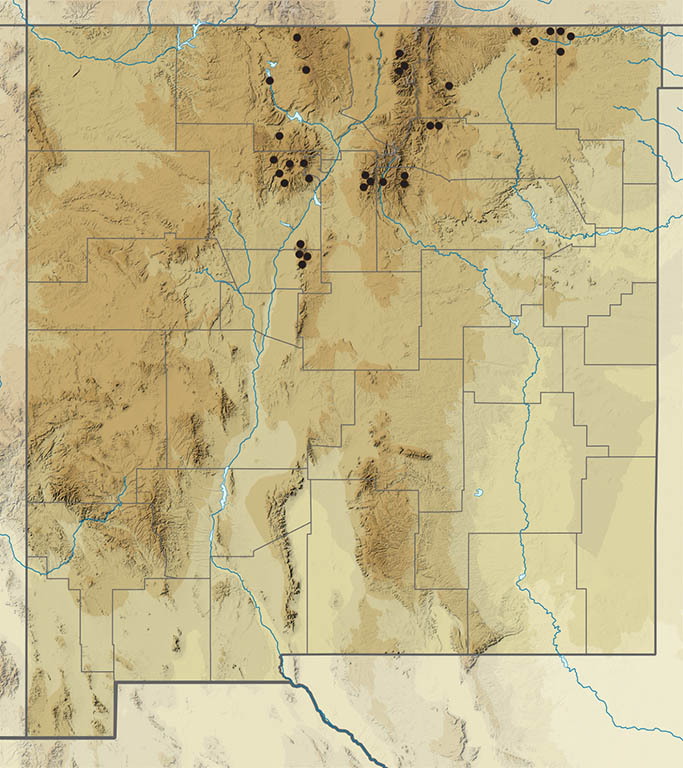
Satyrium dryope (W. H. Edwards 1870) Dryope Hairstreak (updated July 3, 2023)
Description. Satyrium dryope is pale silver-gray below with a postmedian row of small black spots. A false head at the anal angle has orange and blue spots and a stubby tail. Above, males are dark brown and females are tawny. Range and Habitat. Dryope Hairstreaks occupy much of the interior montane West, southward into Arizona and New Mexico. In New Mexico it is found in foothills of our north-central and northwest mountain ranges (counties: Ca,Co,MK,RA,Sv,SJ,SM?,SF,Ta). Though widespread, this butterfly is largely restricted to streamside and acequia habitats with stands of the larval host, usually 5800 to 8000′ elevation. Life History. Larvae eat leaves of willows (Salicaceae). Coyote willow (Salix exigua), whether along a natural stream or an irrigation ditch, is strongly favored in New Mexico. Ova overwinter. Flight. Dryope Hairstreak is univoltine with adults in mid-summer, usually between July 4 and August 20. Adults perch on willows and nectar at nearby flowers such as thistle, dogbane and milkweed. Comments. North-central New Mexico populations belong to subspecies Satyrium dryope putnami (Hy. Edwards 1877). Those from western NM (Ca,MK,SJ) probably belong with S. dryope itys (W. H. Edwards 1872). Old museum specimens of Satyrium dryope labelled merely “High Rolls” (Ot) are thought to be inaccurately labeled because there are no confirmed modern records from the Sacramento Mountains. We used to call these butterflies Sylvan Hairstreaks (Satyrium sylvinus Boisduval 1852), but recent genomic analyses by Zhang, et al. (2022) prompted those authors to elevate dryope (W. H. Edwards 1870) from a ssp. of sylvinus to a full species; we follow that arrangement here.
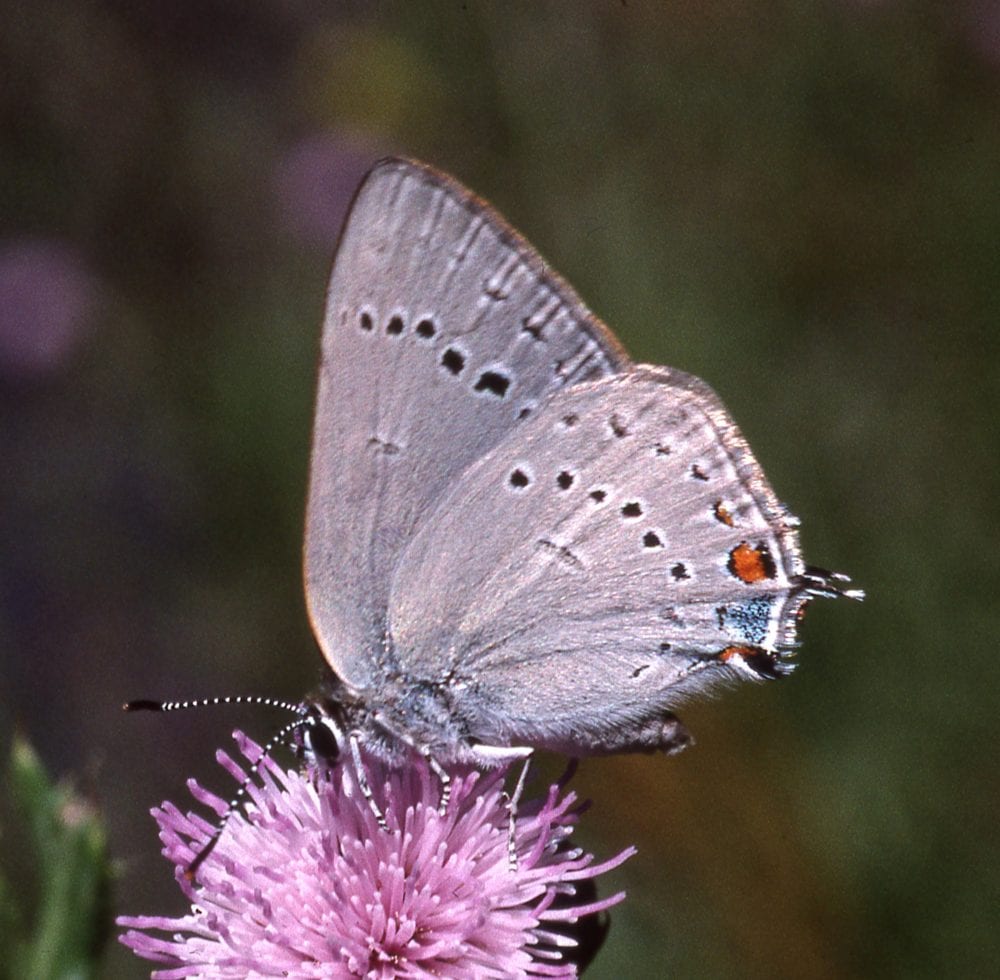
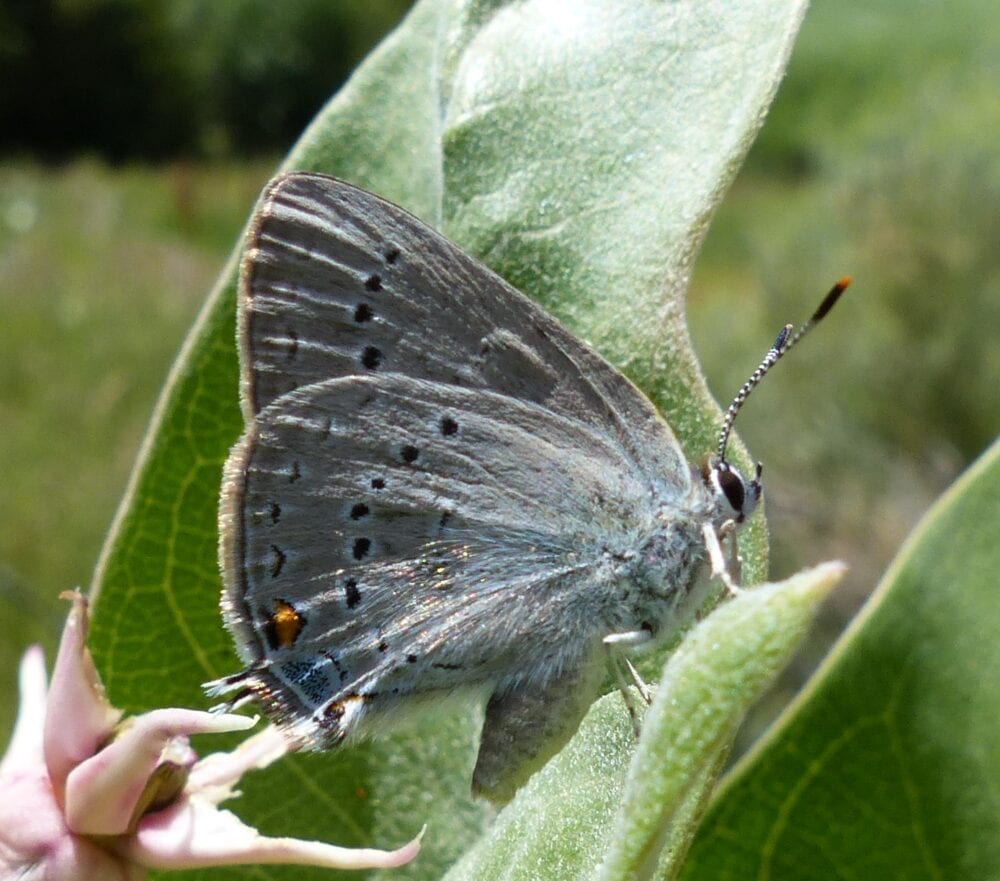
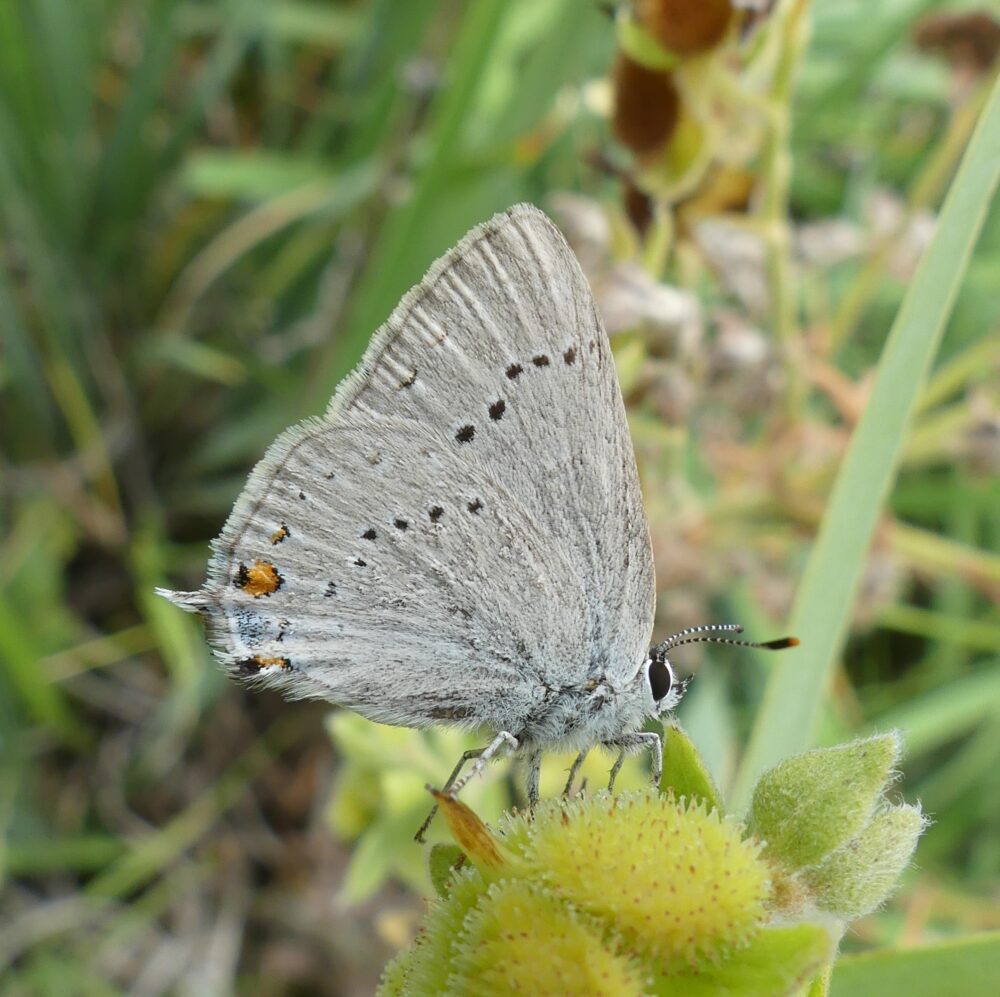
Co., CO; July 27, 2022 (photo by Steve Cary).
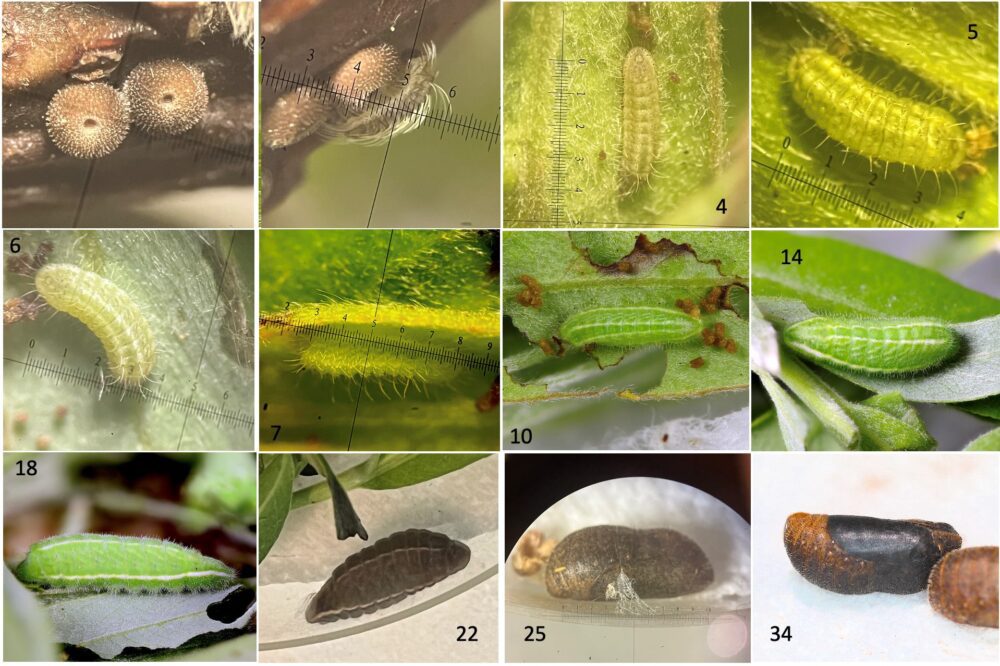
Life stages of Dryope Hairstreak (Satyrium dryope itys) reared in 2023 from eggs collected near Payson, AZ in 2022 (photos courtesy of Bill Beck.)
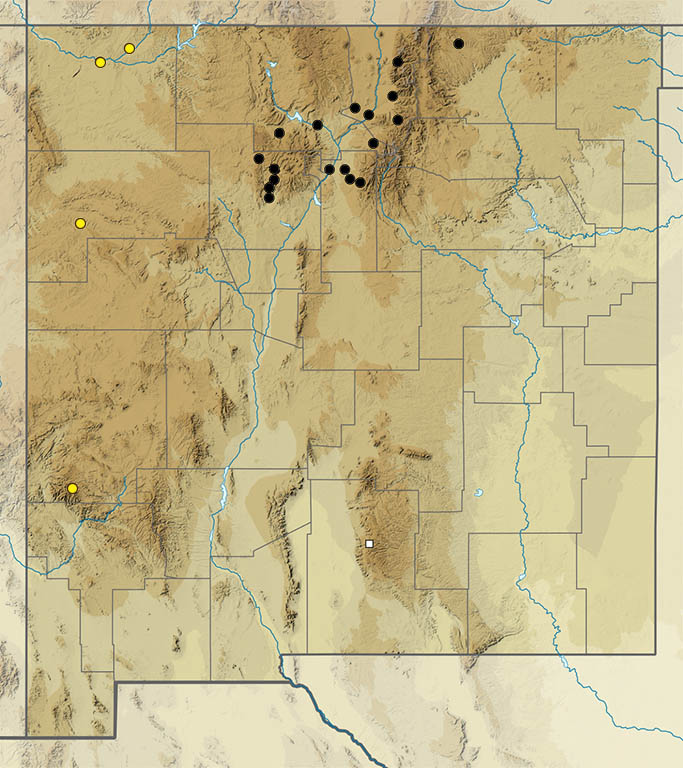
Satyrium saepium (Boisduval 1852) Hedgerow Hairstreak (added May 6, 2022)
Description. Hedgerow Hairstreaks are a plain milk-to-golden brown dorsally. On the ventral surface, the ground color is a mottled to plain brown with a faint submarginal row of brown dashes outwardly edged with faint white. There may be faint markings at the outward ends of the FW and HW cells. The tail is extremely short and the usual “false head” markings much reduced or absent. Range and Habitat. This hairstreak is very common over much of the West, but its presence in New Mexico is unresolved. The one record we have (Guaje Canyon, LA) is unsubstantiated and unlikely. However, the species has been found in La Plata and Archuleta Counties, Colorado, just to the north of the NM border. It is an inhabitant of shrubby areas, particularly in pine forests, where the fire-climax foodplants (Ceanothus) grow. Life History. The larvae feed on Ceanothus fendleri (Rhamnaceae). Eggs are laid on the host and overwinter. Flight. In the Rockies, this species apparently flies late in the season (July and August). Our one questionable record is 5-vi-1970. Comments. If we have this butterfly, it would likely be subspecies S. s. provo (F. Watson & W. Comstock 1920). Hedgerows should be looked for at the end of July and early August in the northern regions of NM (SJ,RA,TA) in areas where Ceanothus is common. Adults are apparently attracted to Eriogonum flowers and flowers of the larval host.

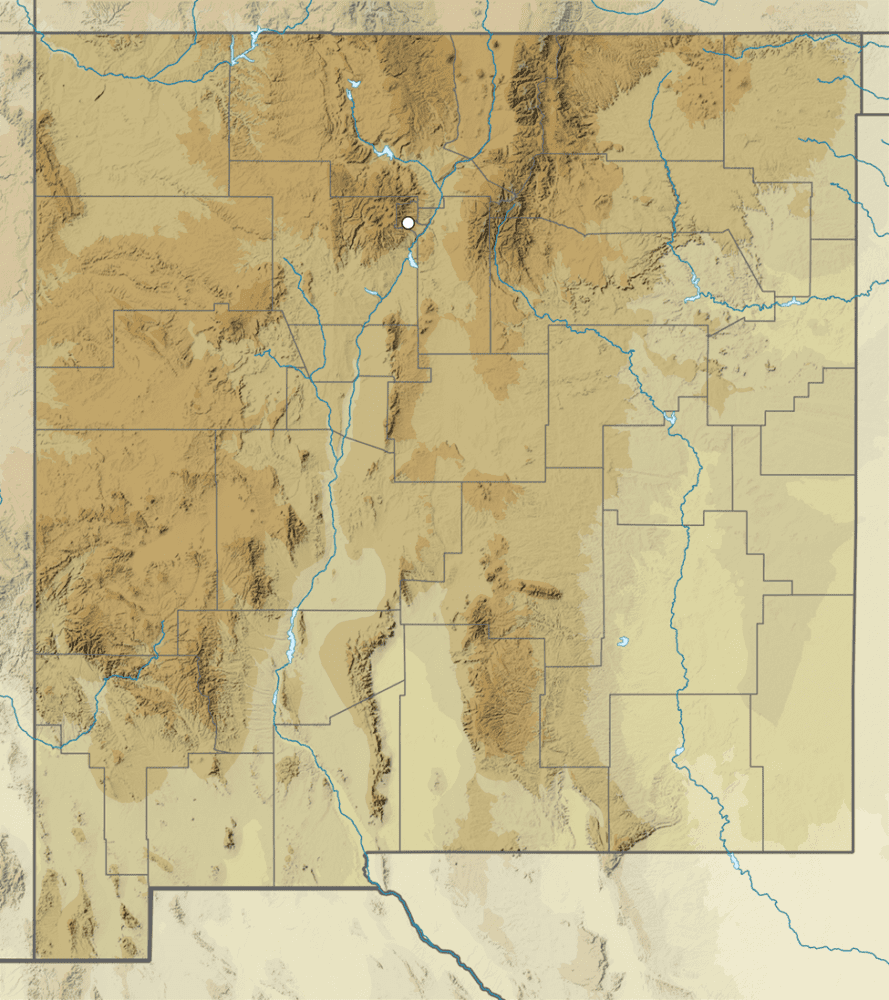
Arawacus jada (Hewitson, 1867) Creamy Stripe-streak (added July 28, 2024)
Description. The Creamy Stripe-streak is very distinctive, given the combination of a brilliant iridescent blue upperside and a striped underside (thus the name “Stripe-streak”). The upper surface of both males and females has that brilliant blue, and the apex of the front wing is extensively colored with brown (males) to brown-black (females). Females often have a dark bar at the end of the forewing cell. Beneath, both sexes show that characteristic striped pattern, pale brown on a creamy yellow background. Females may have a darker ground color and stripes. Range and Habitat. The normal range is from Central America through Mexico. Recently, there have been relatively frequent reports of this species in Arizona (Bailowitz & Brock 2021). Life History. Larvae of Creamy Stripe-streak feed on Solanum umbellatum in the night-shade family (Solanaceae). Flight. In its native habitat, this species flies year-round. Arizona records range from mid-May to November. Comments. There are a number of records within 10 miles of our border with Arizona (Bailowitz & Brock 2021; iNaturalist), including a record from the Arizona side of Guadalupe Canyon. Visitors to the Bootheel region should be on the lookout for this critter.
